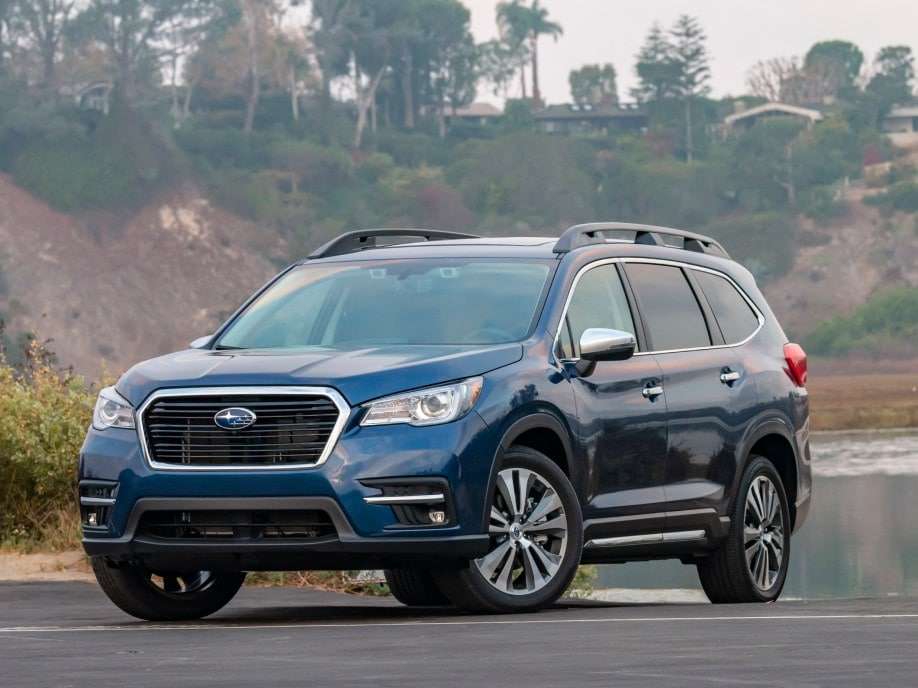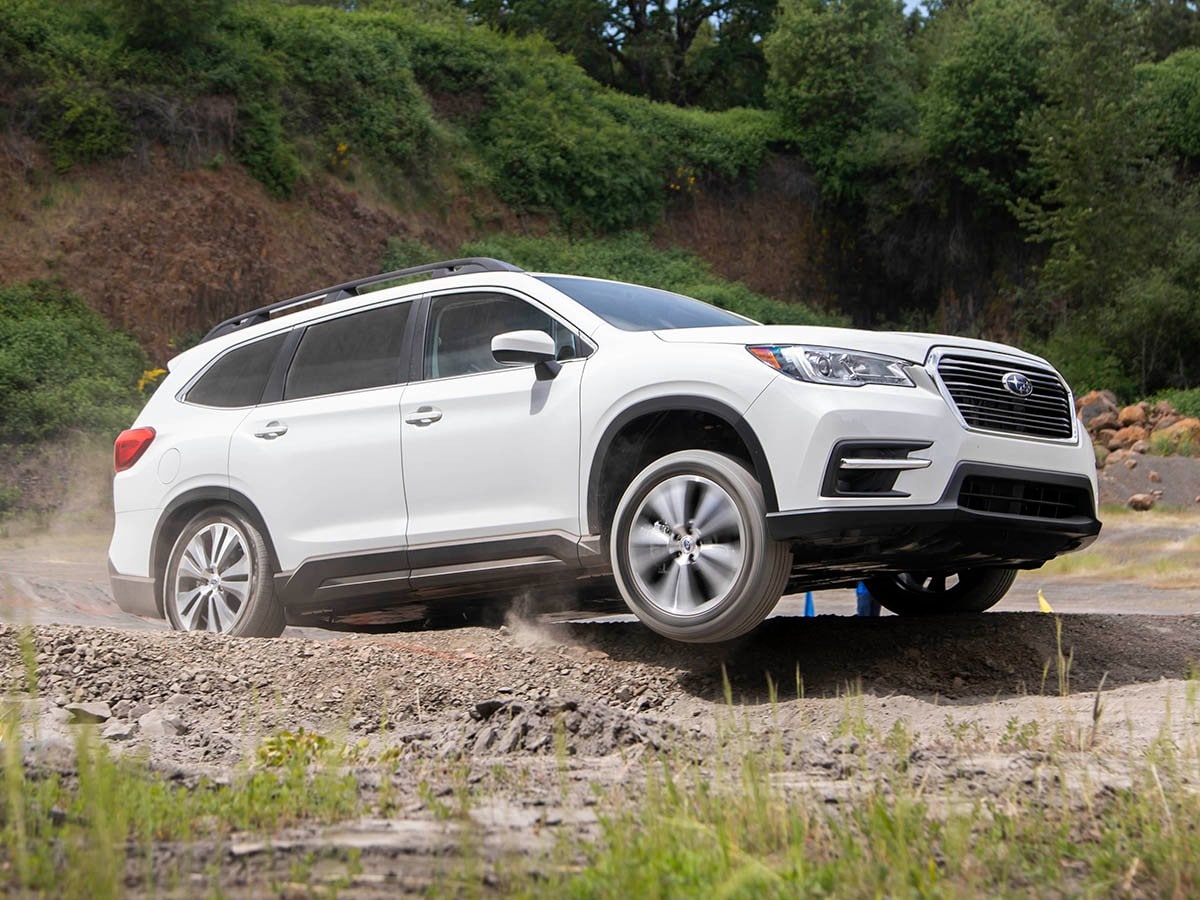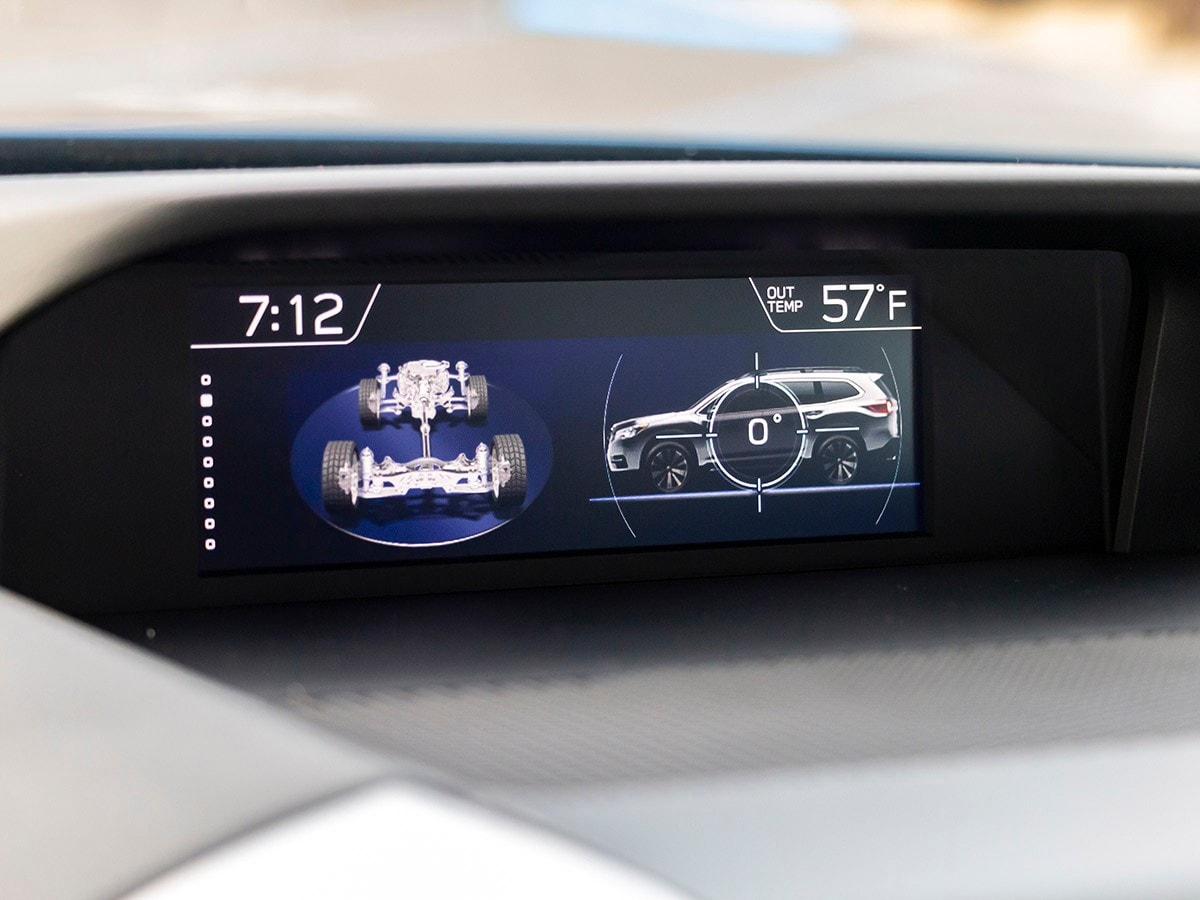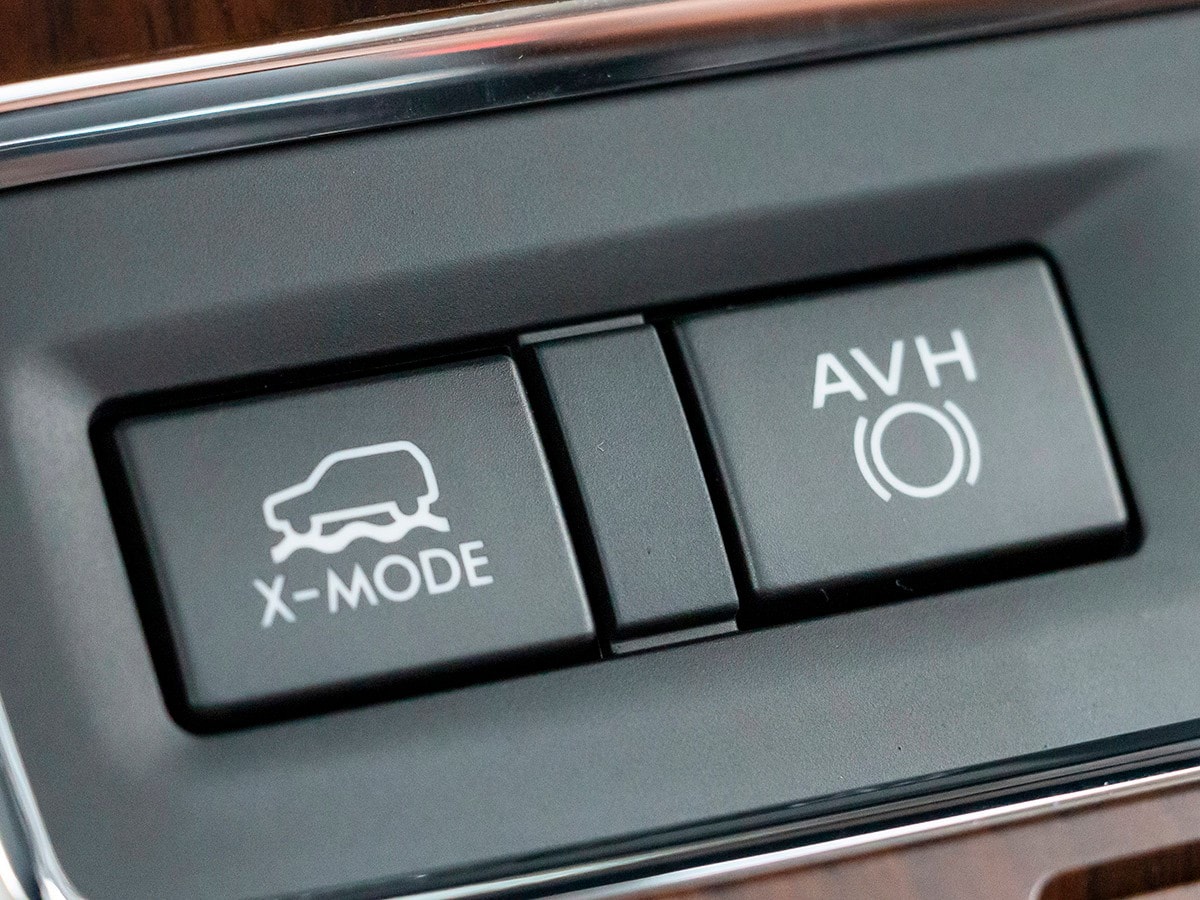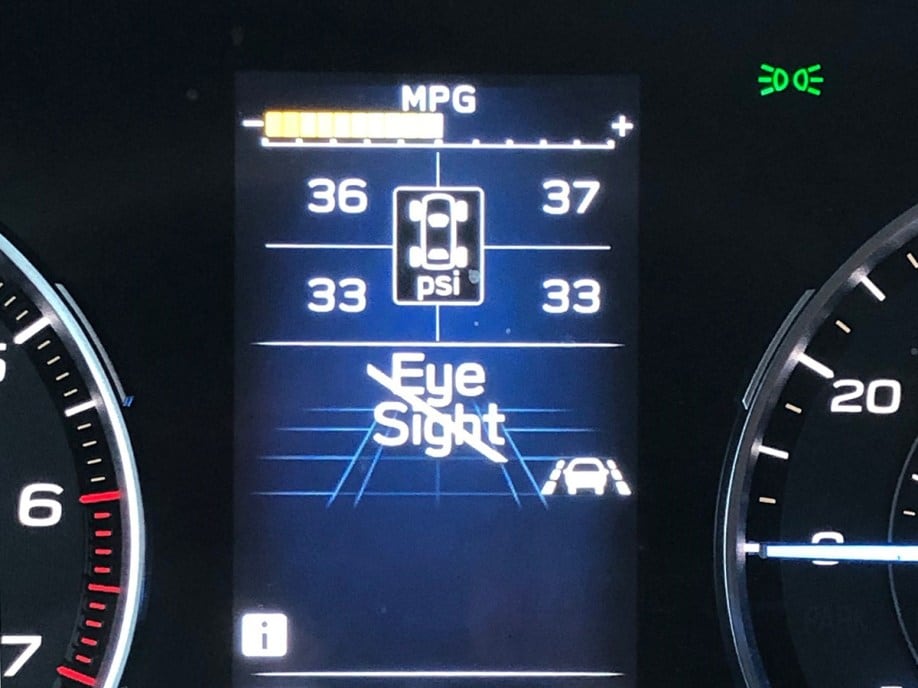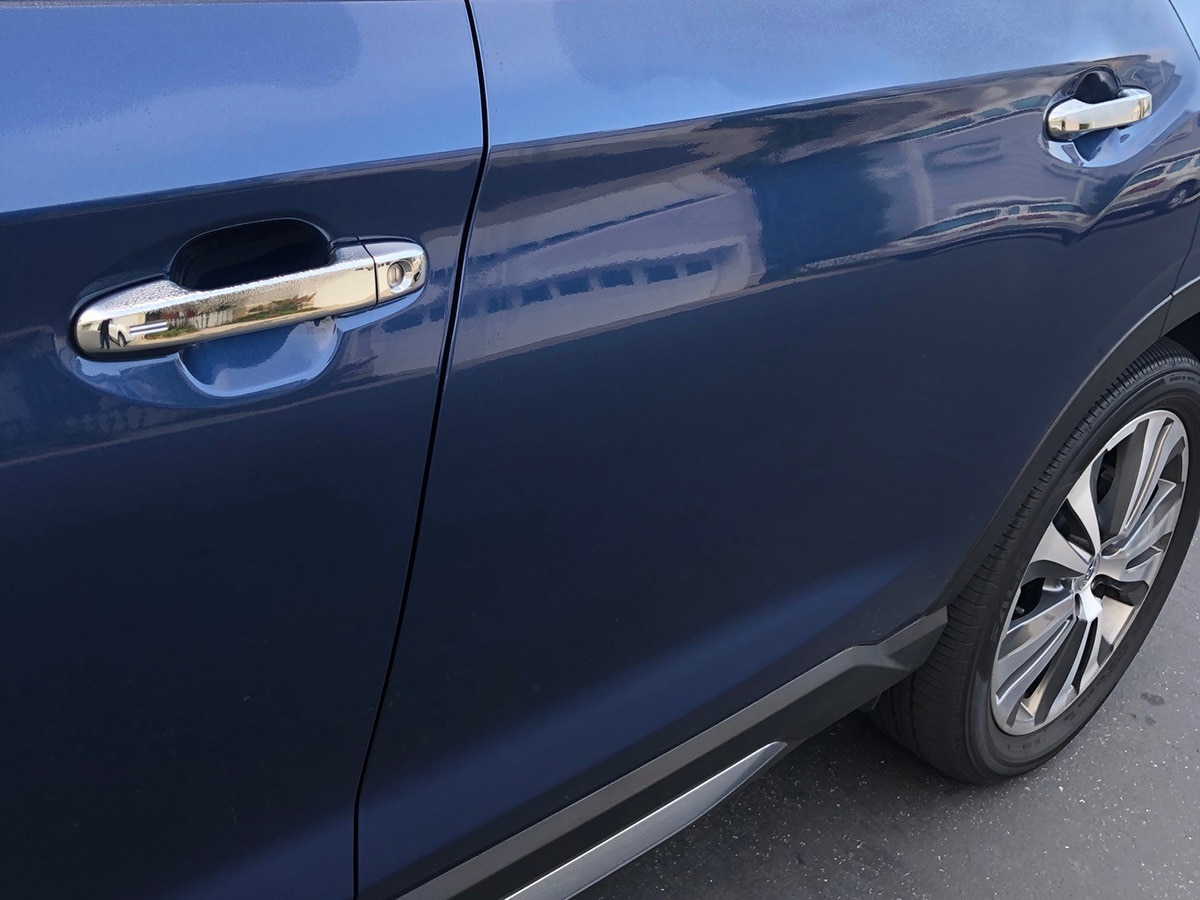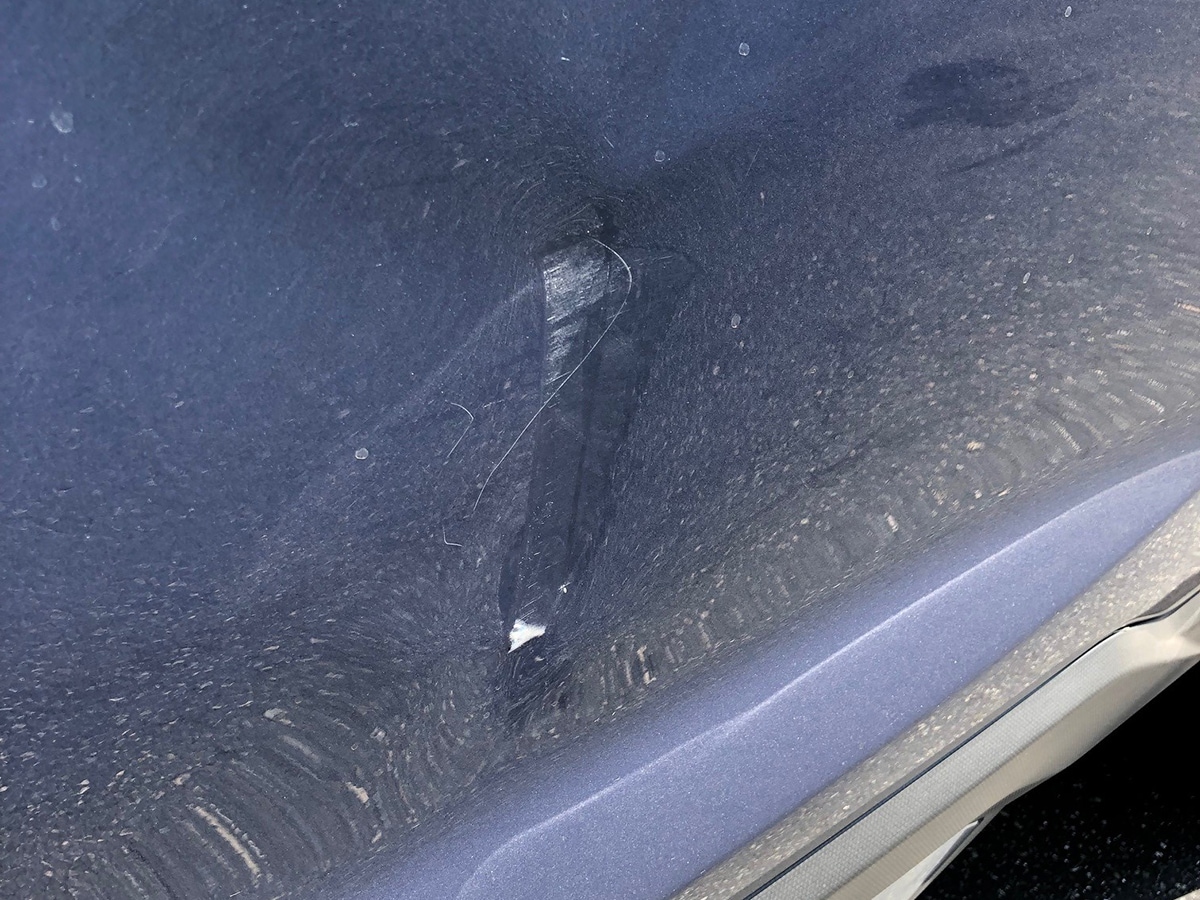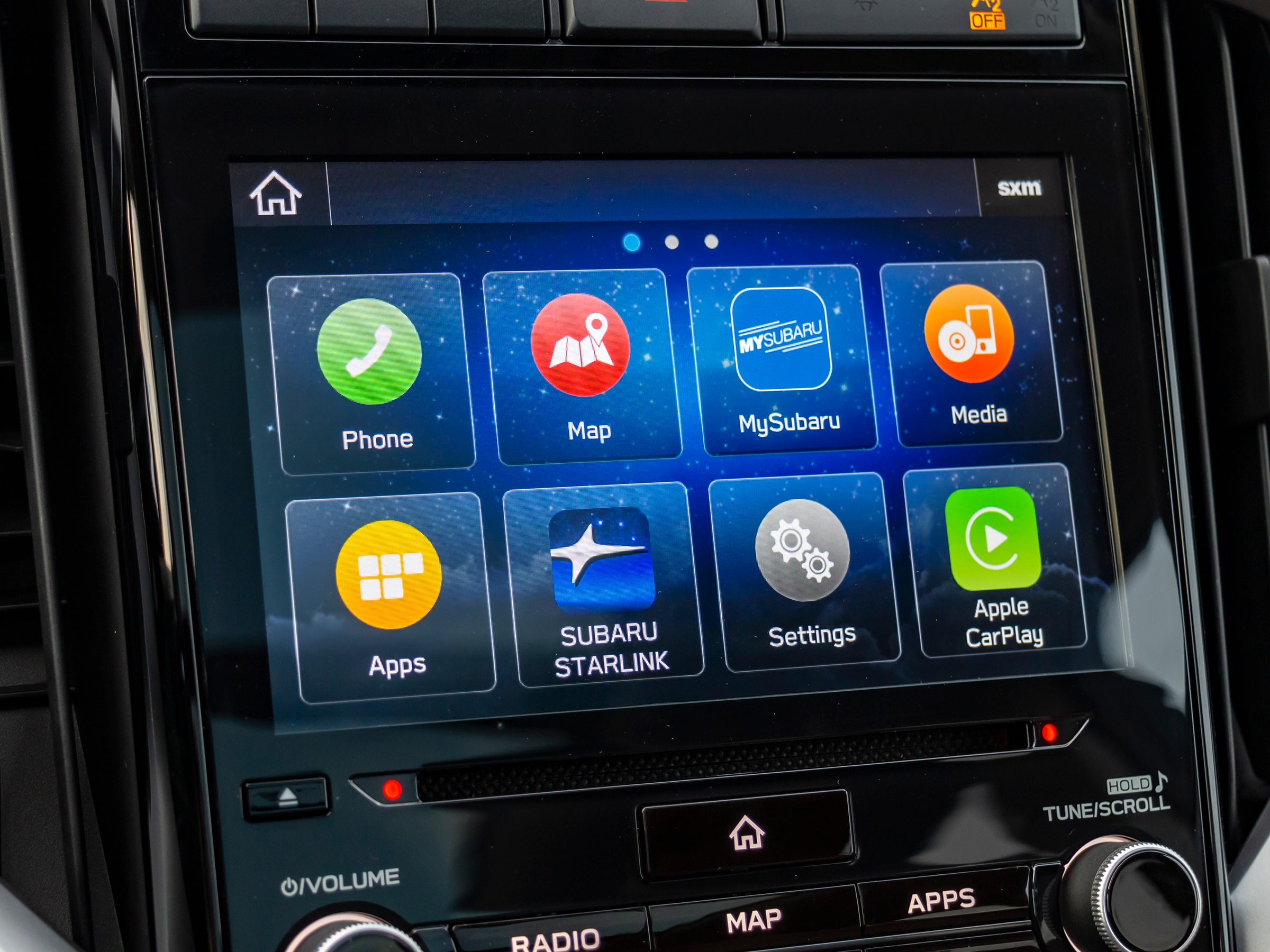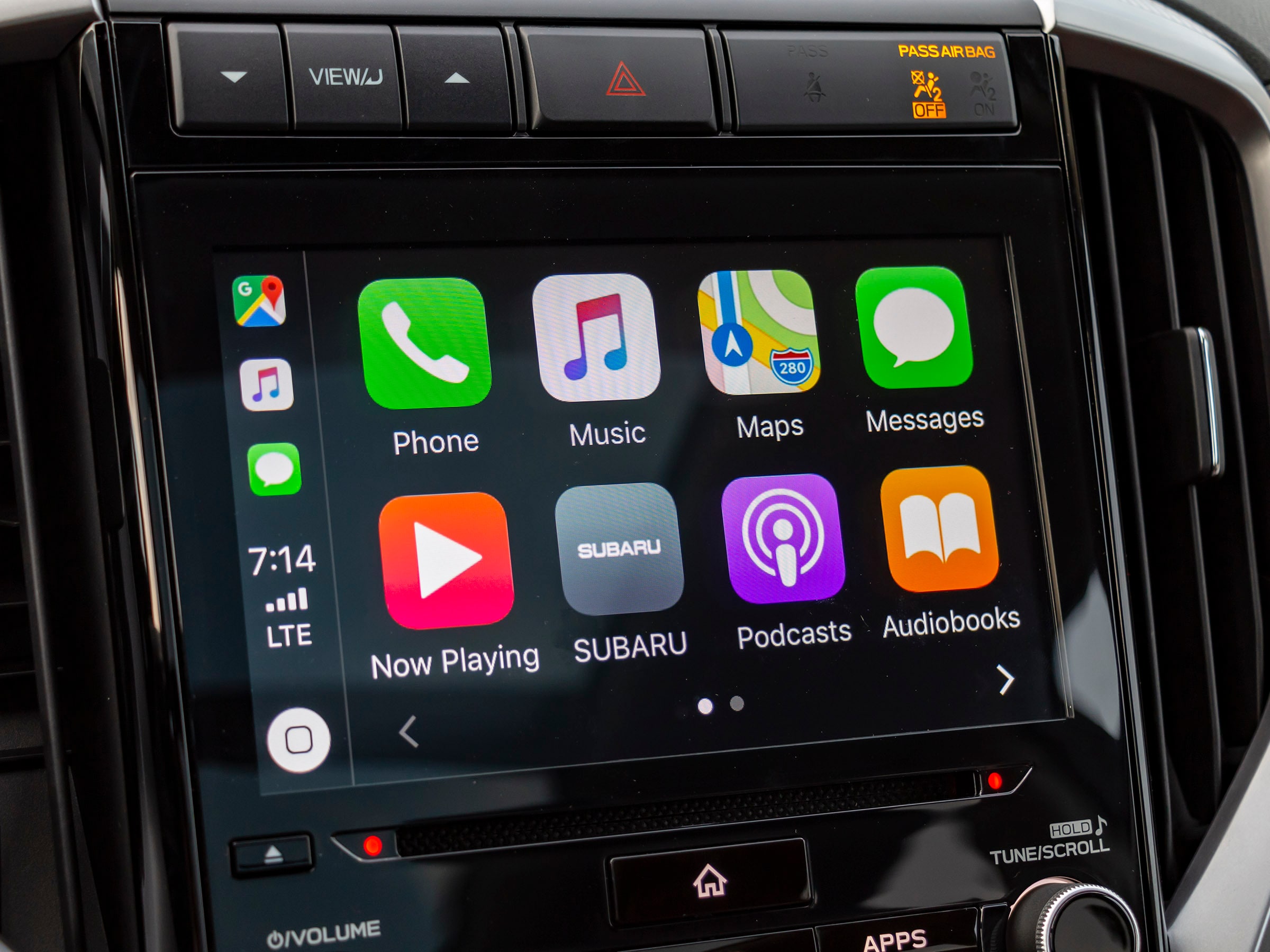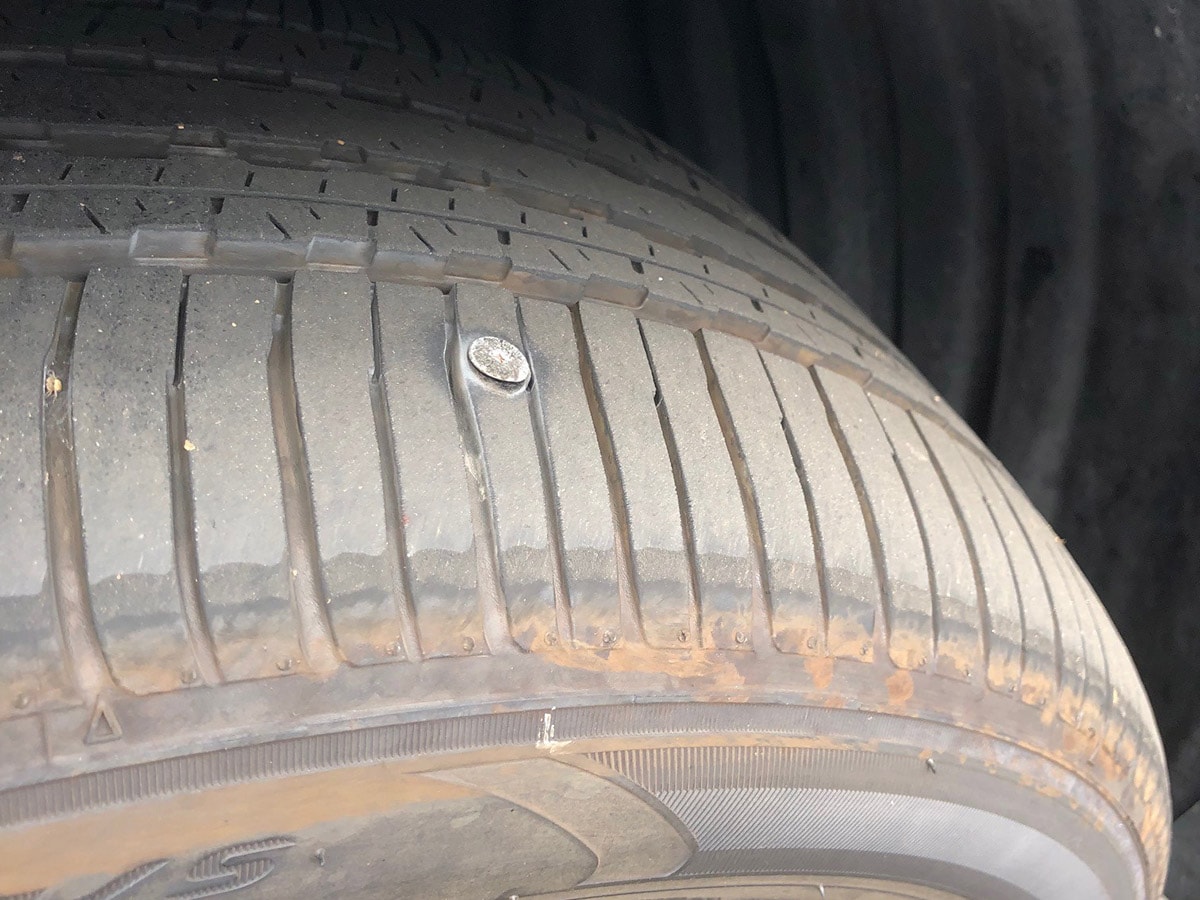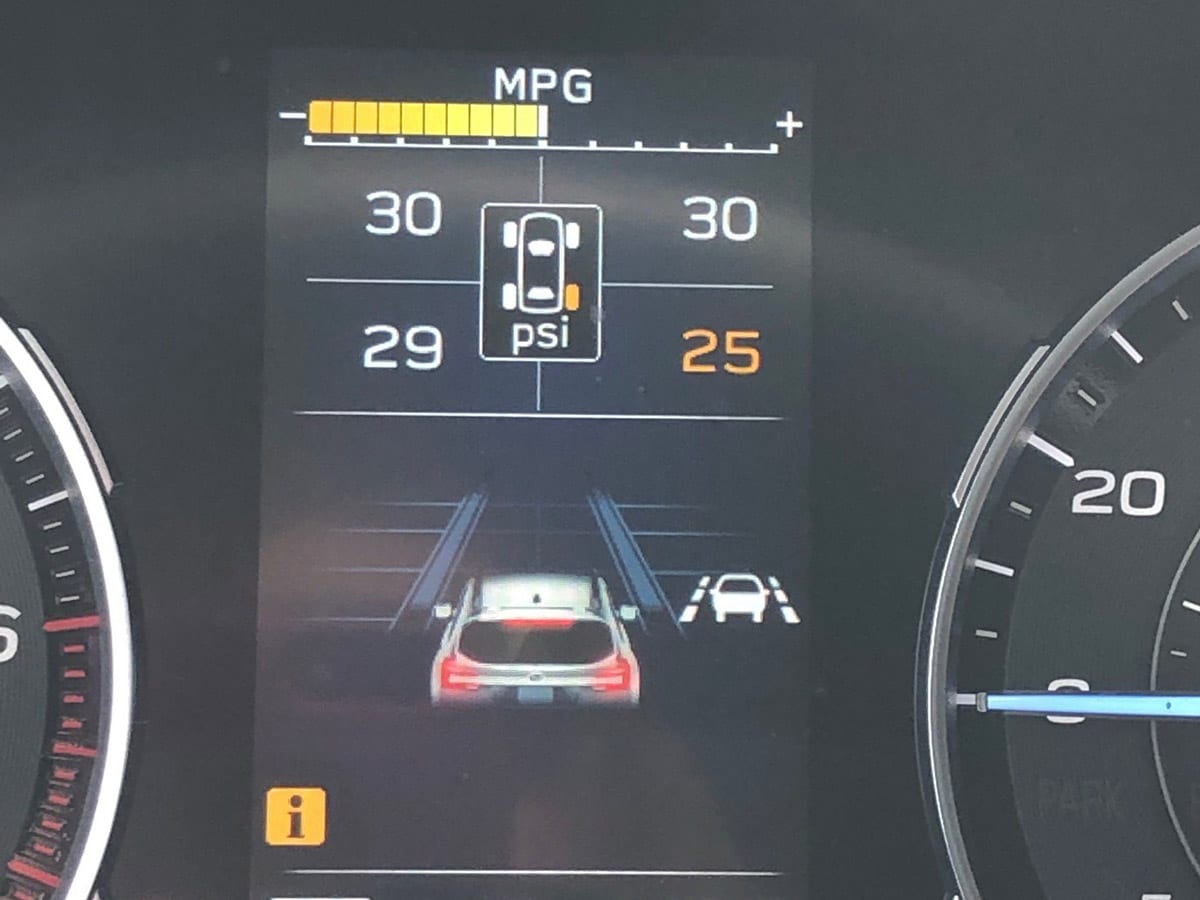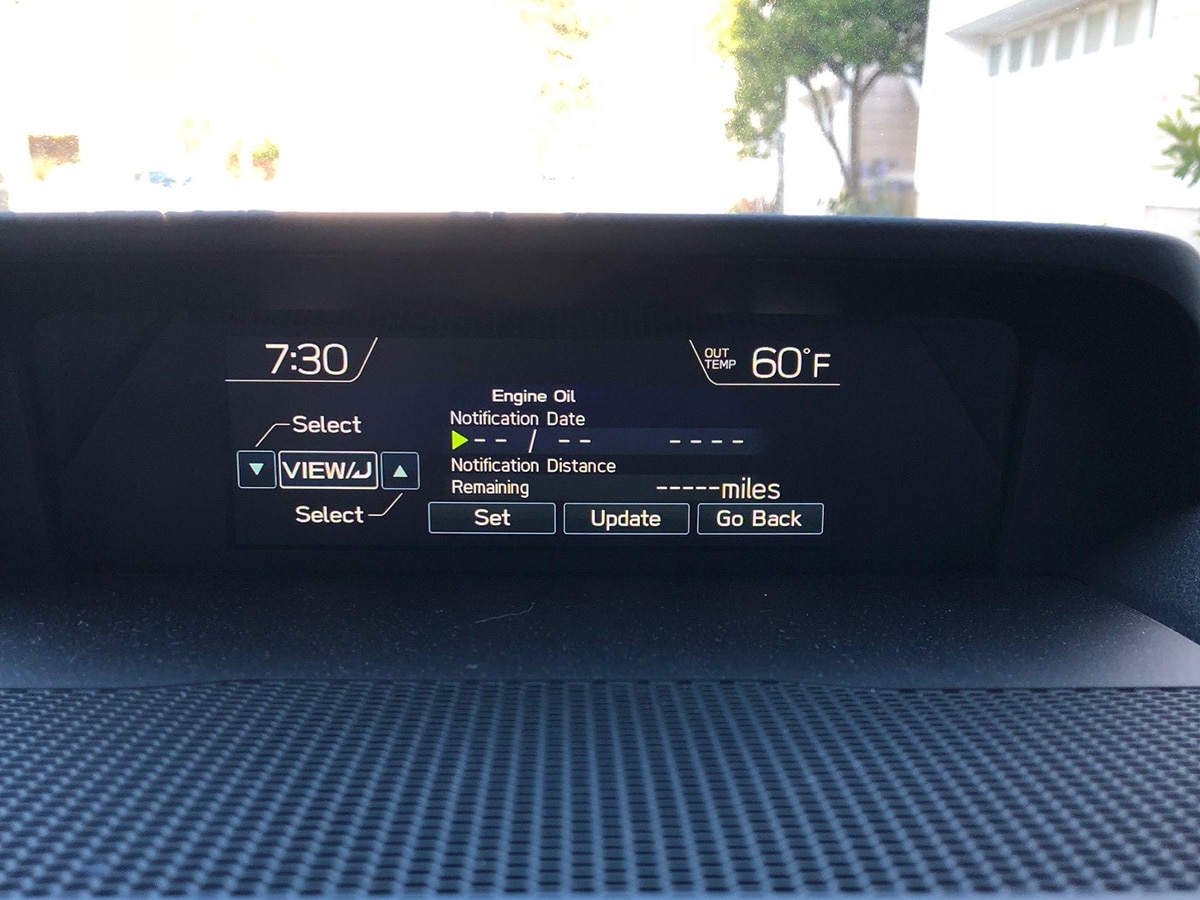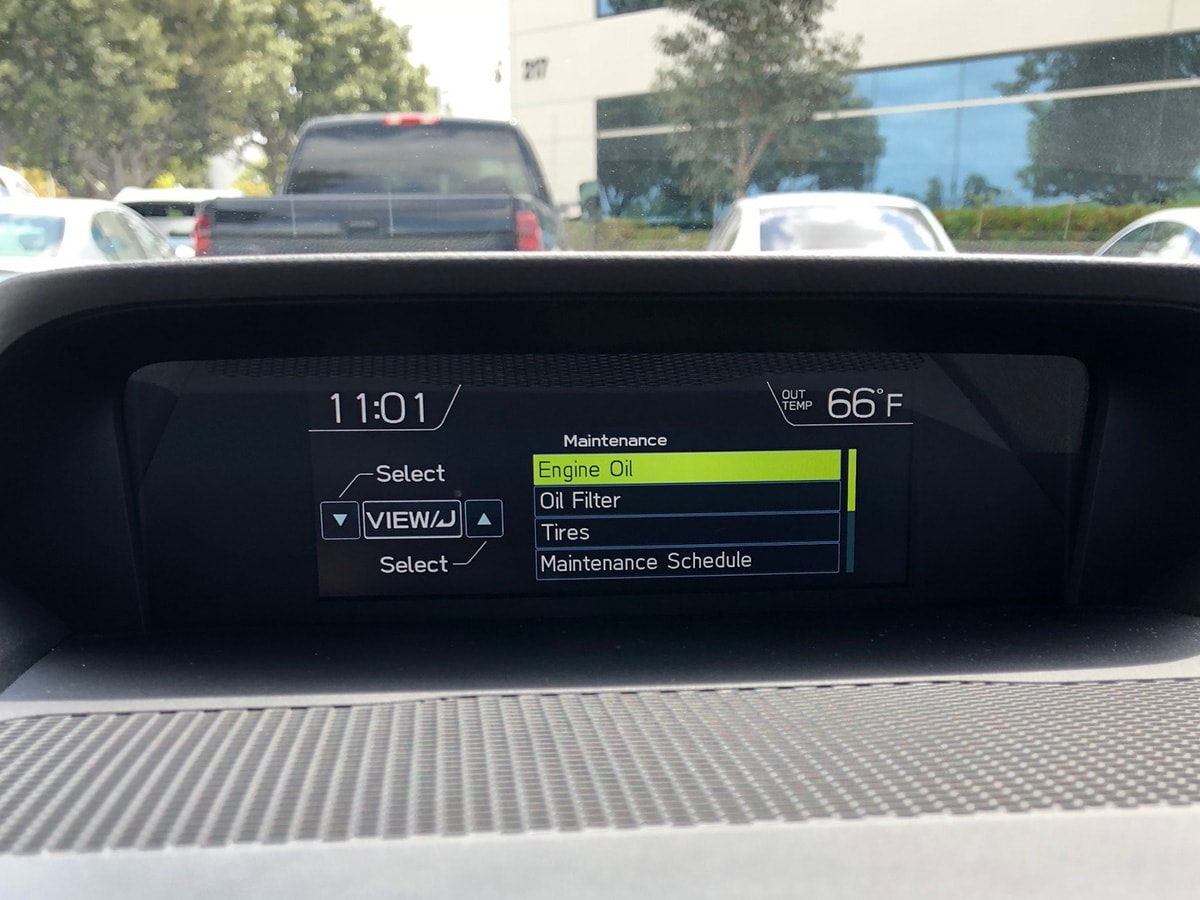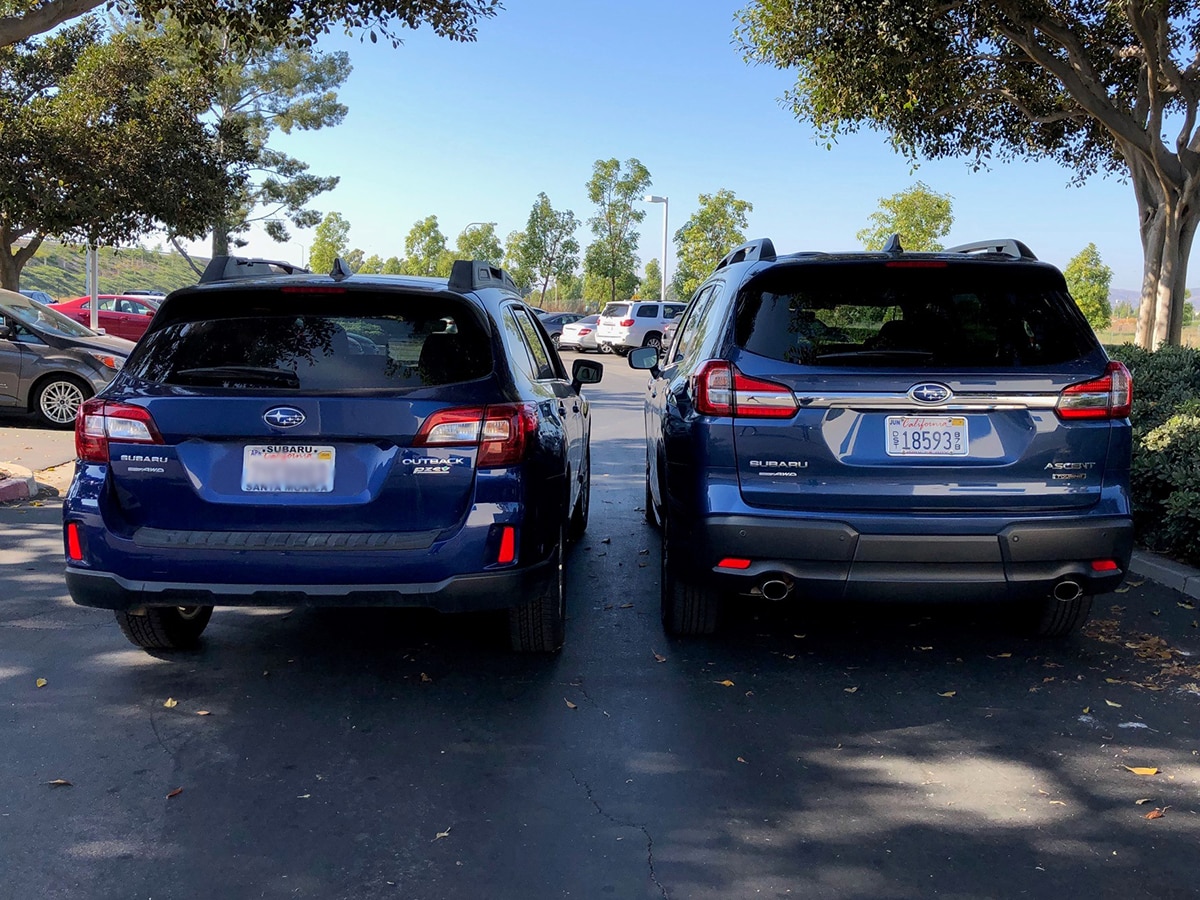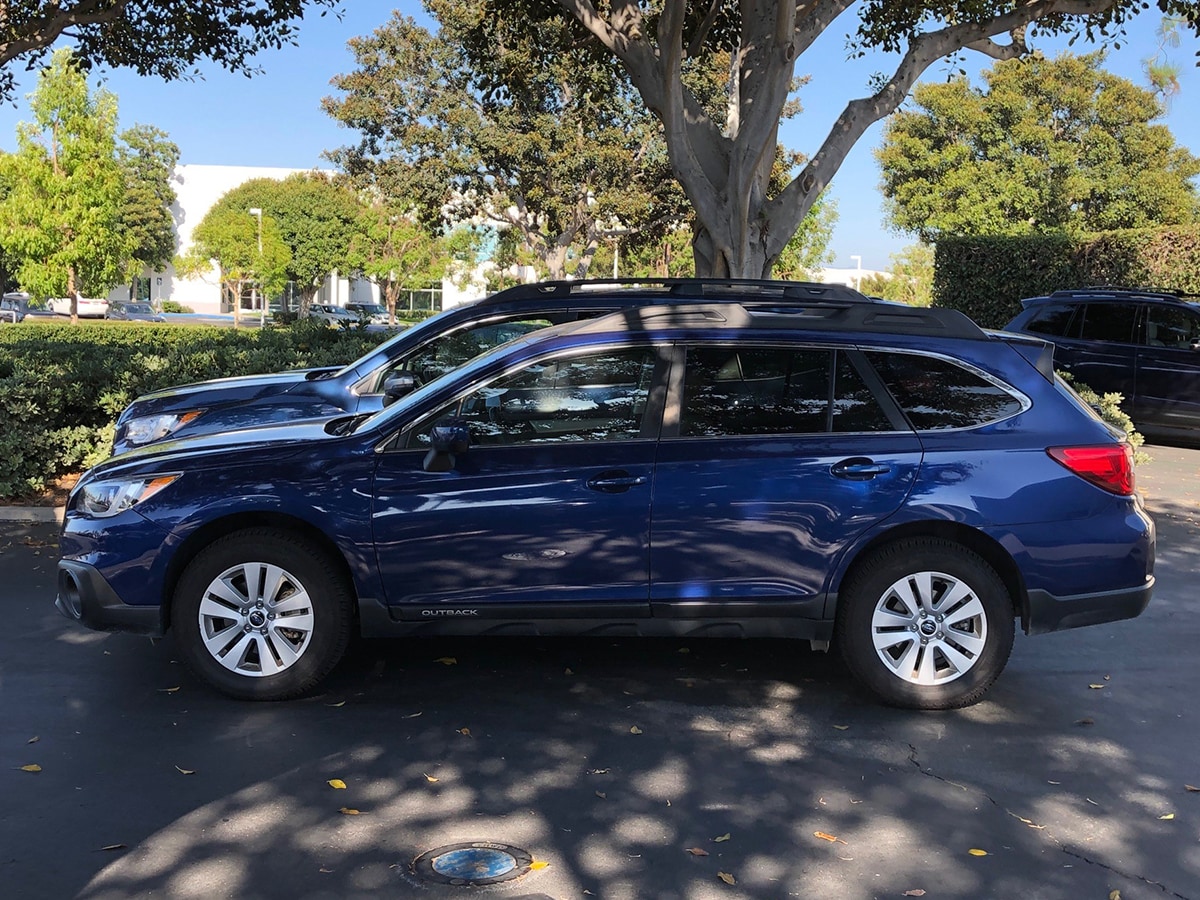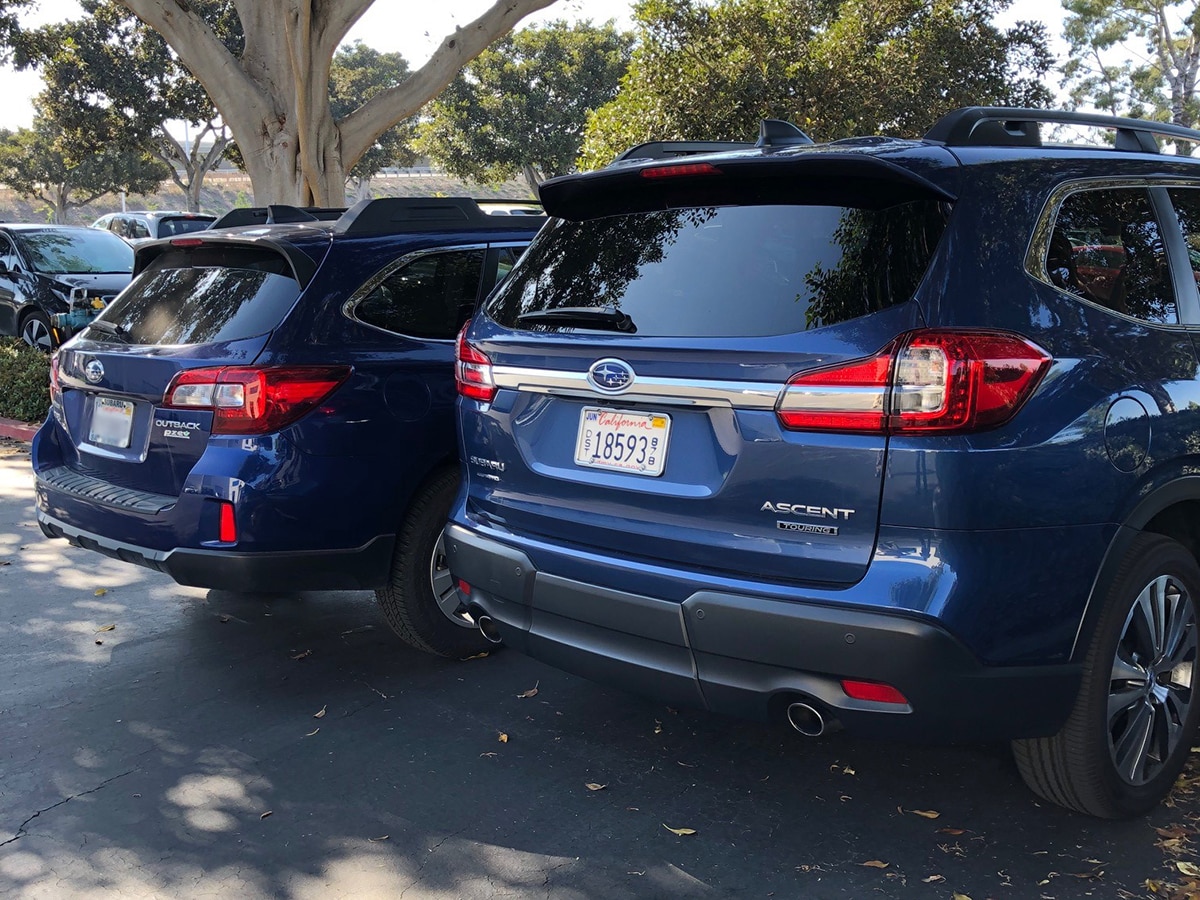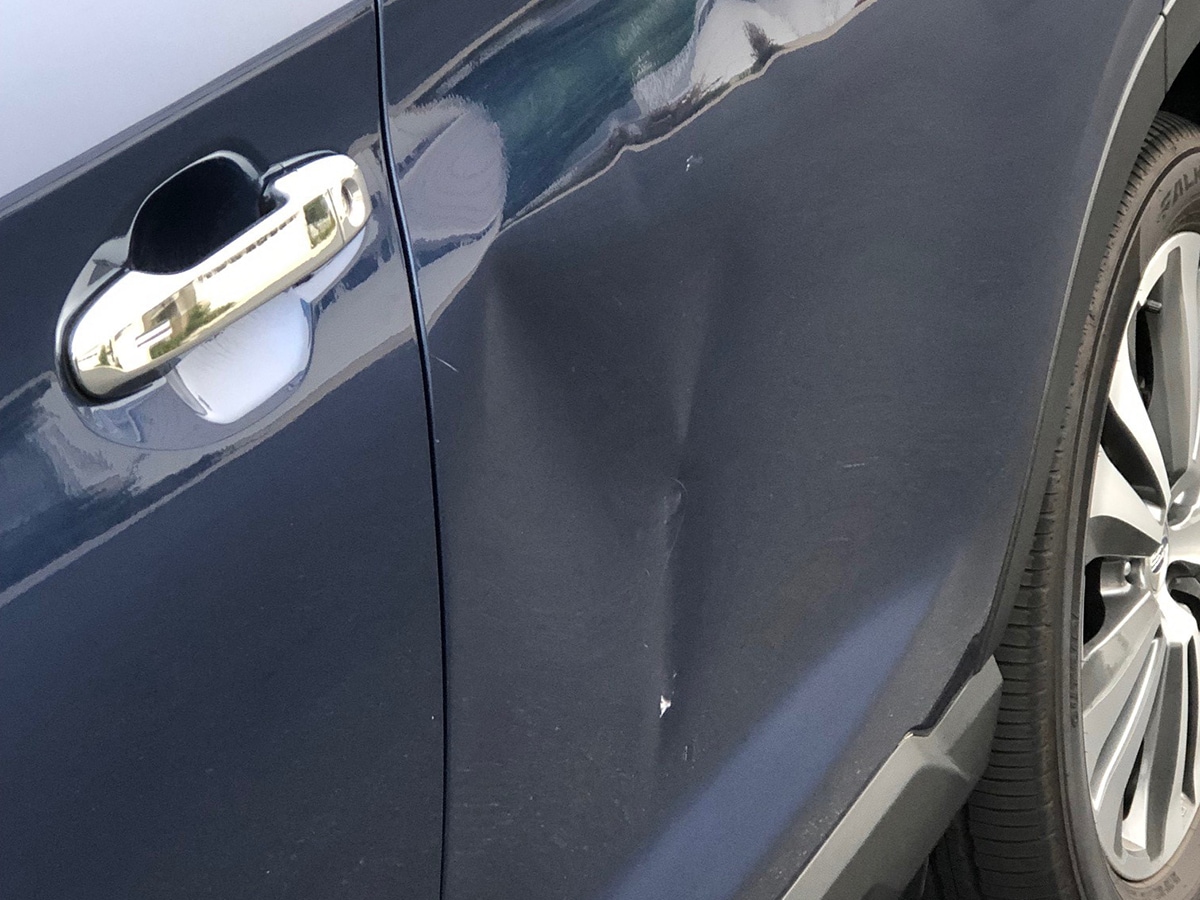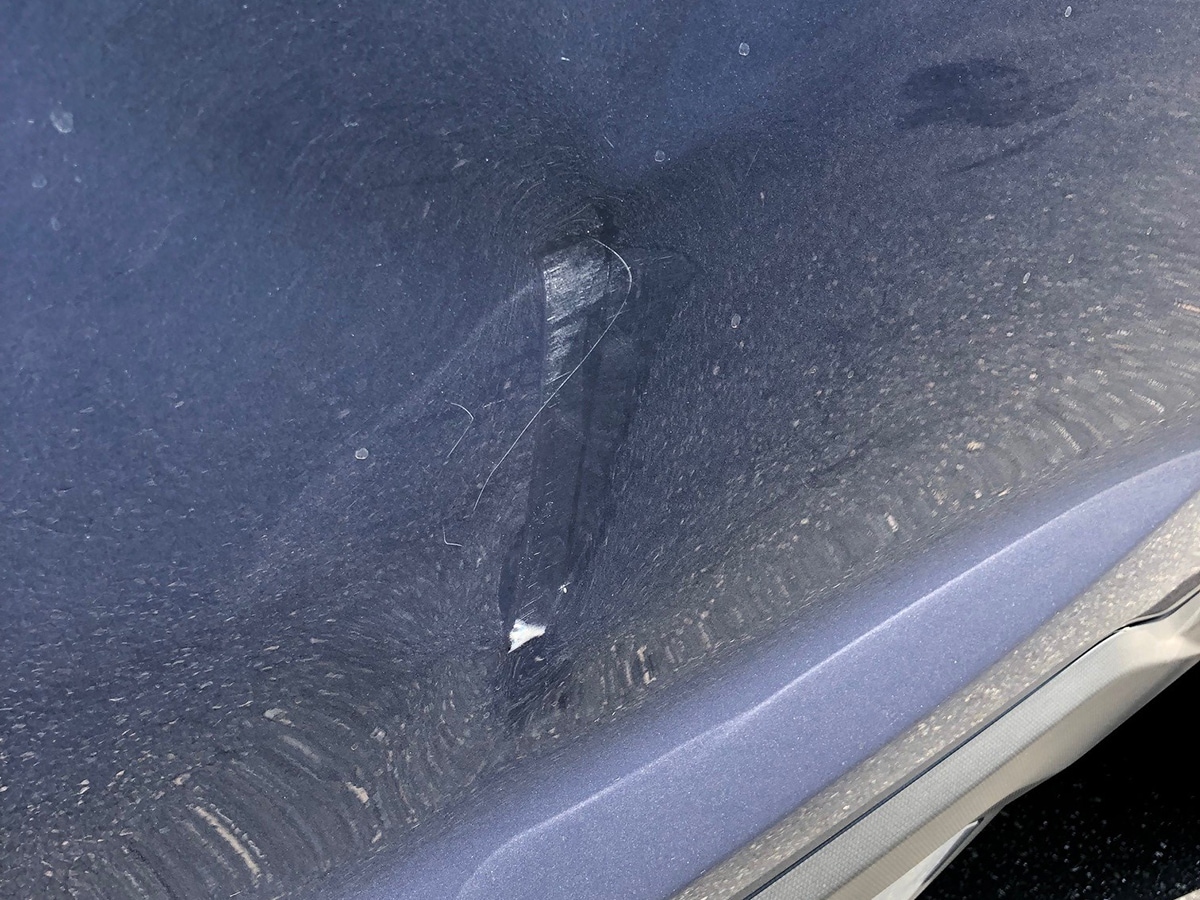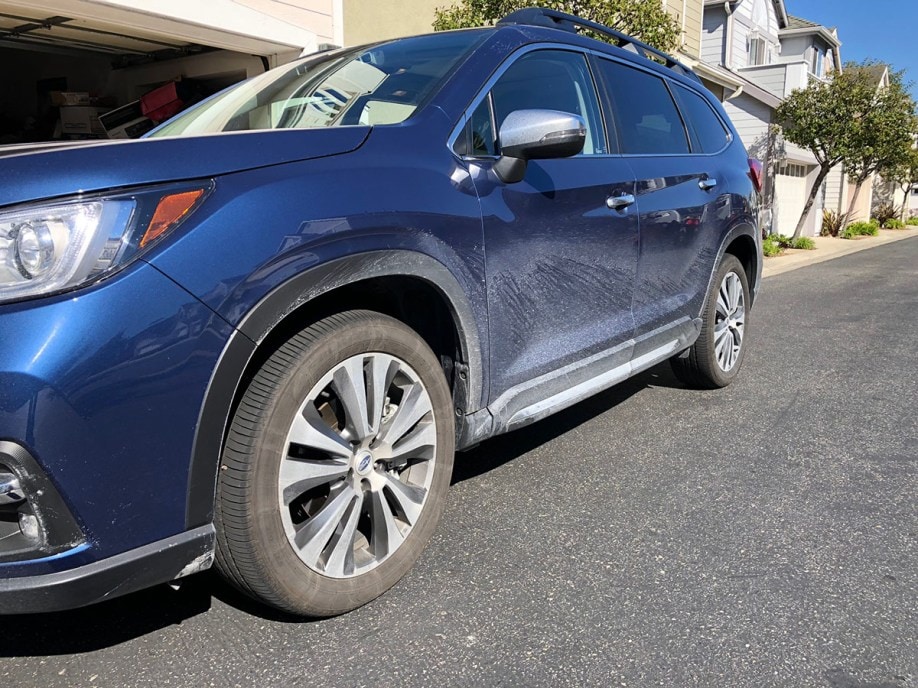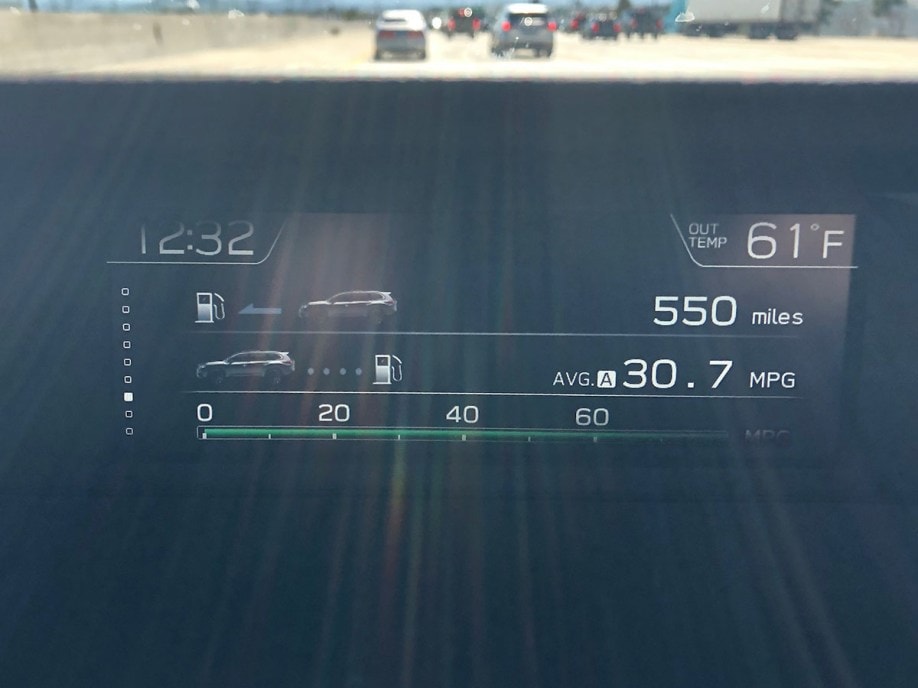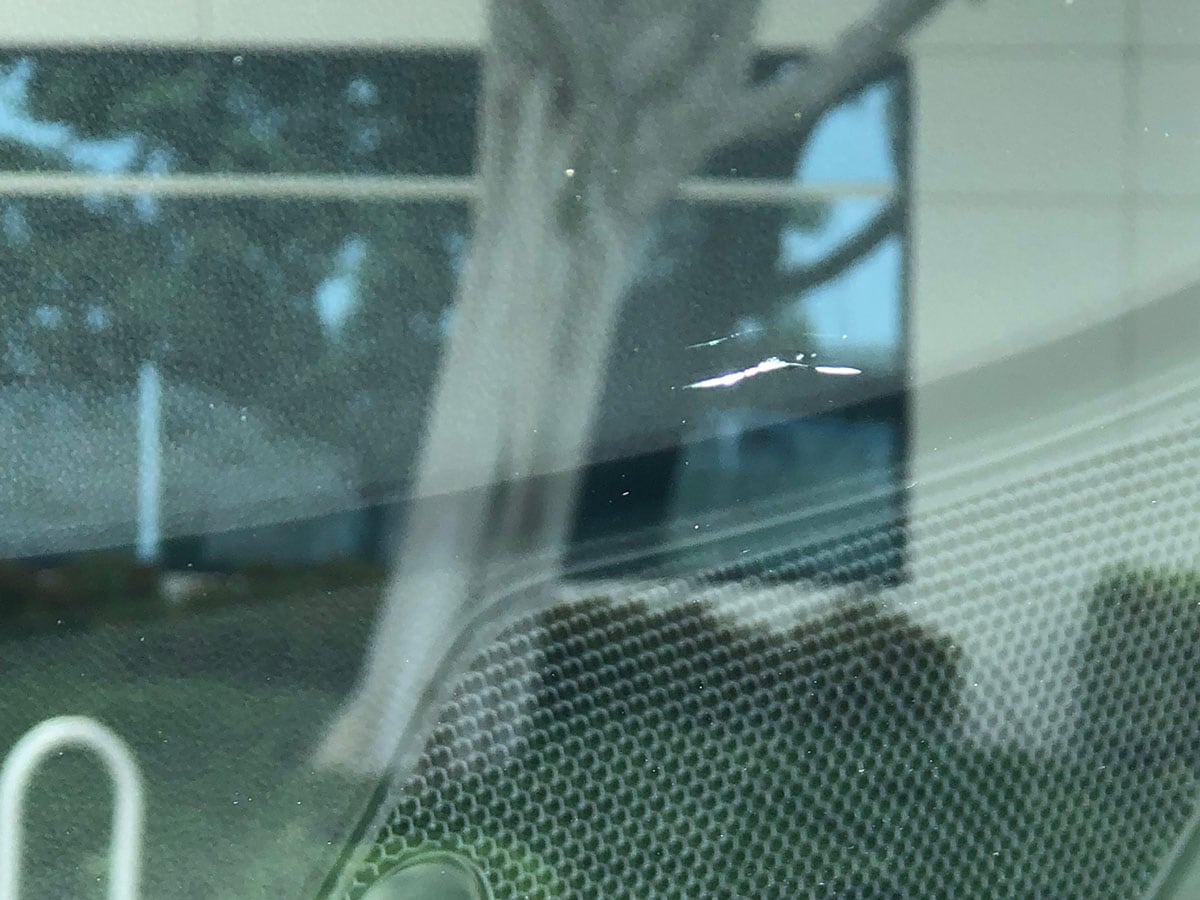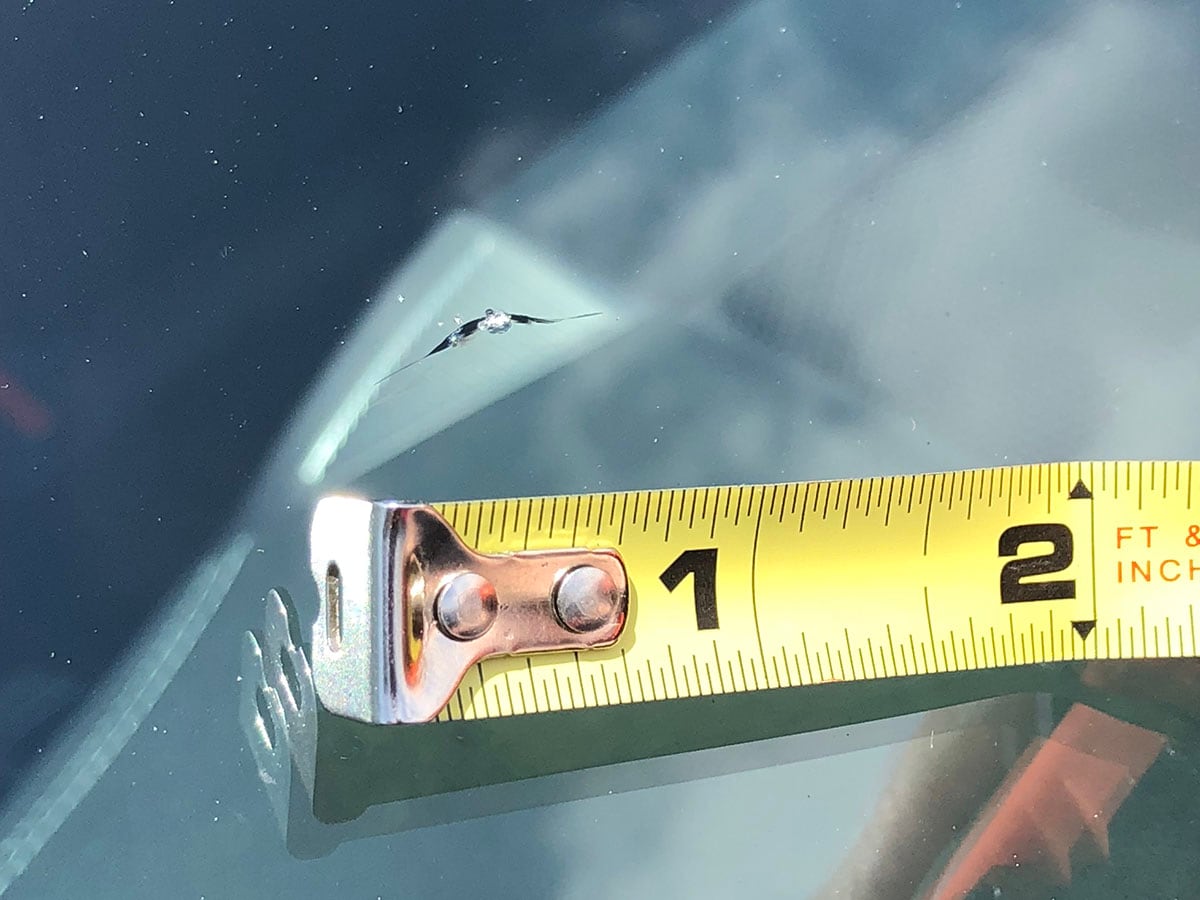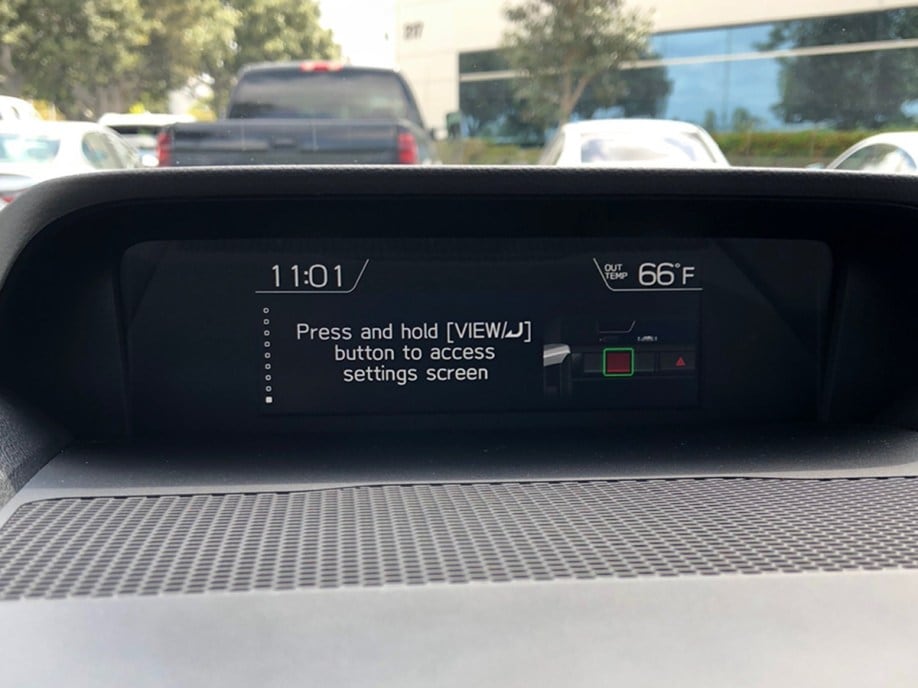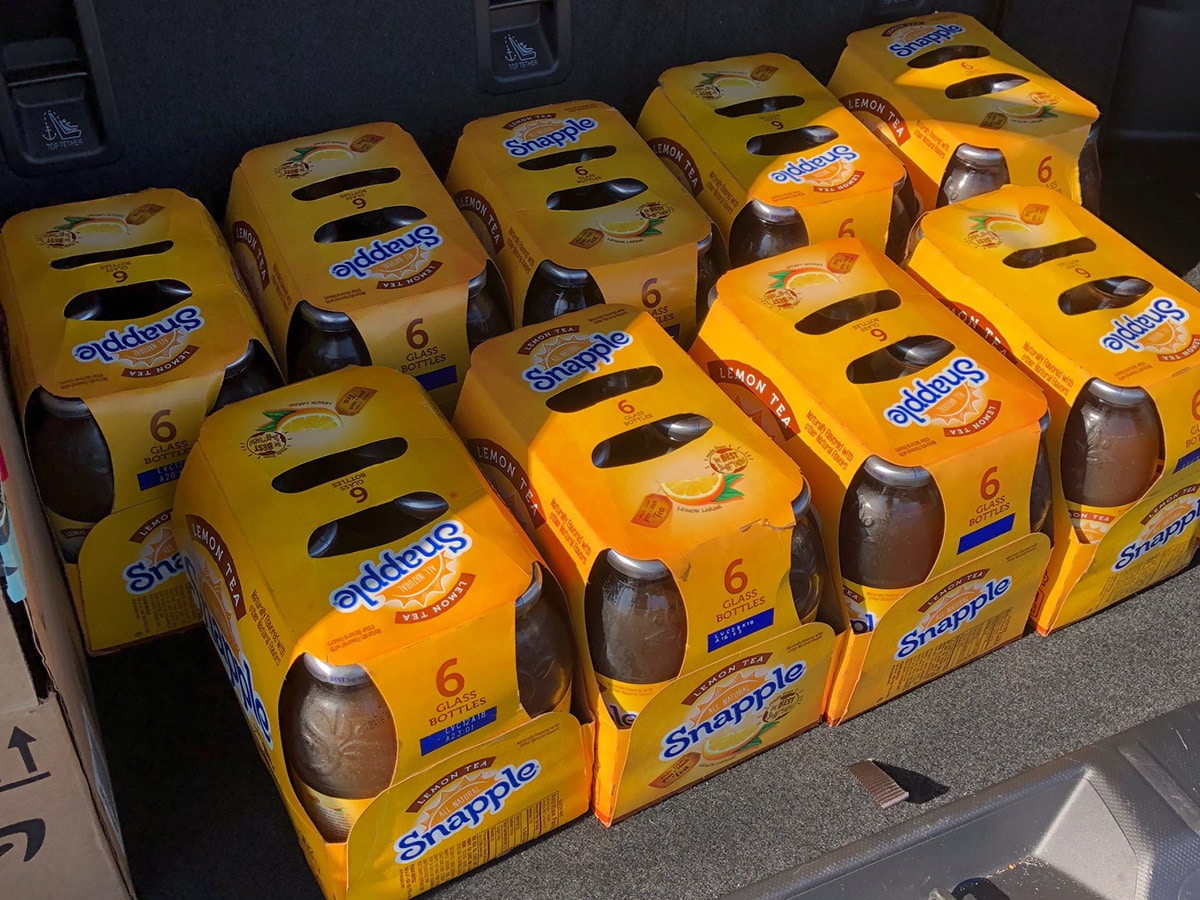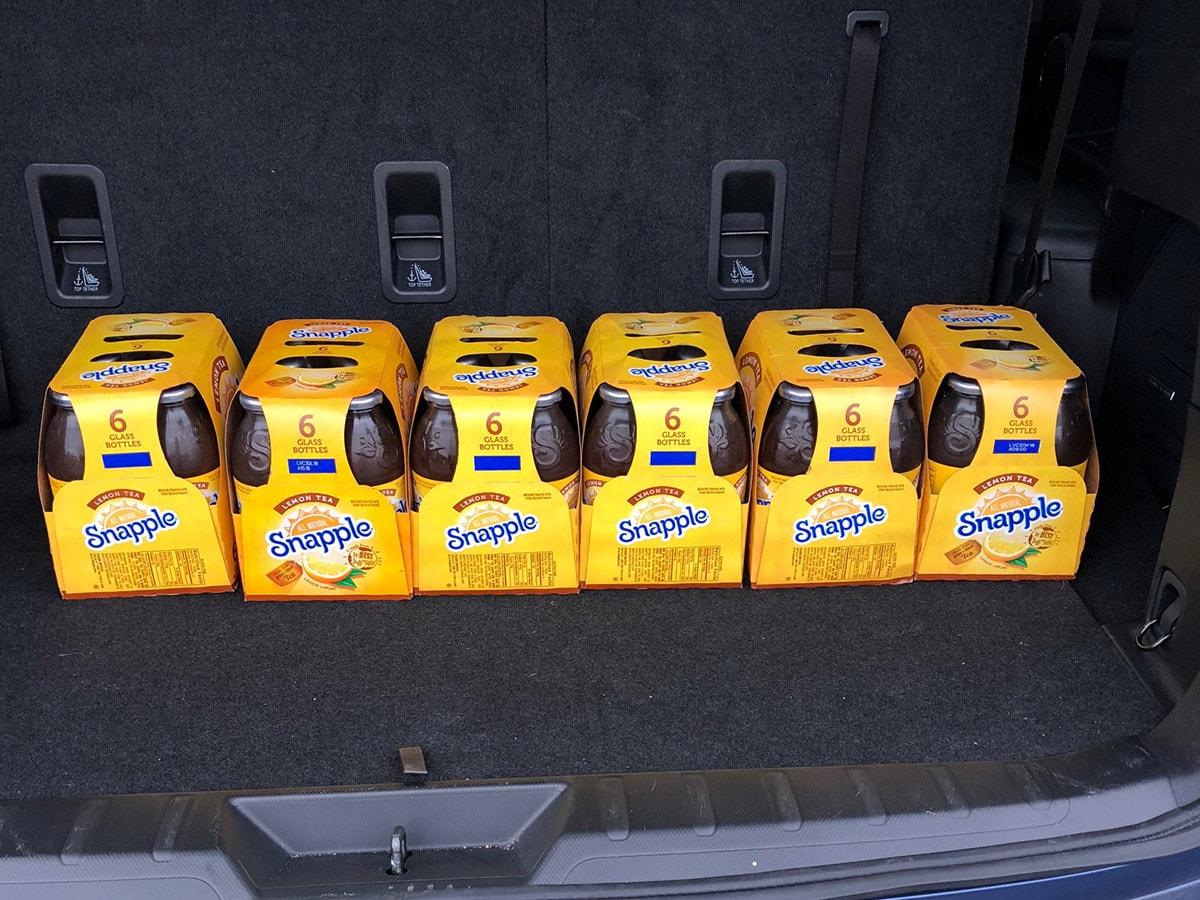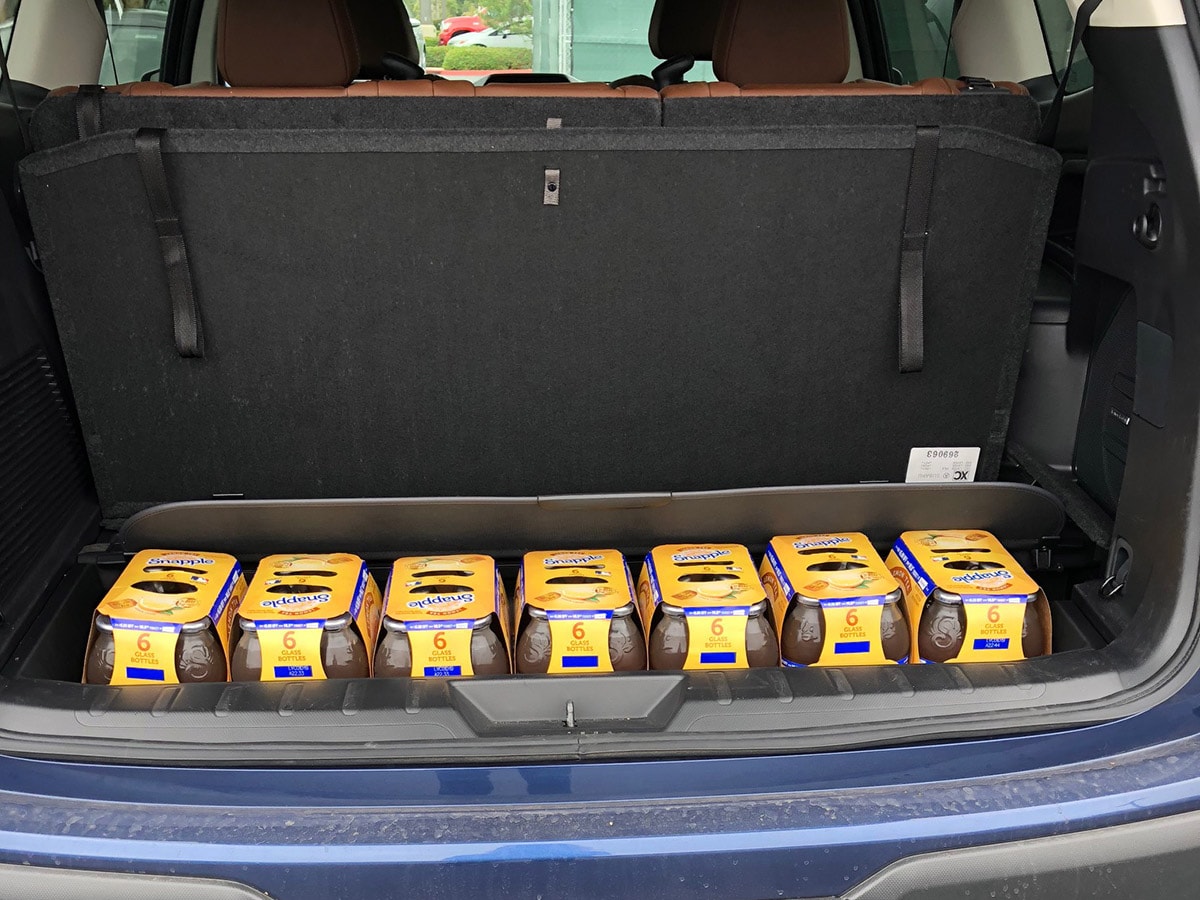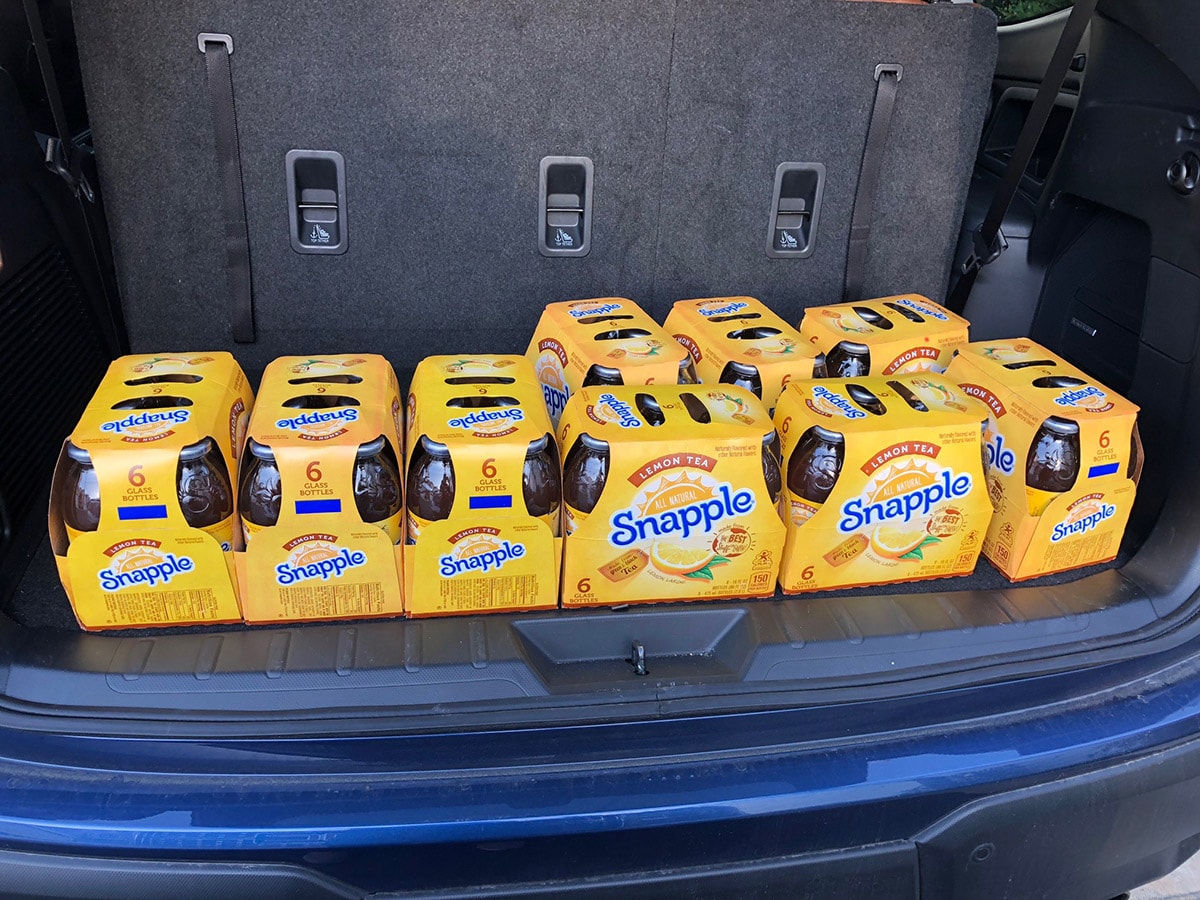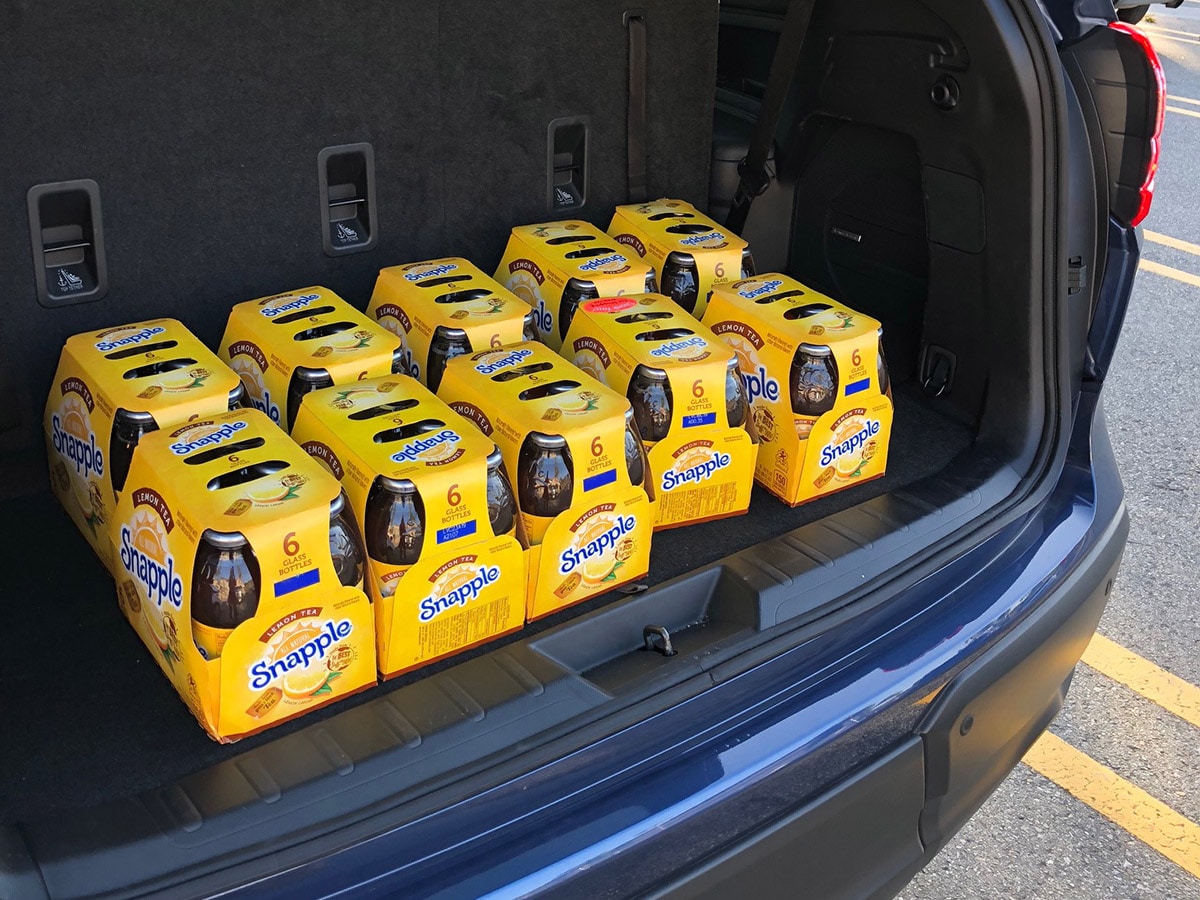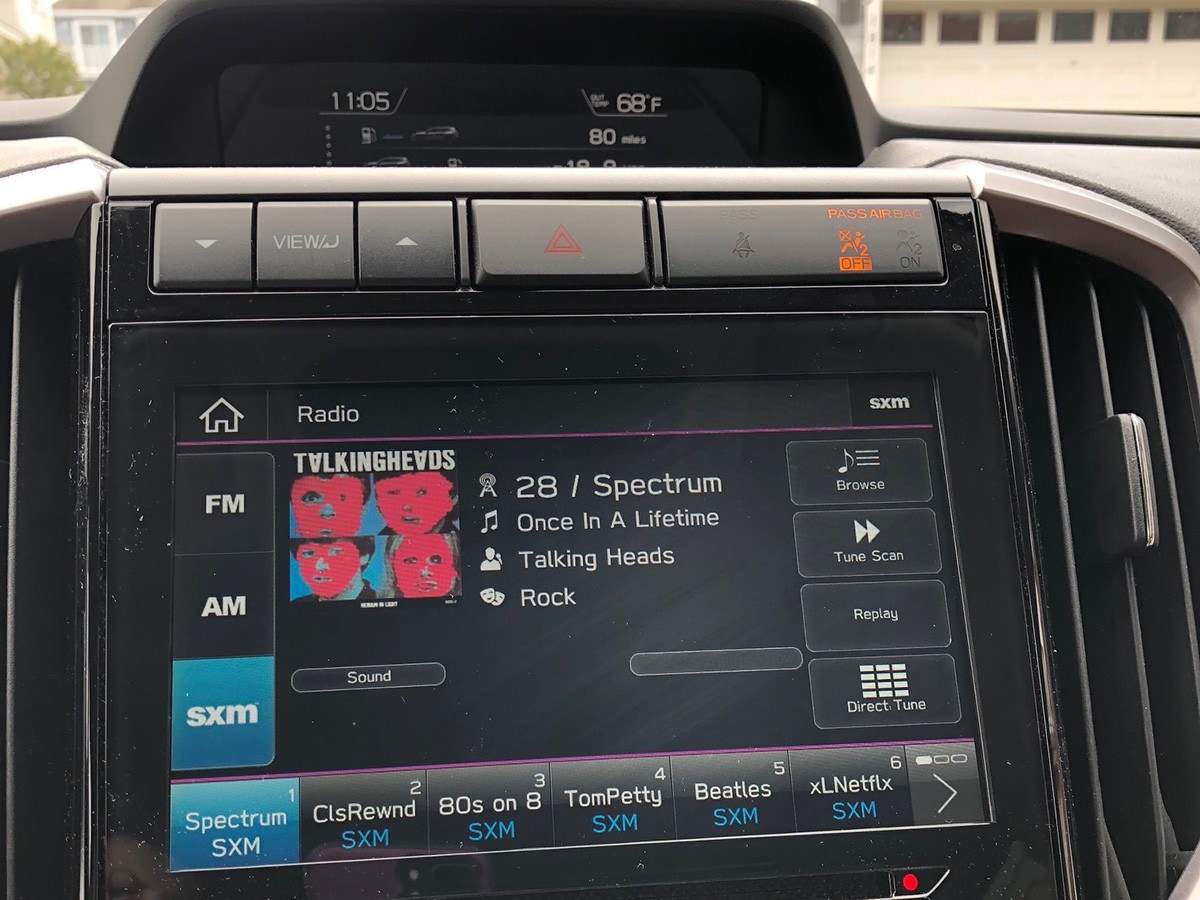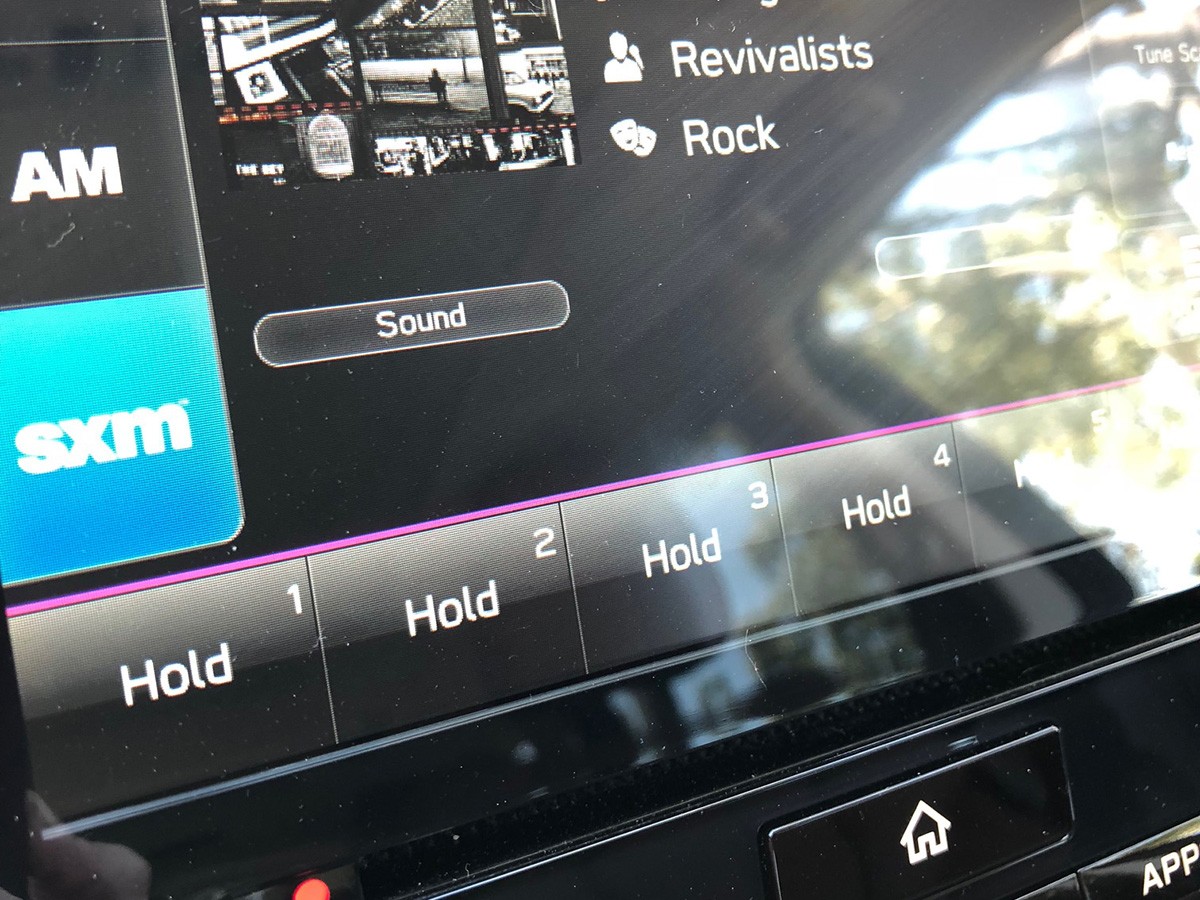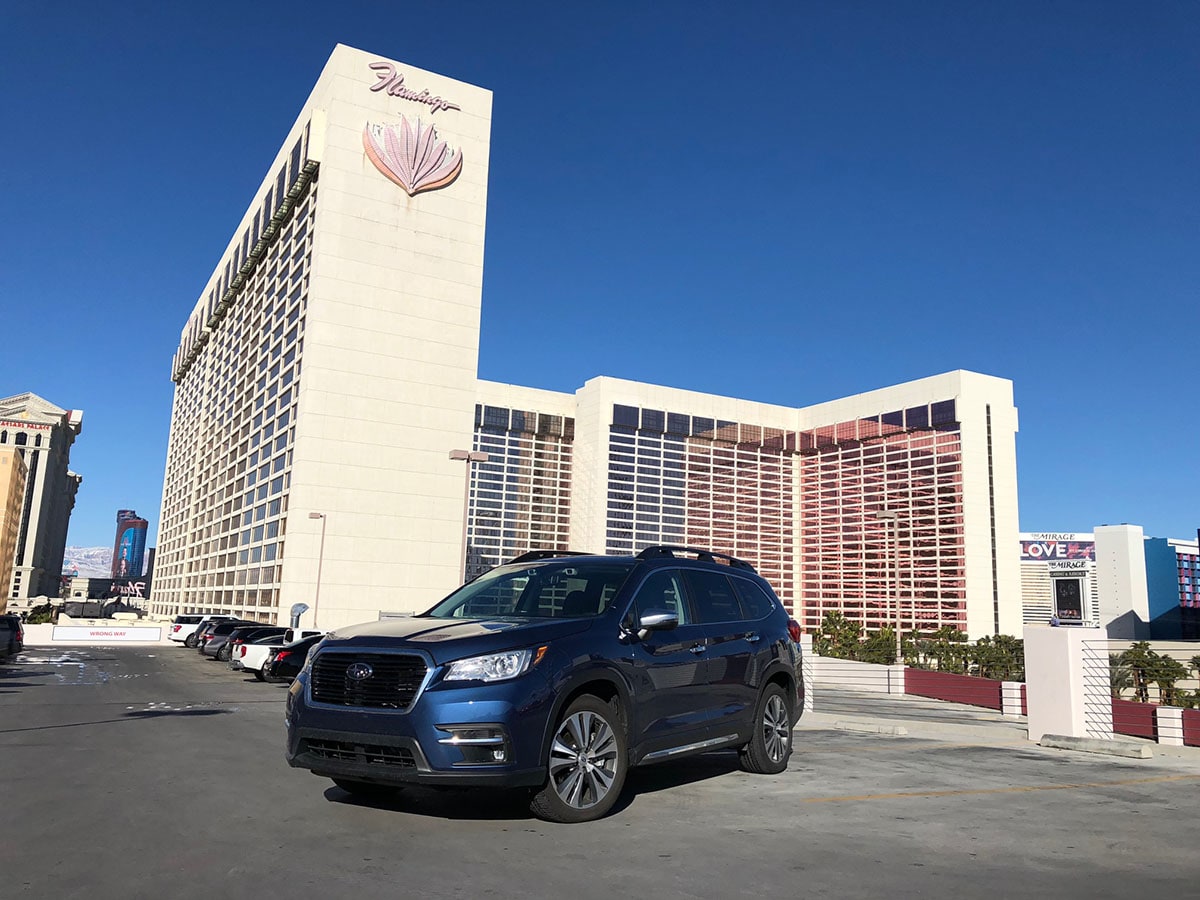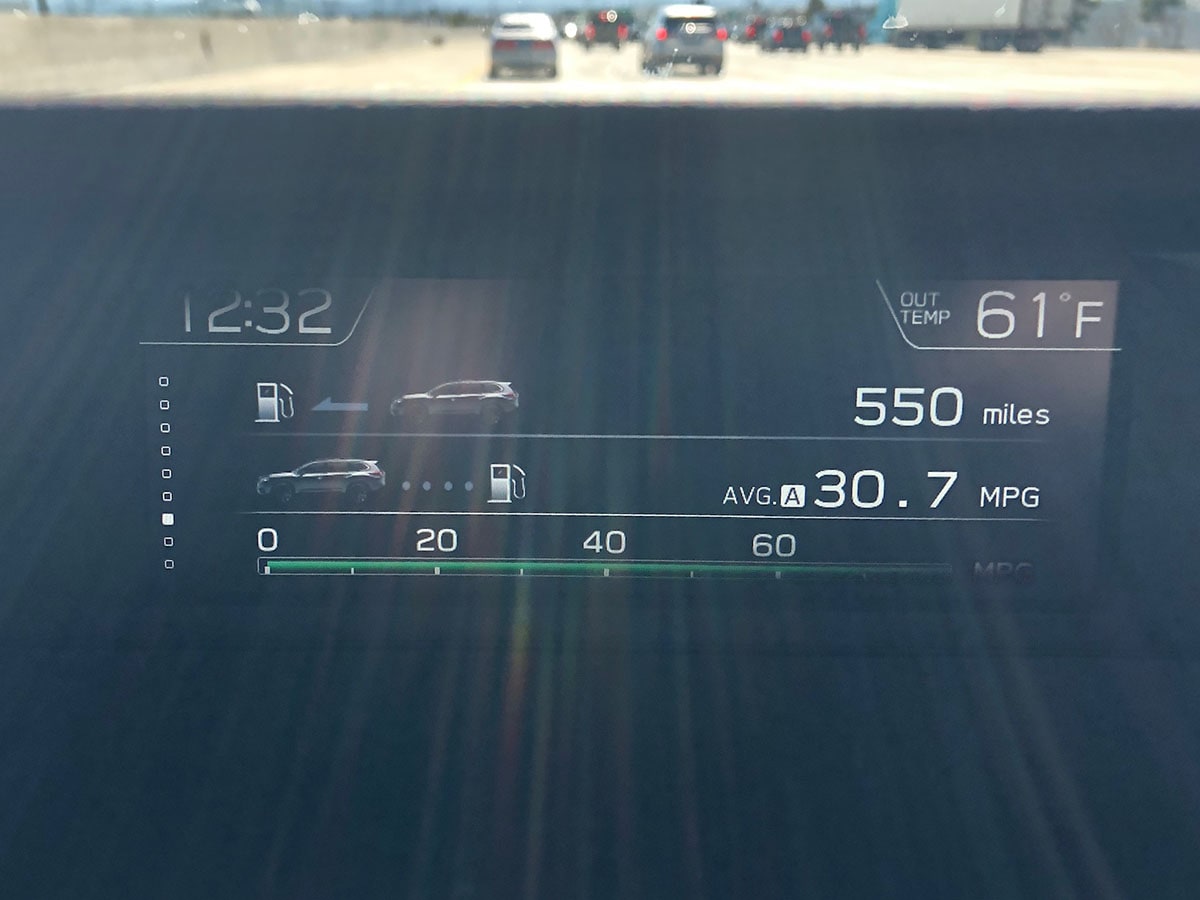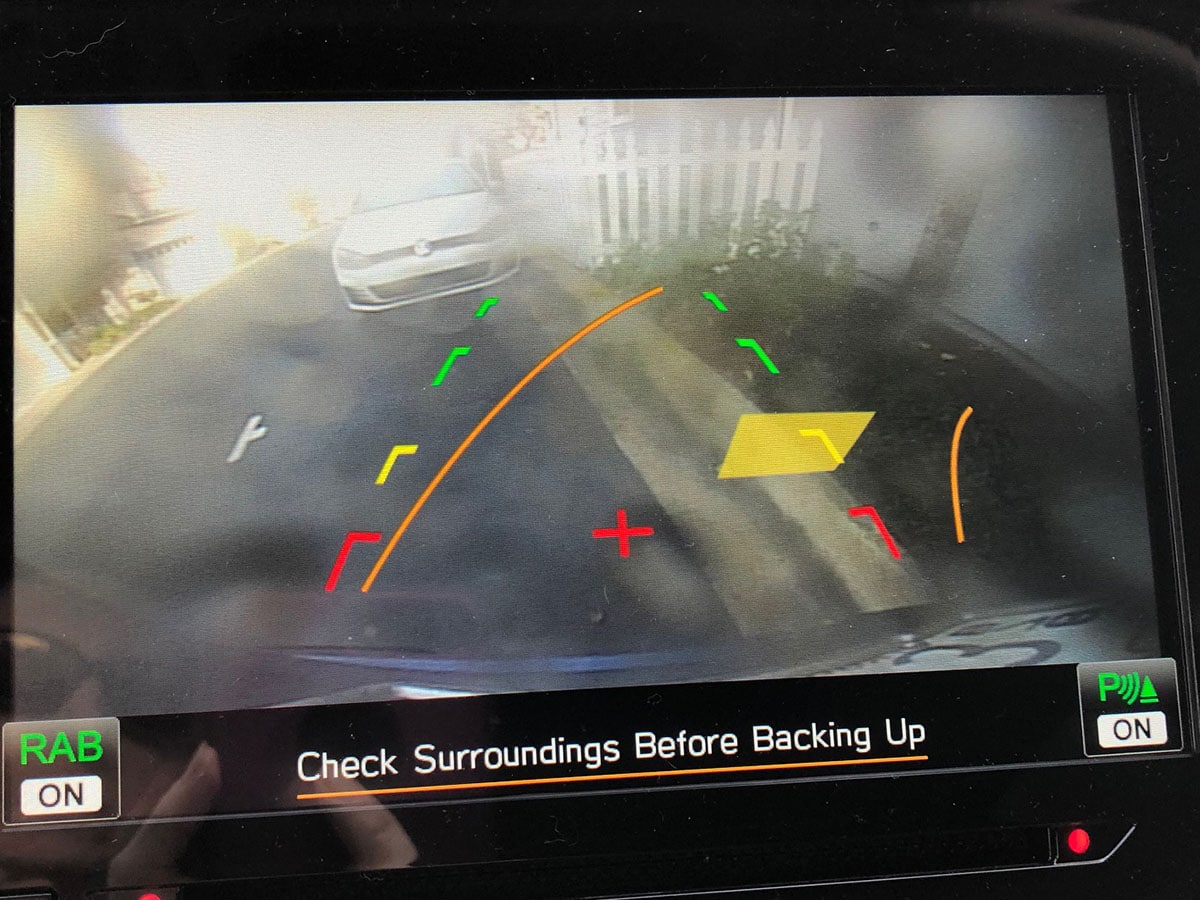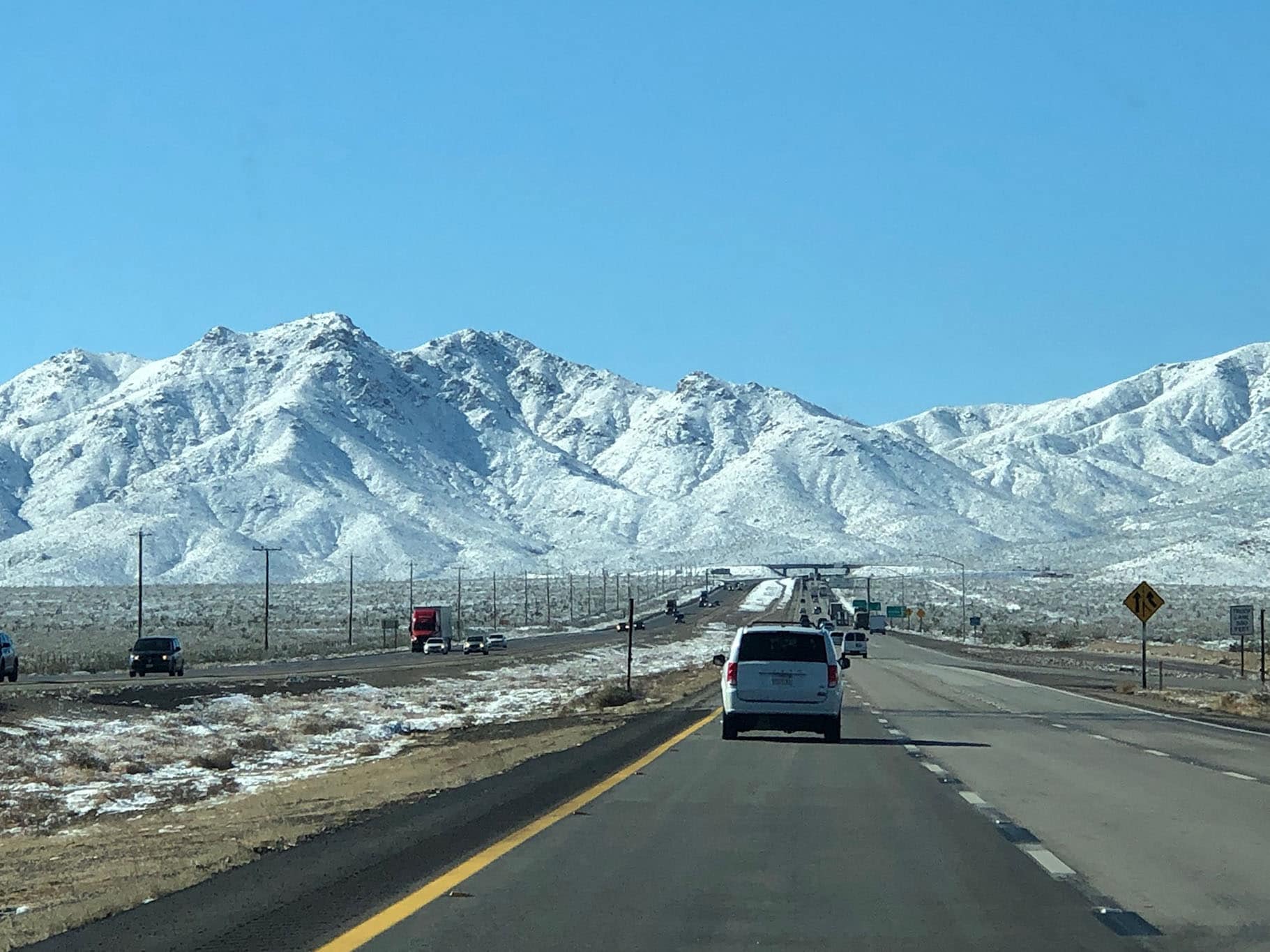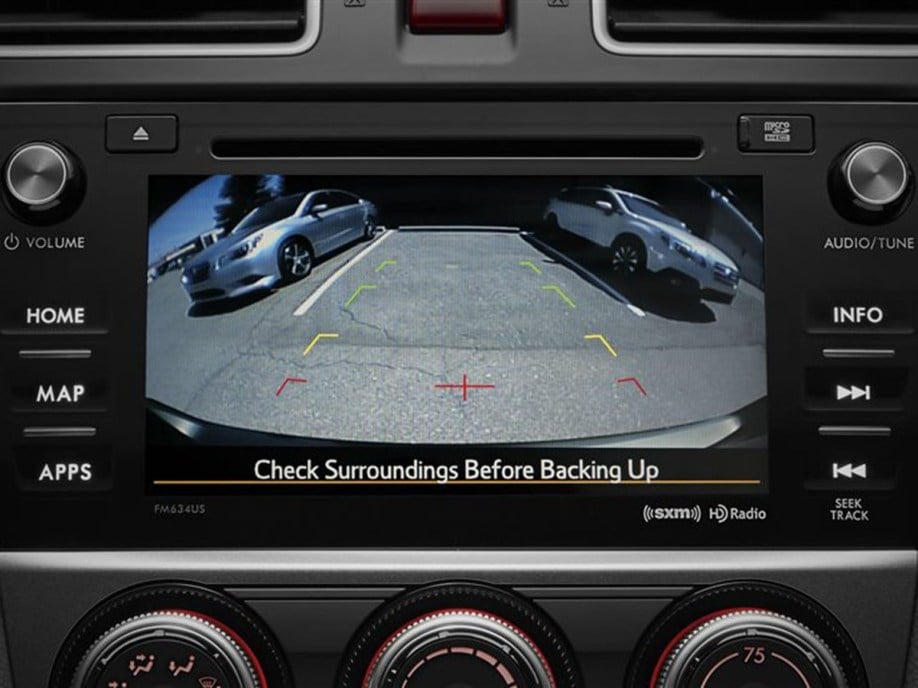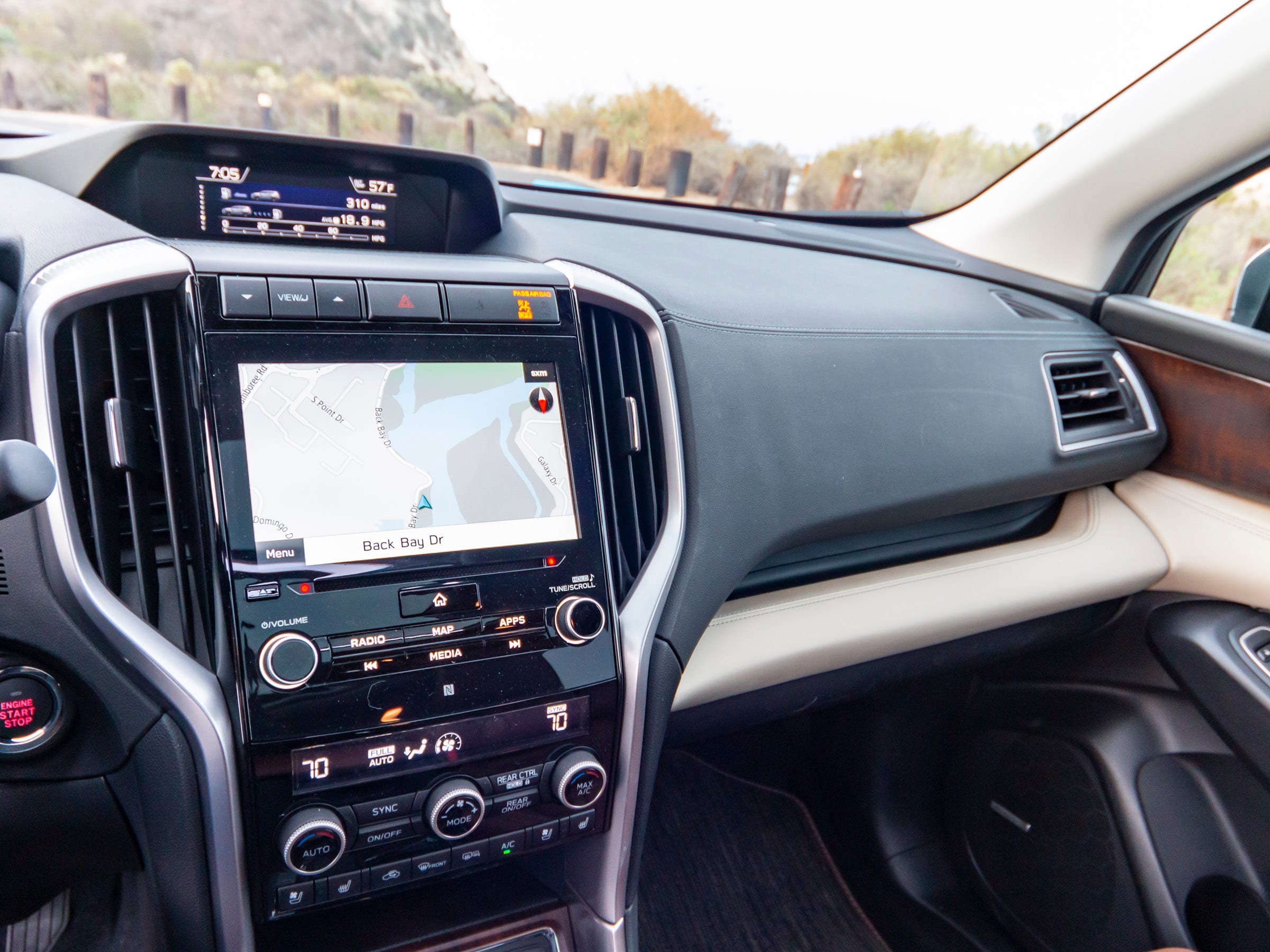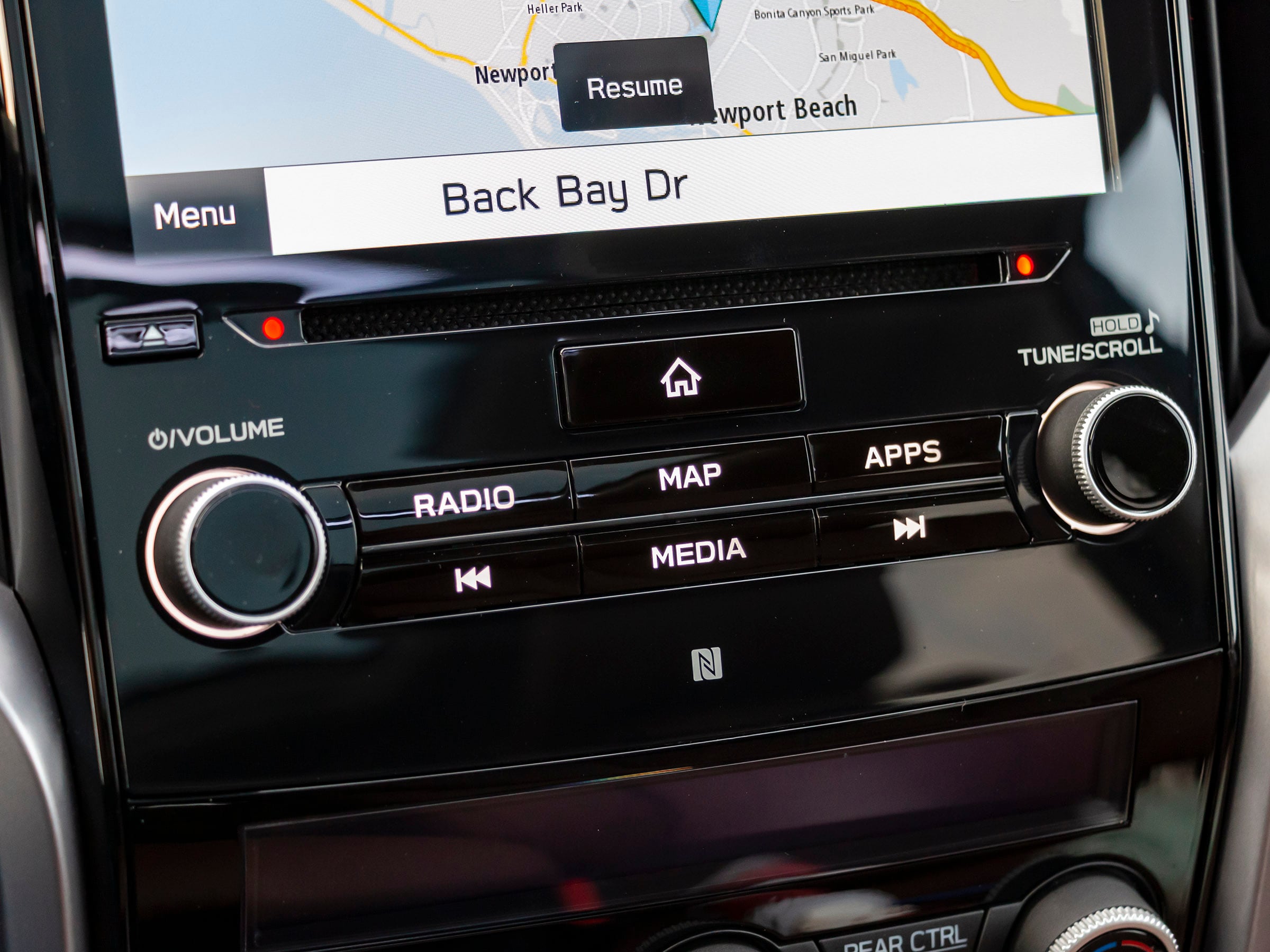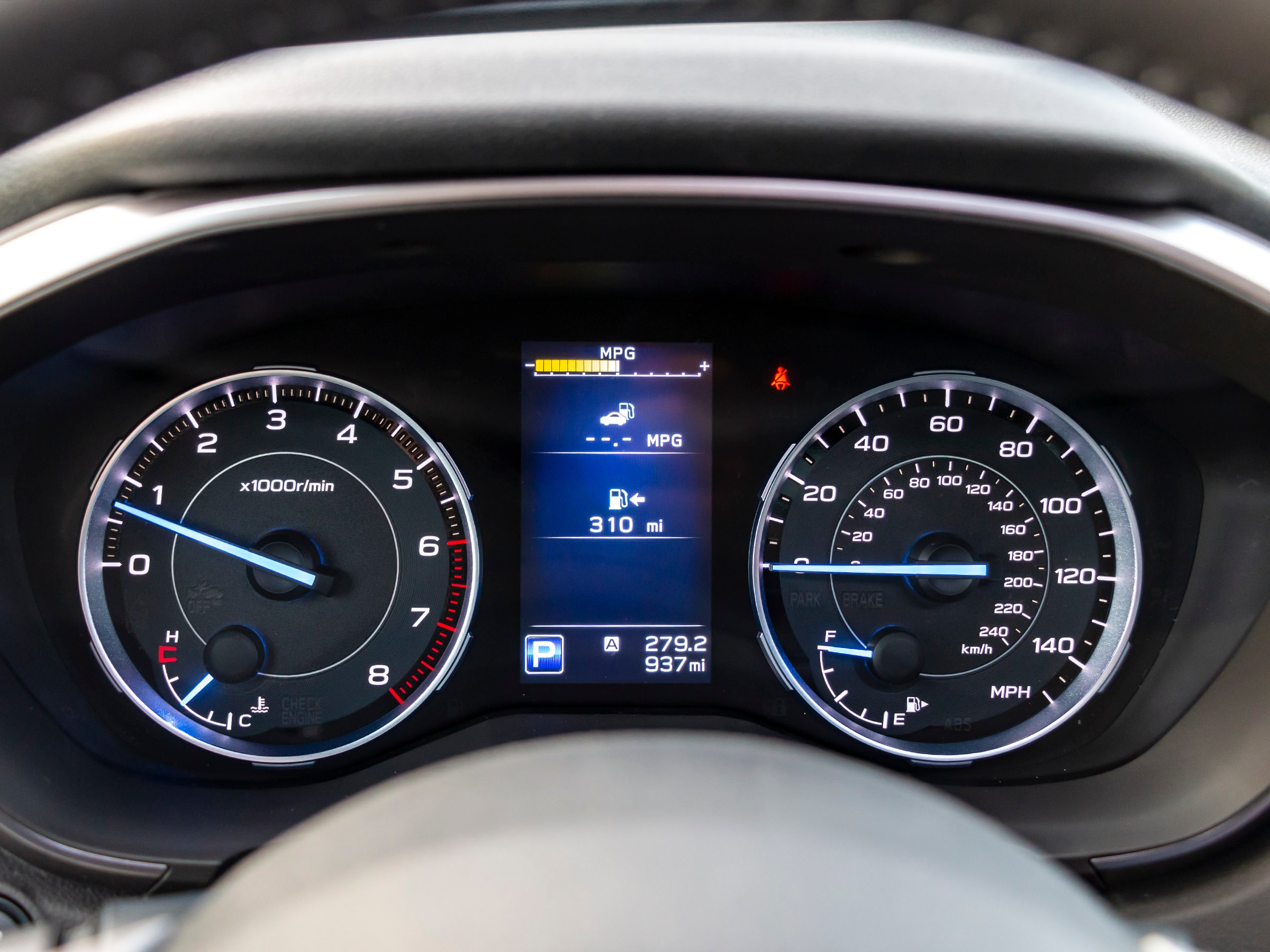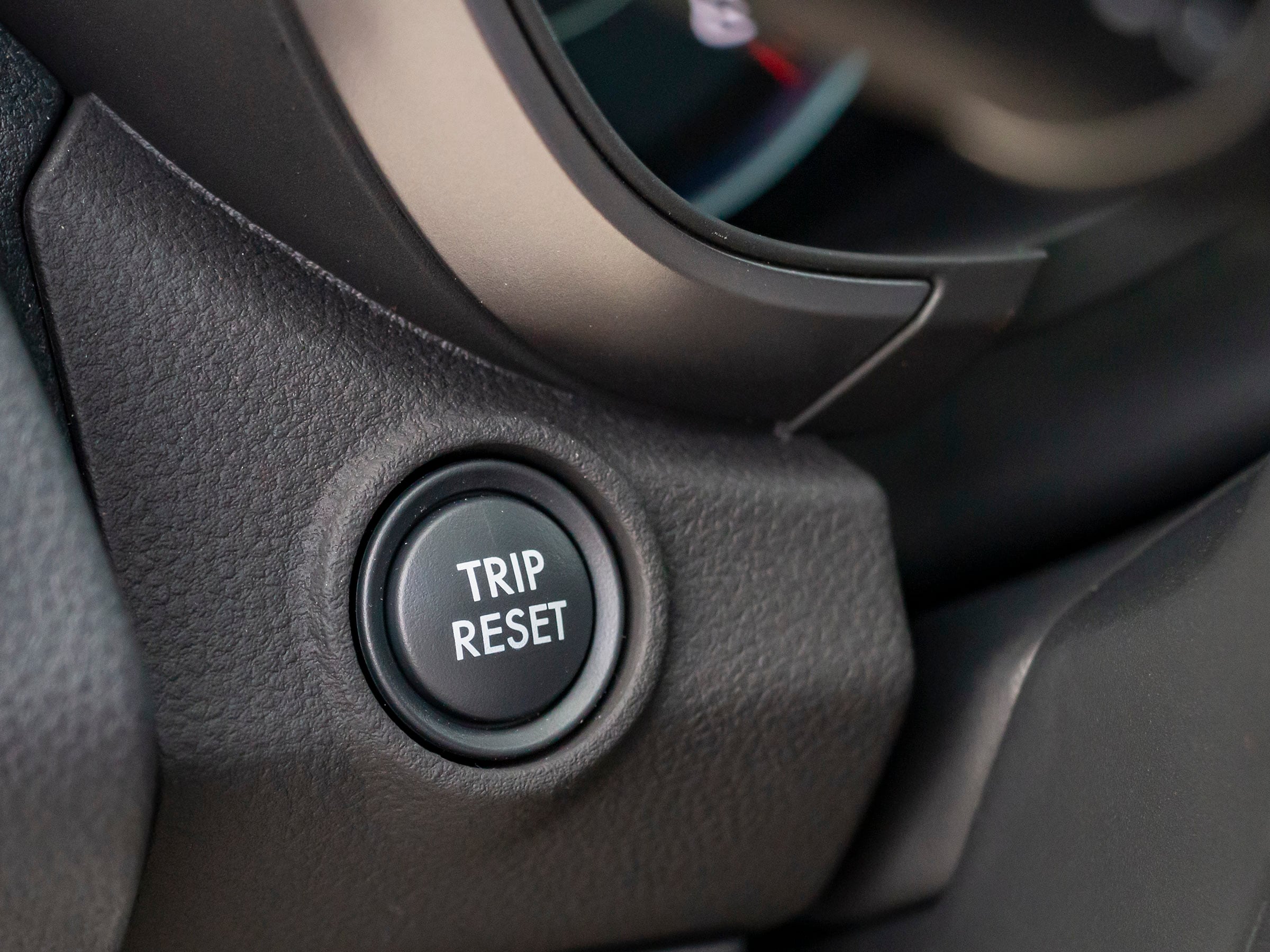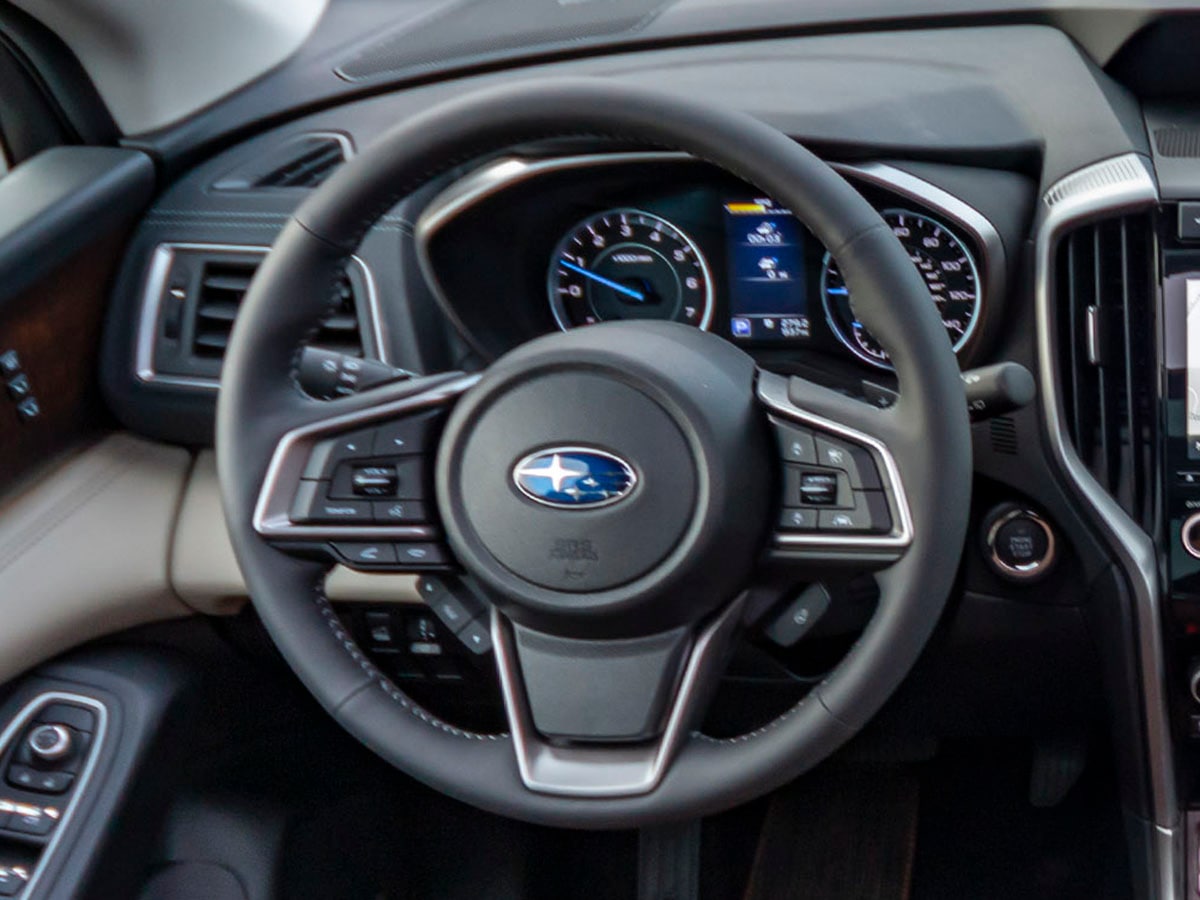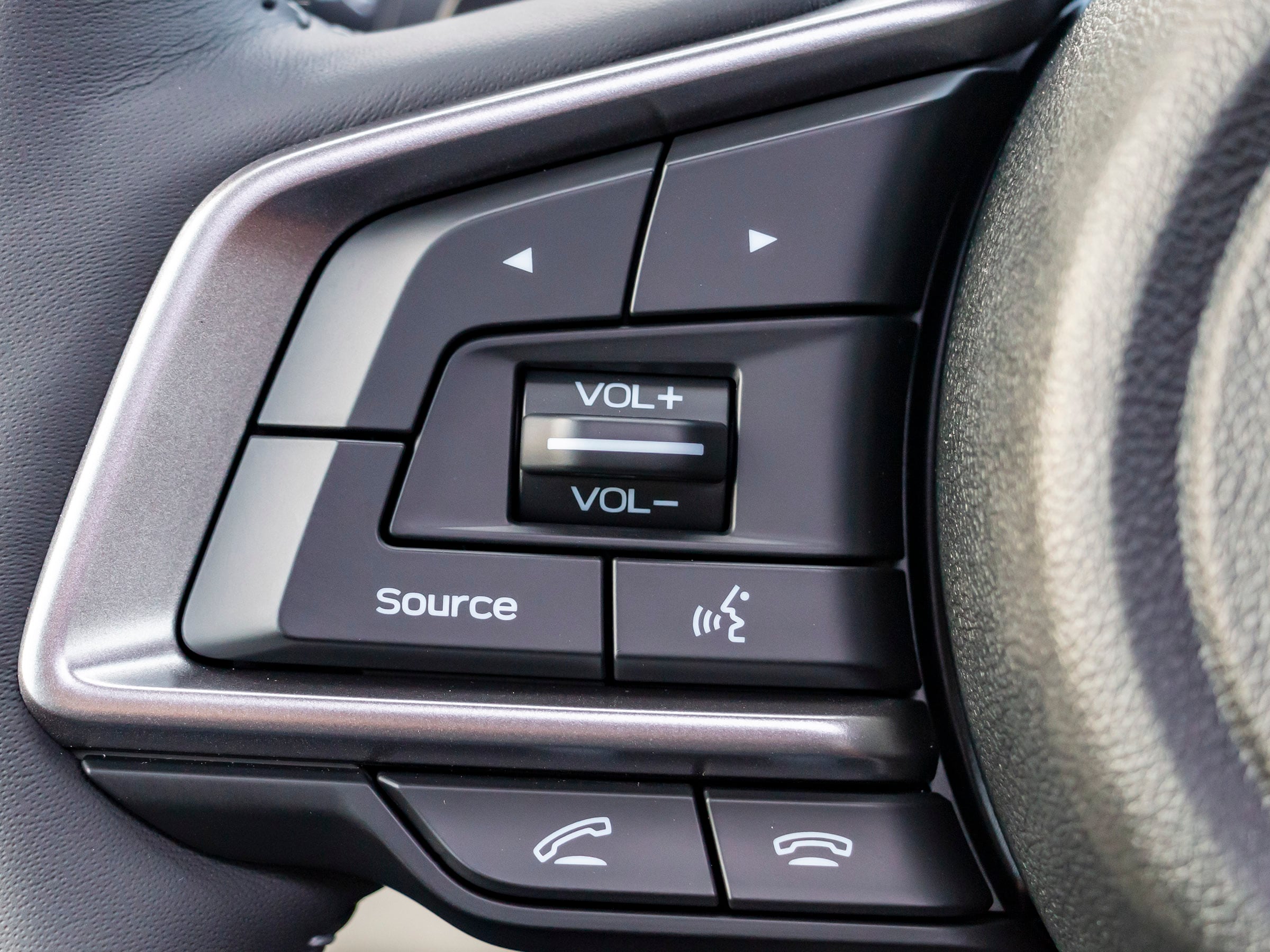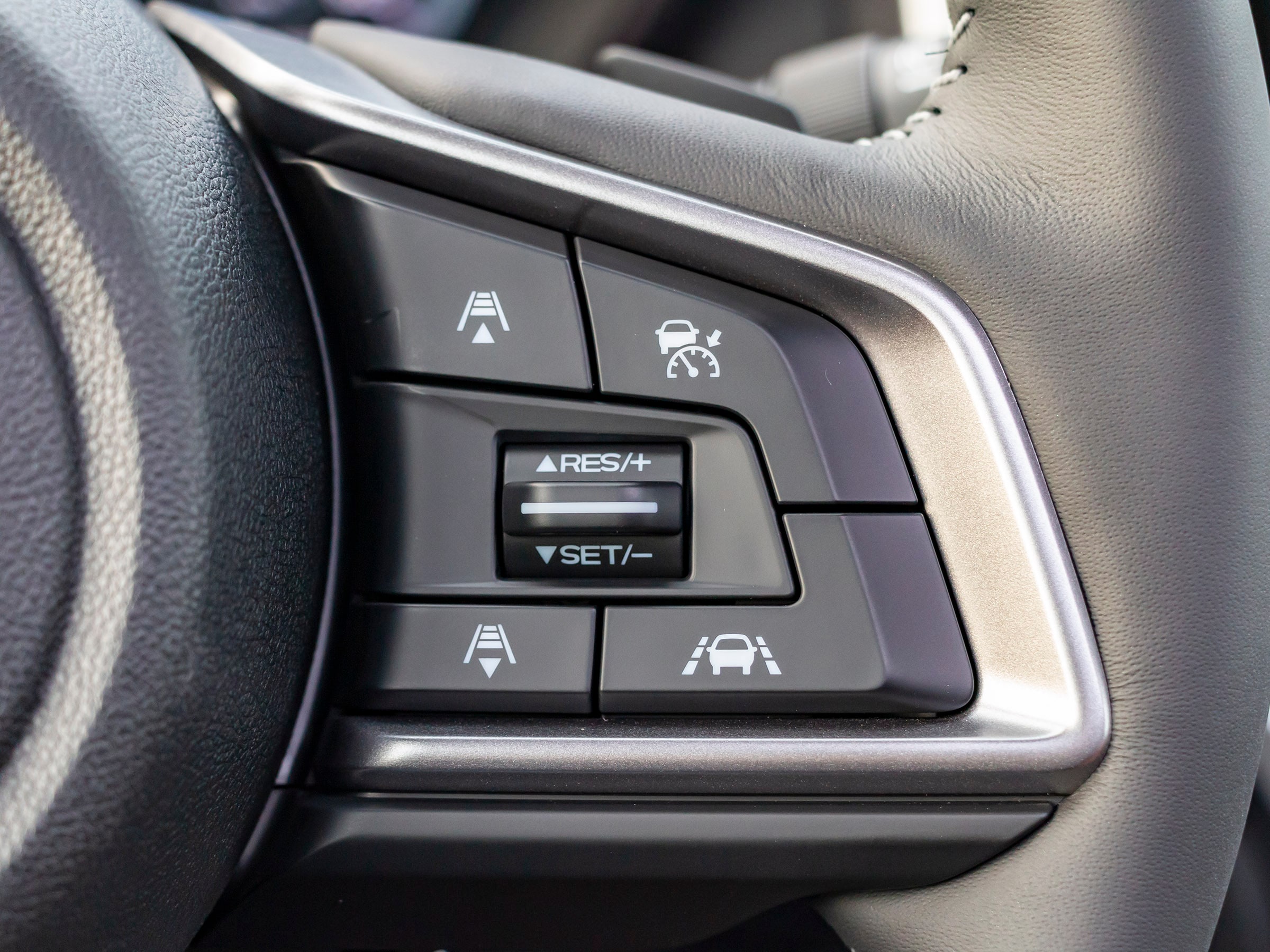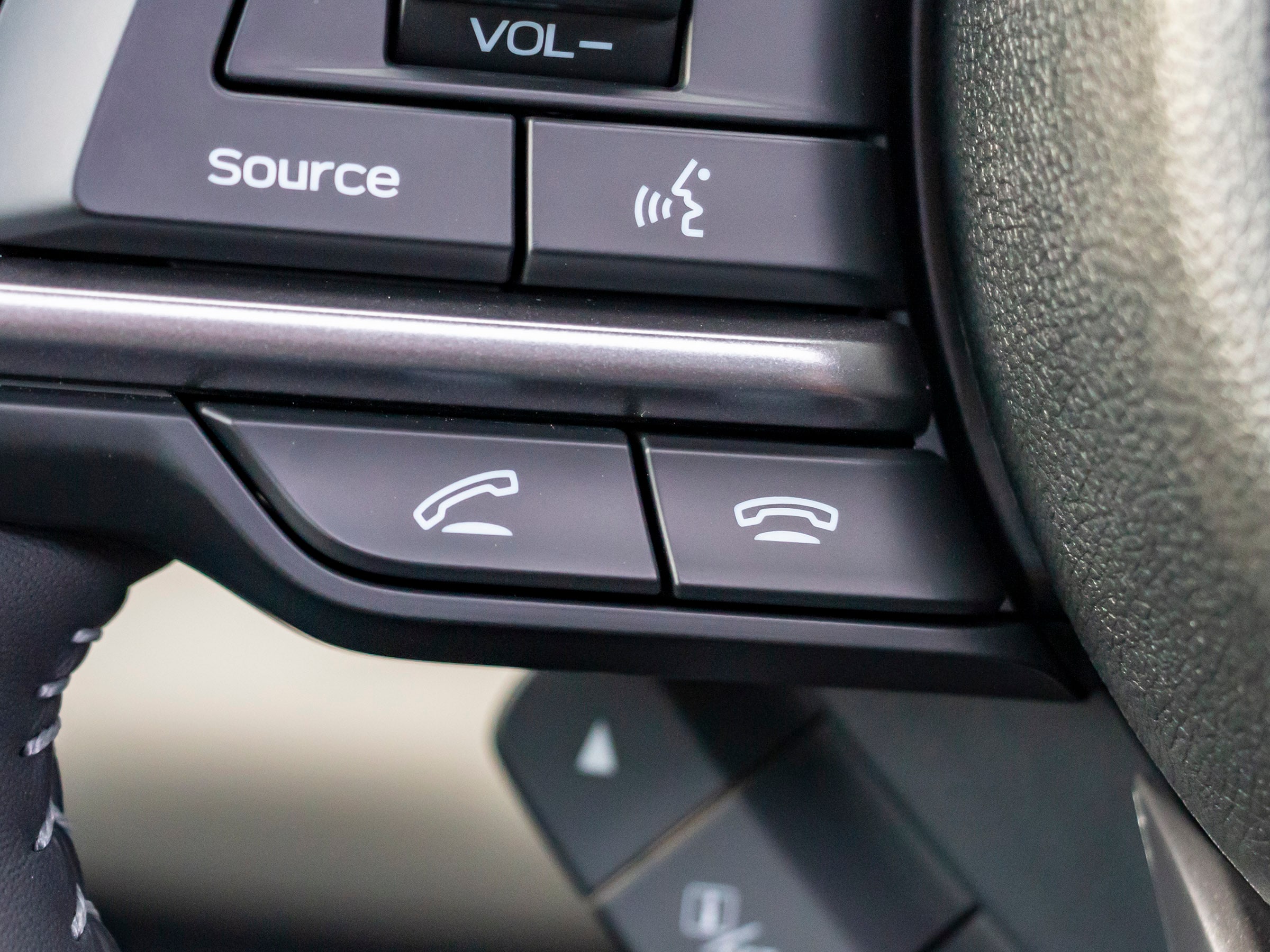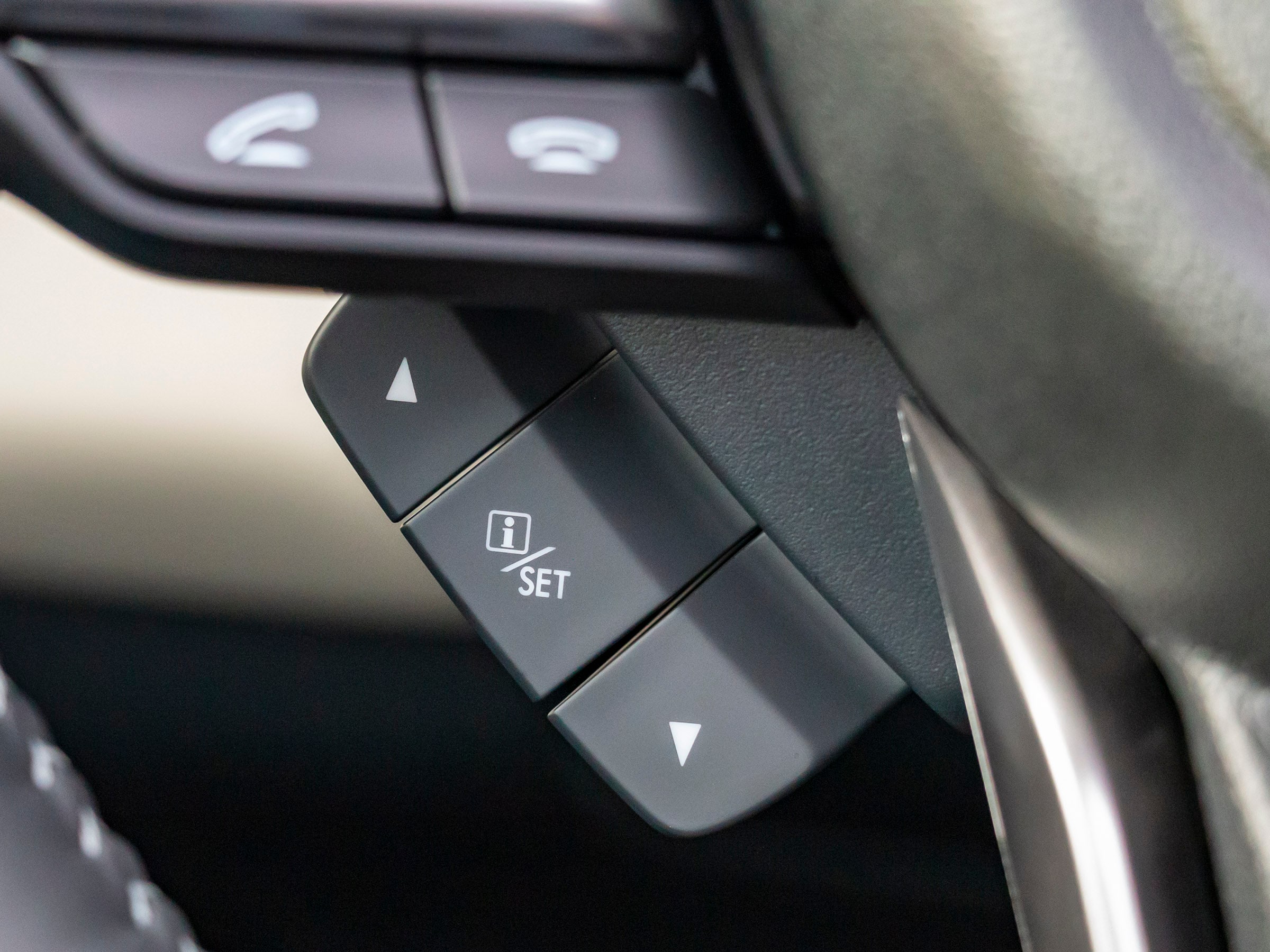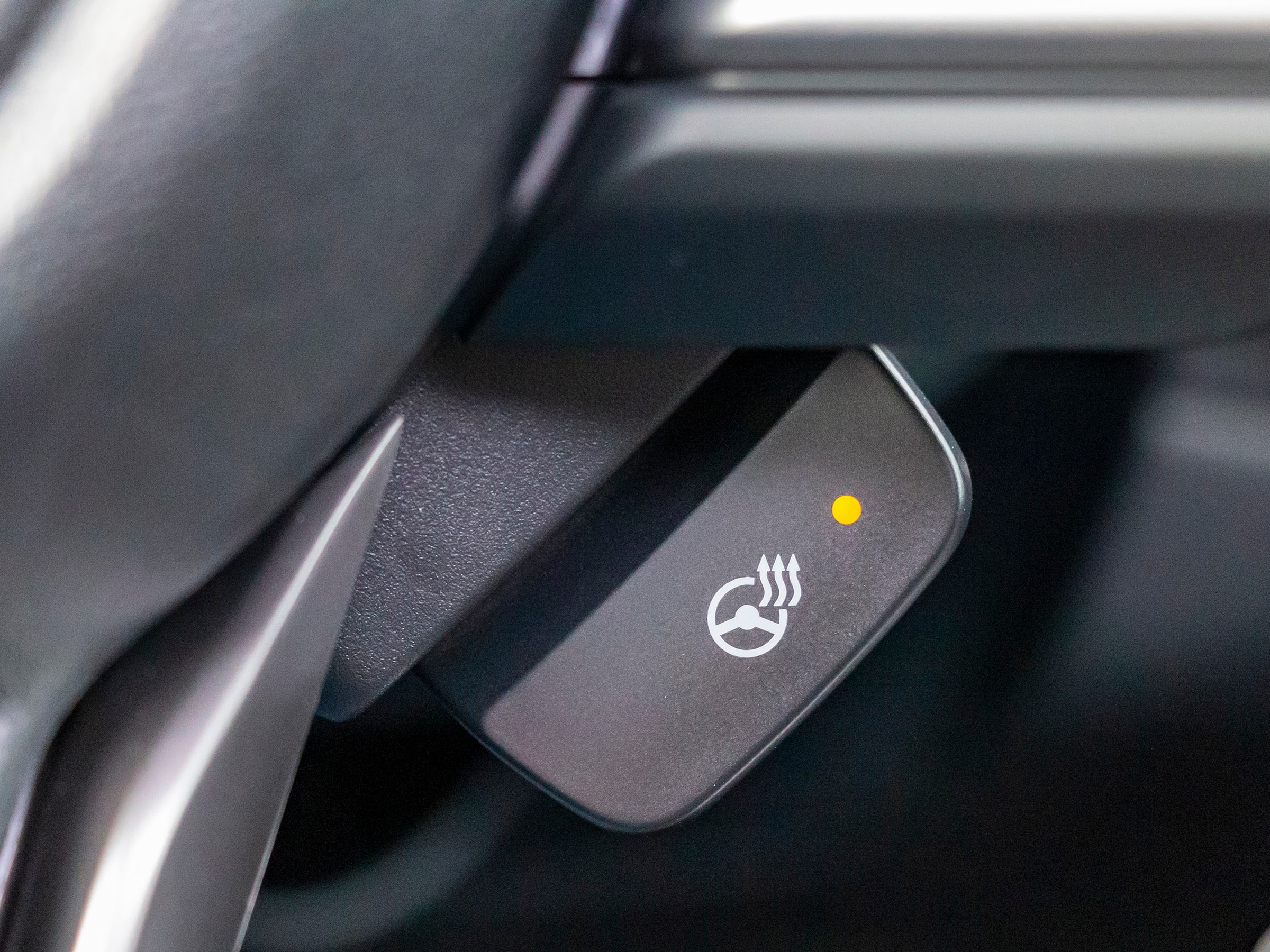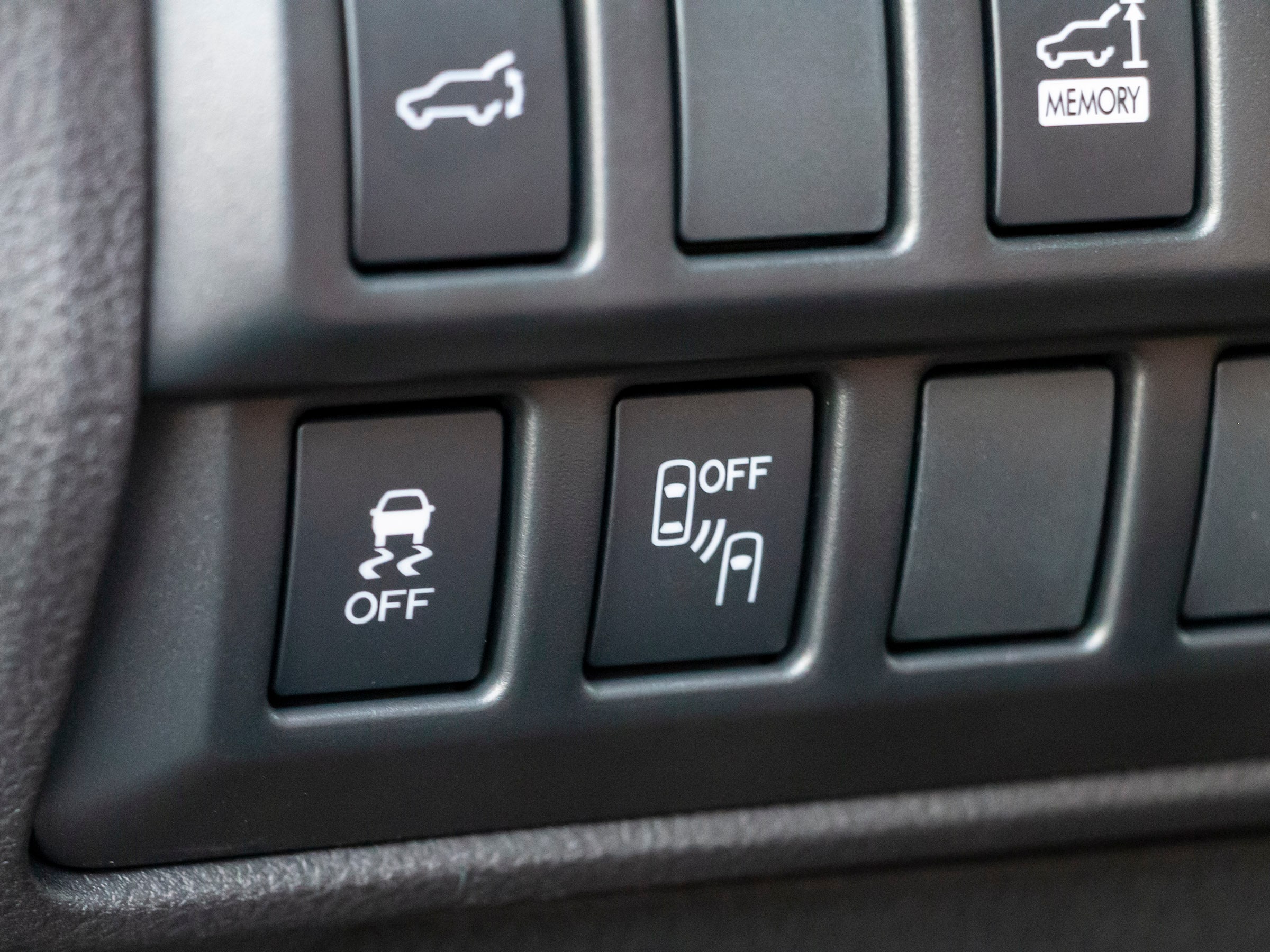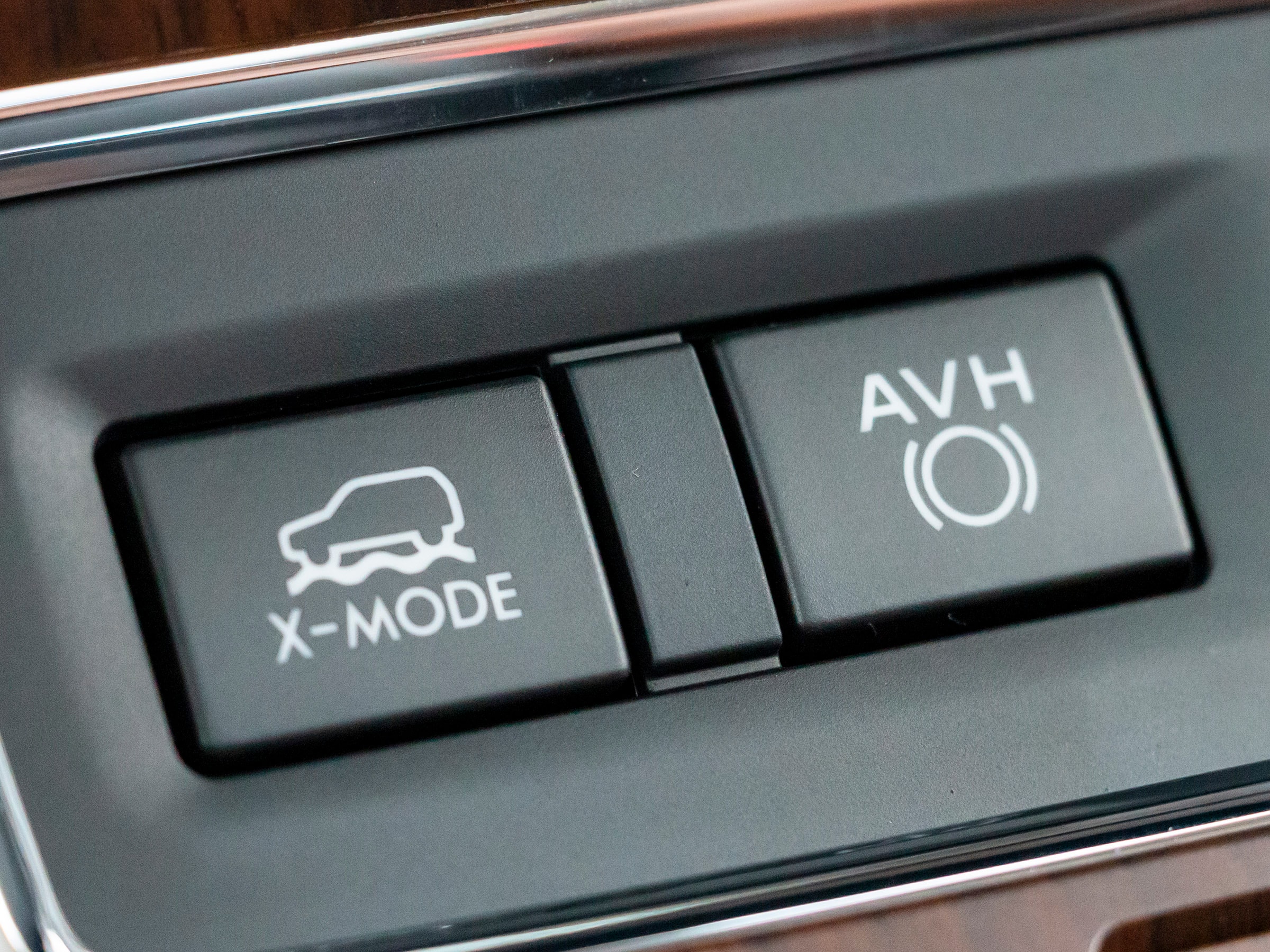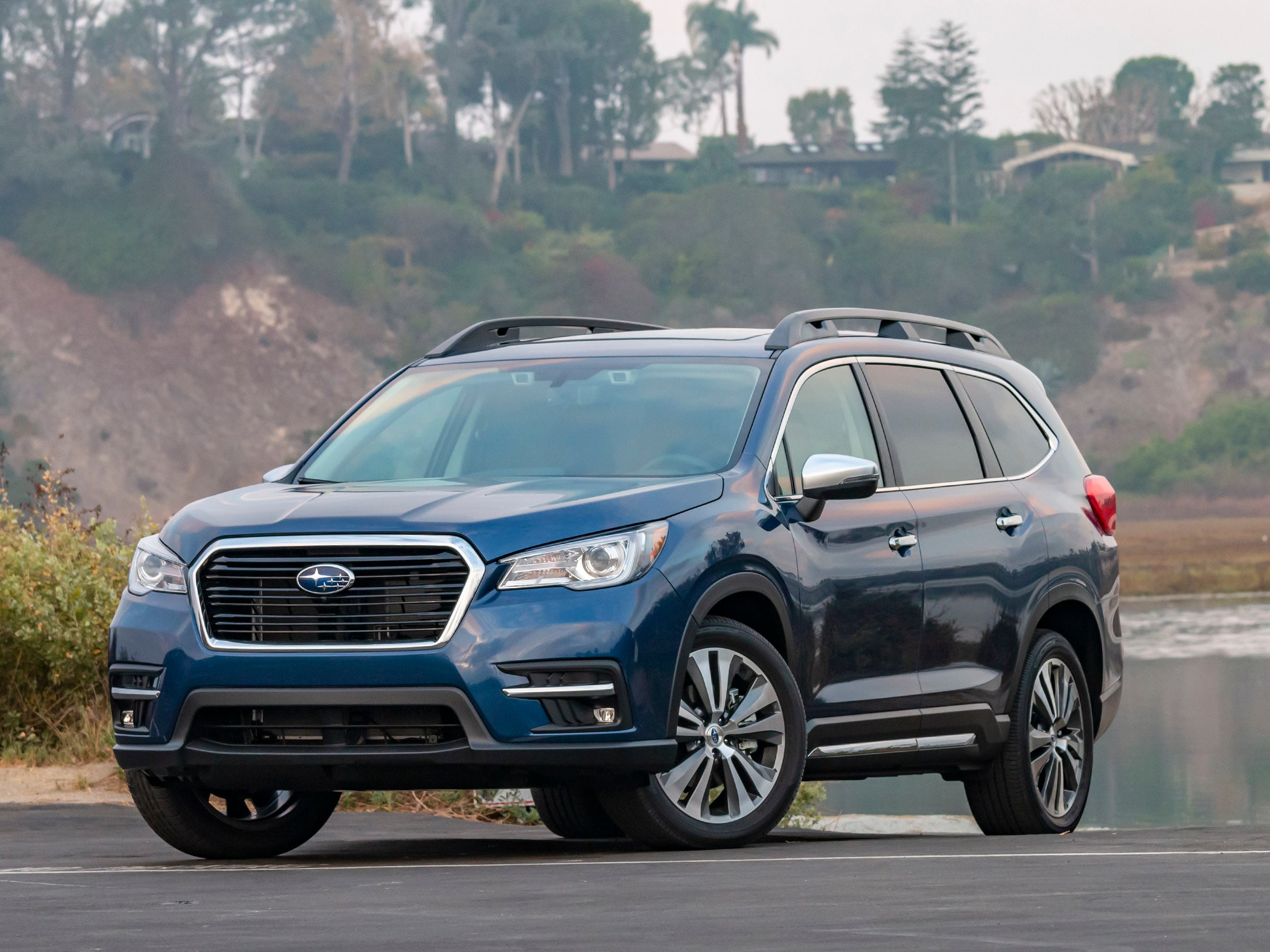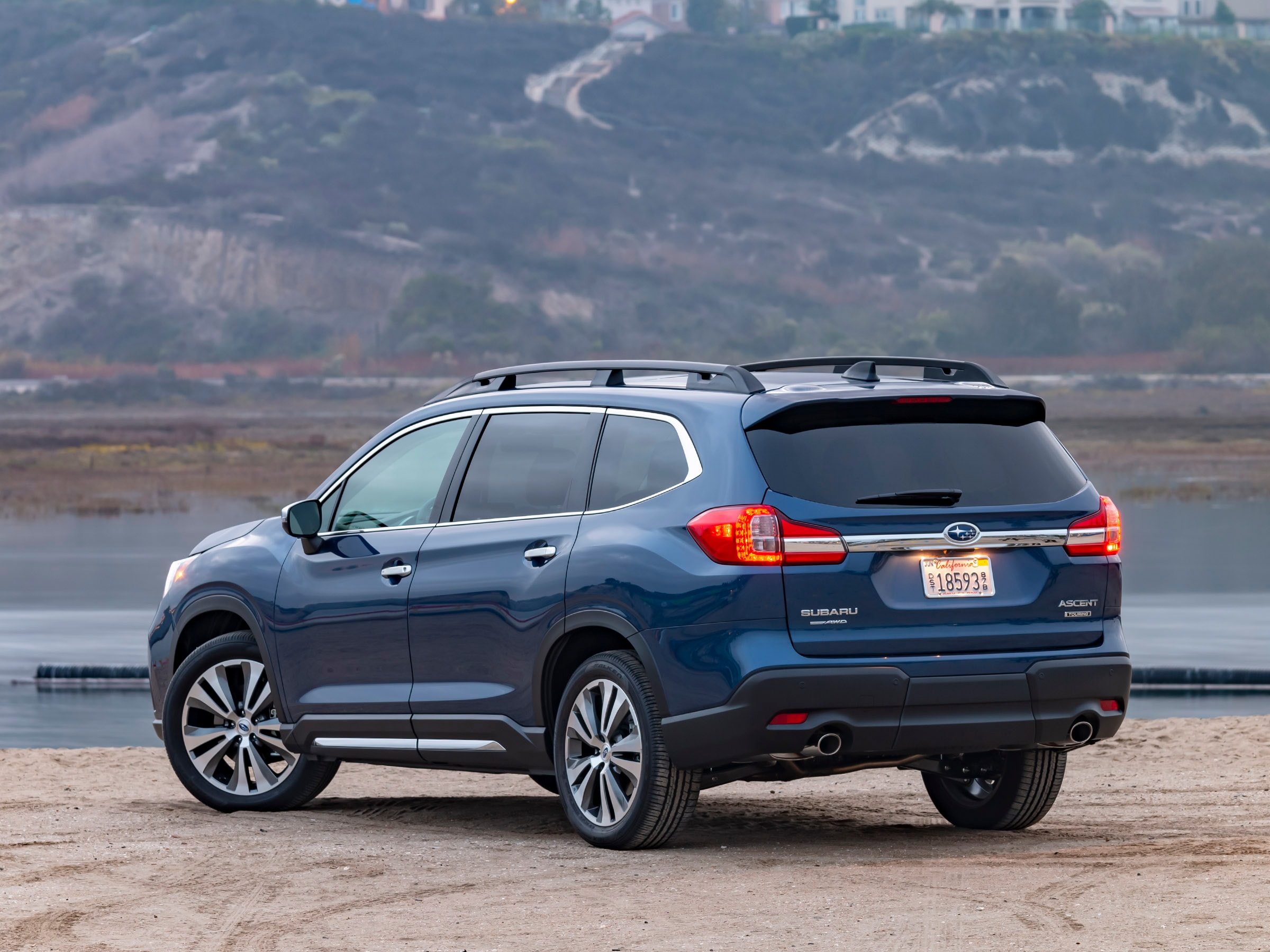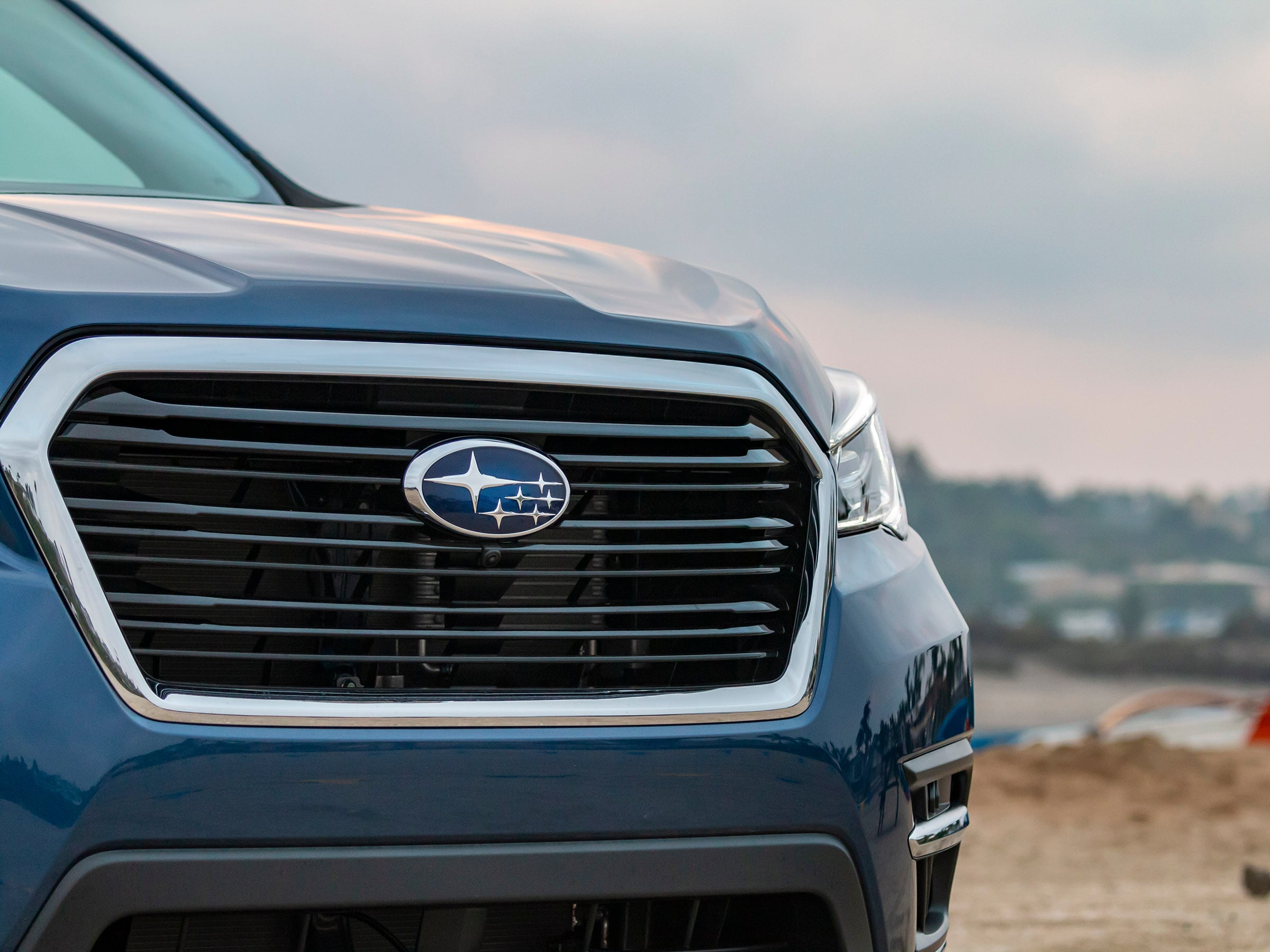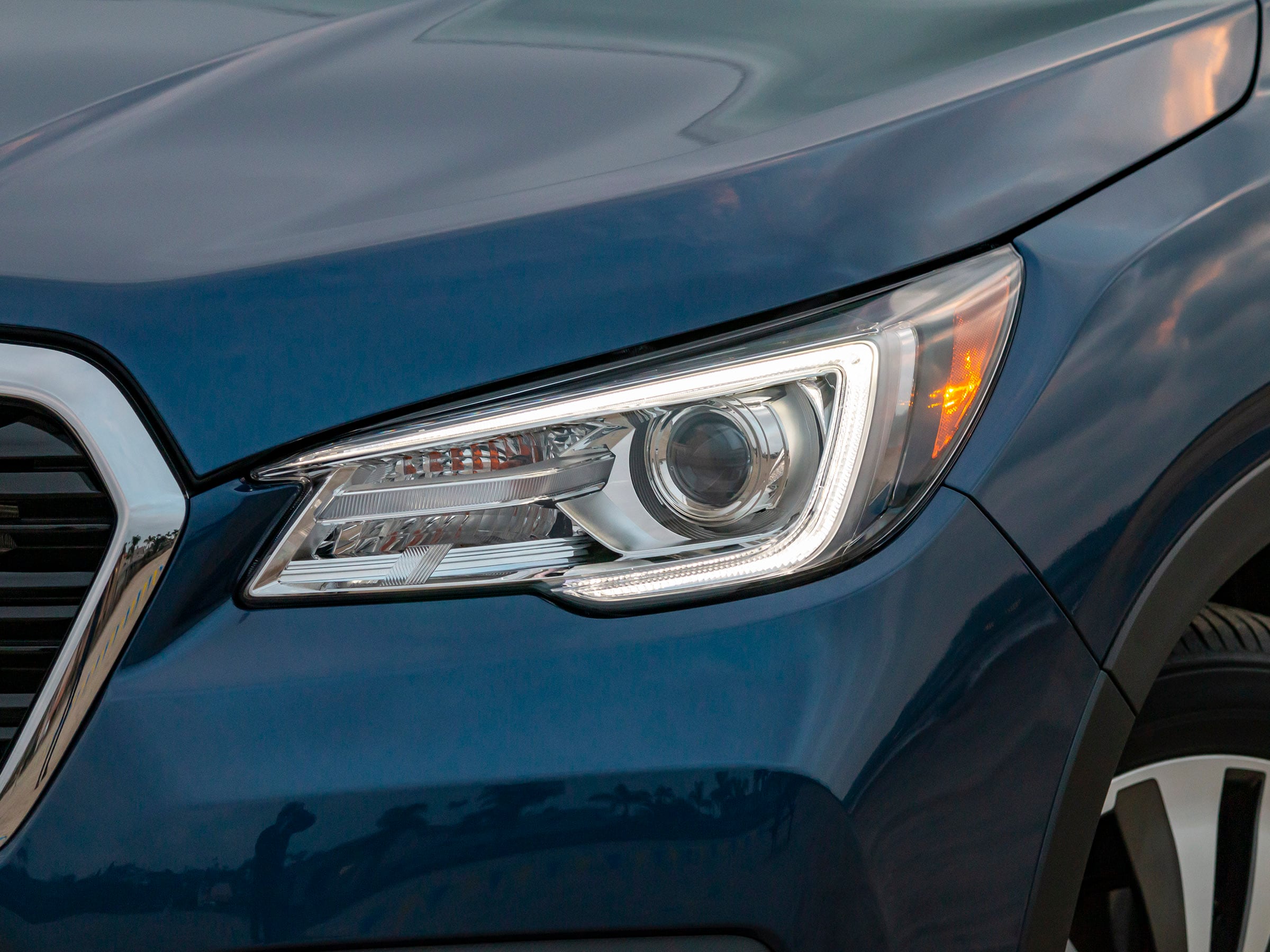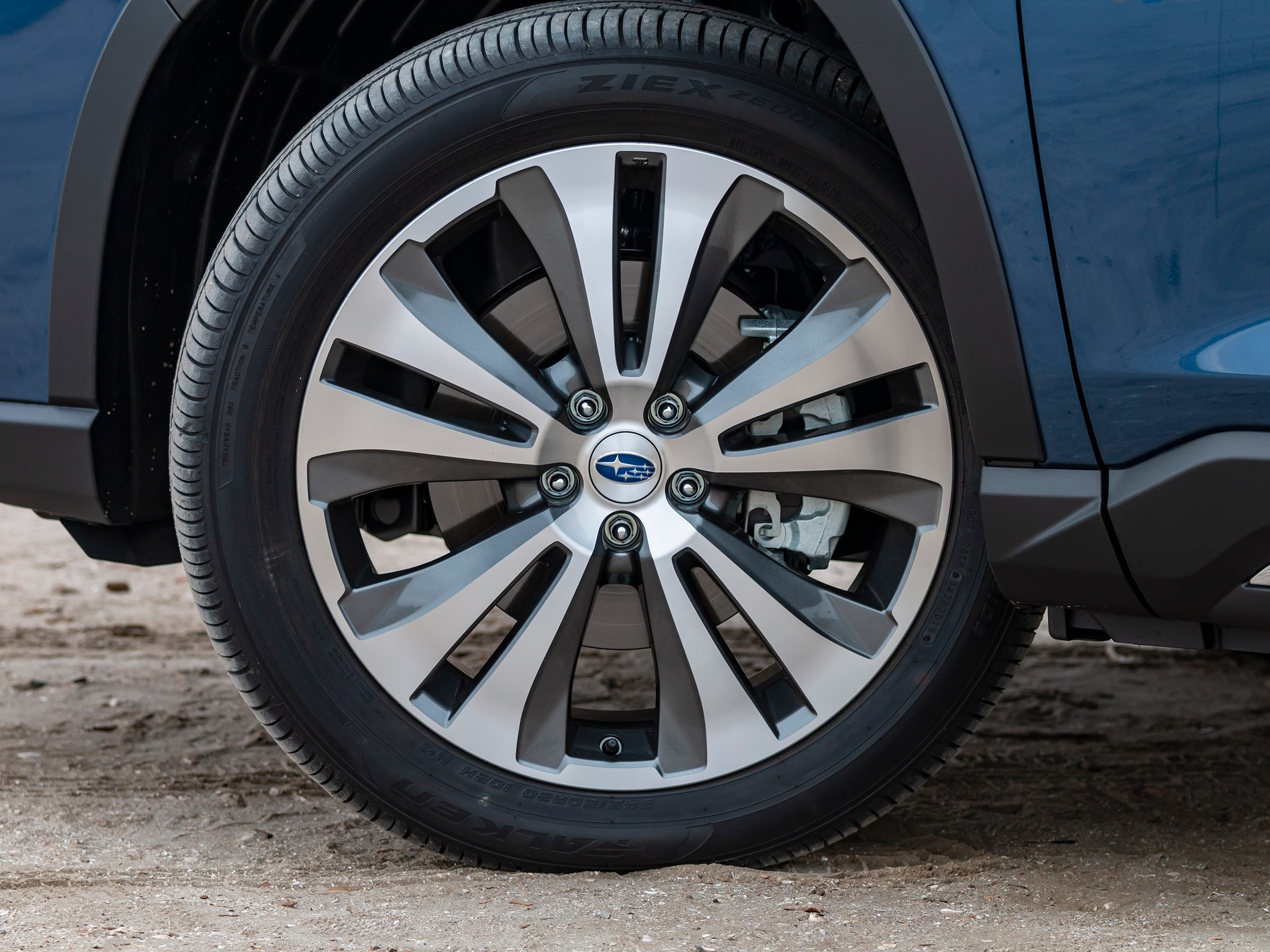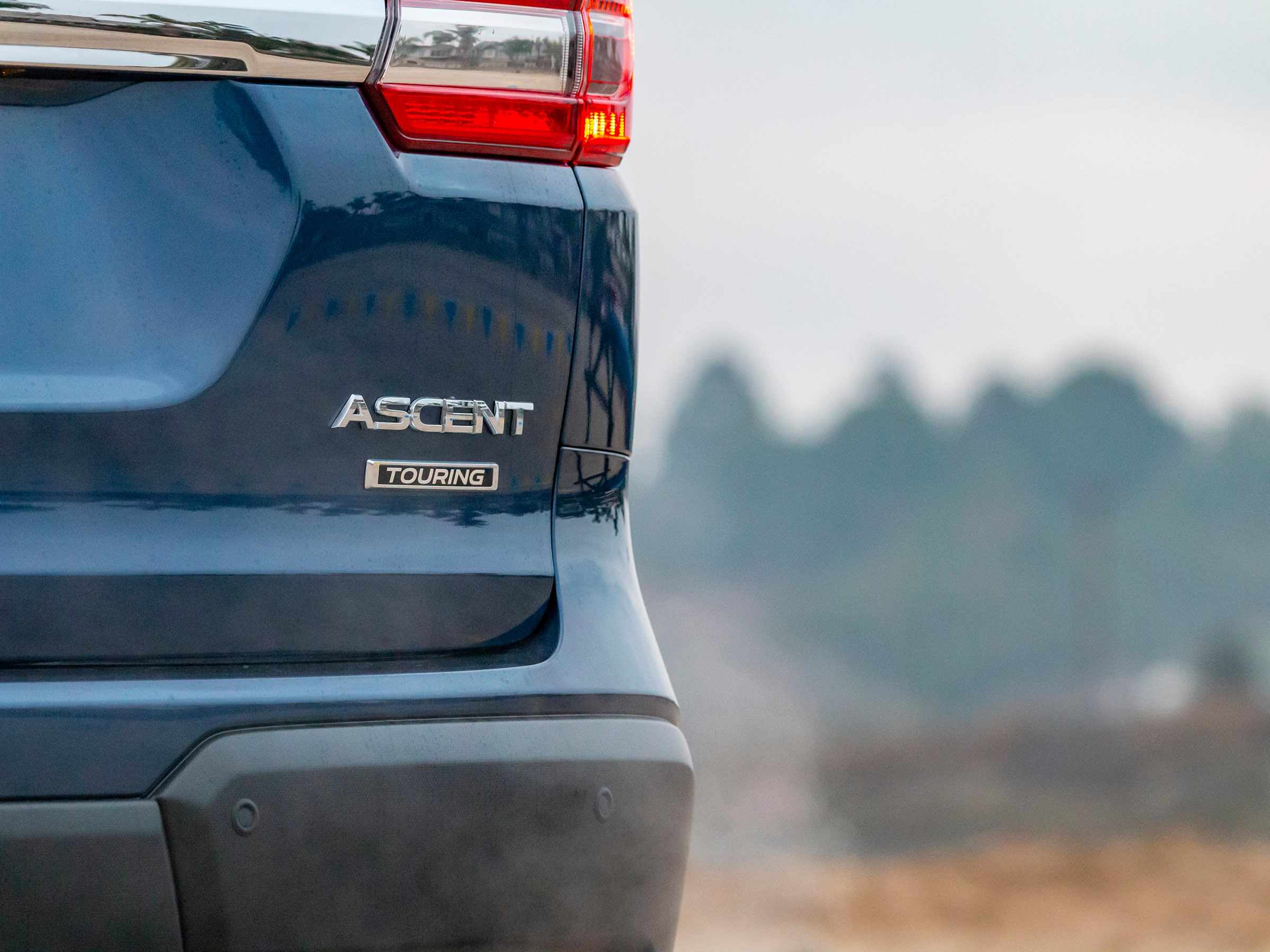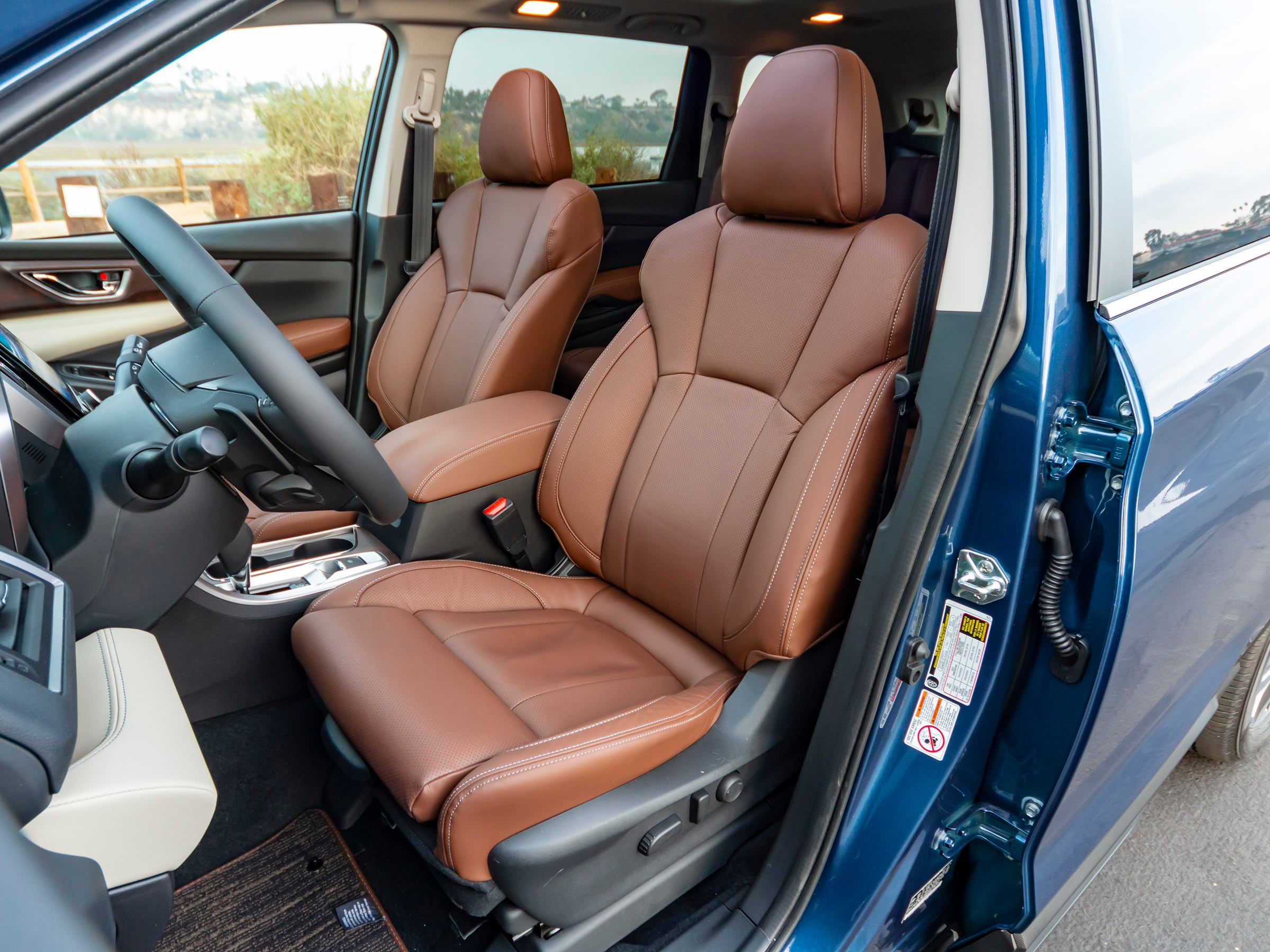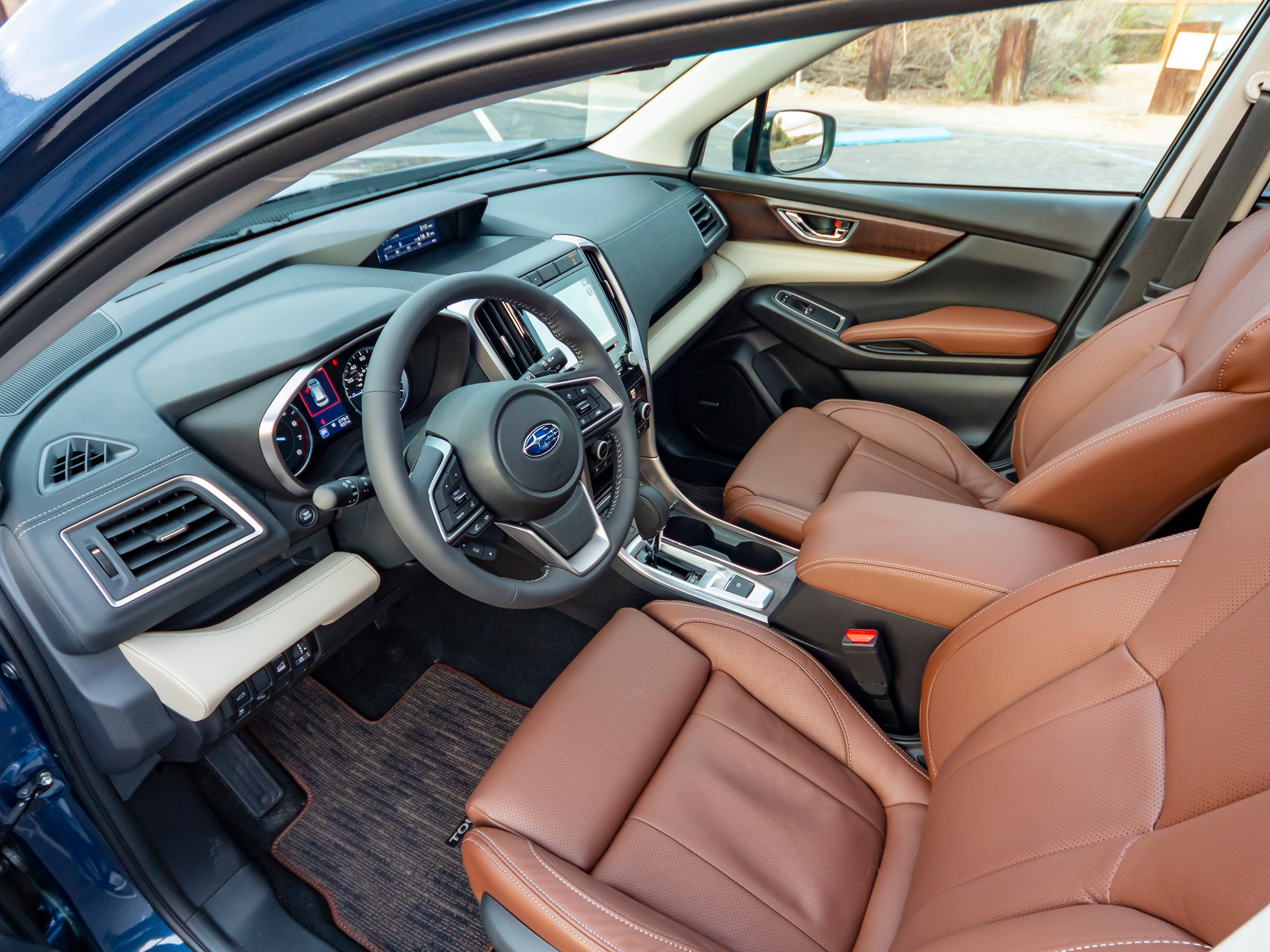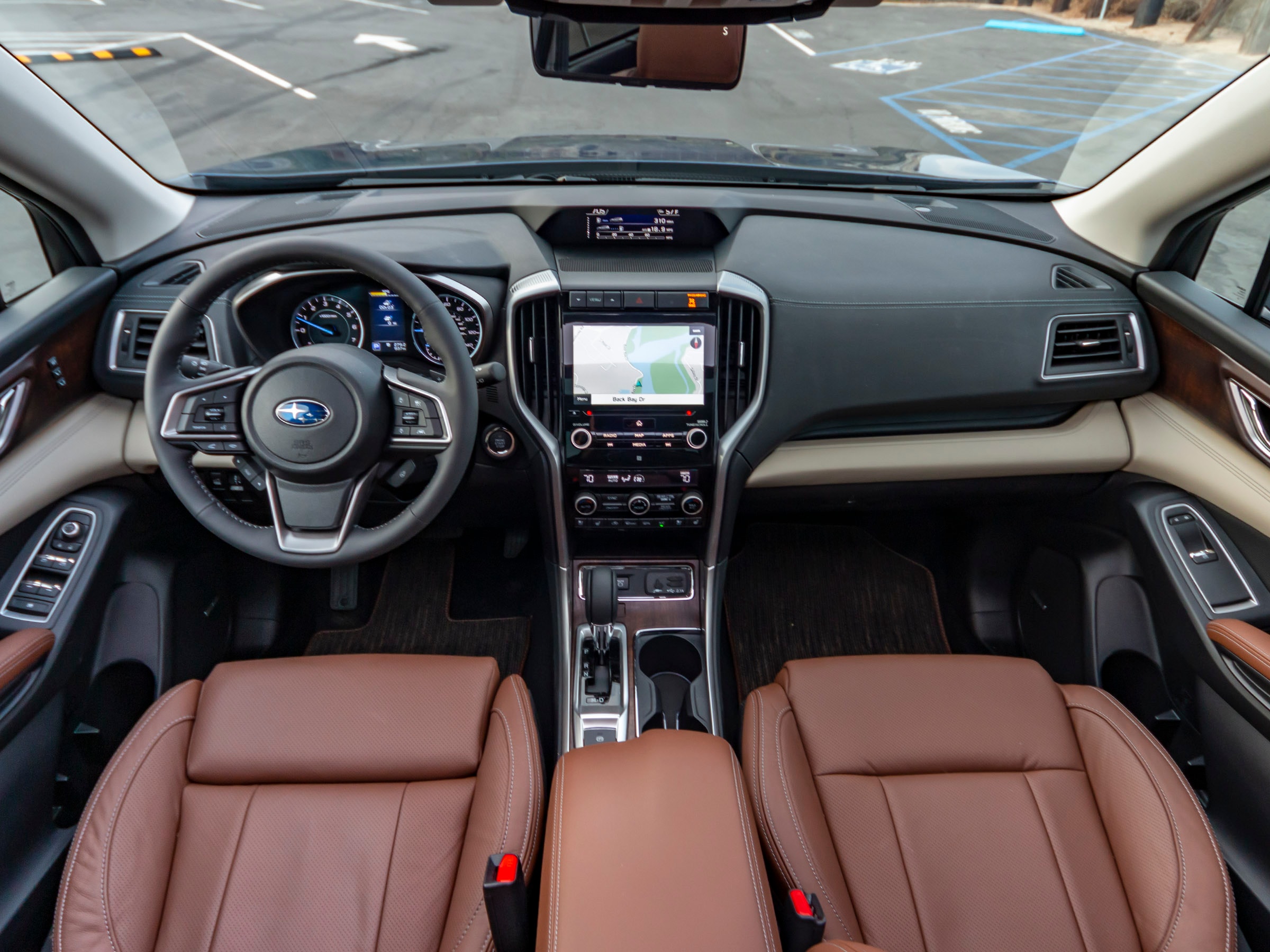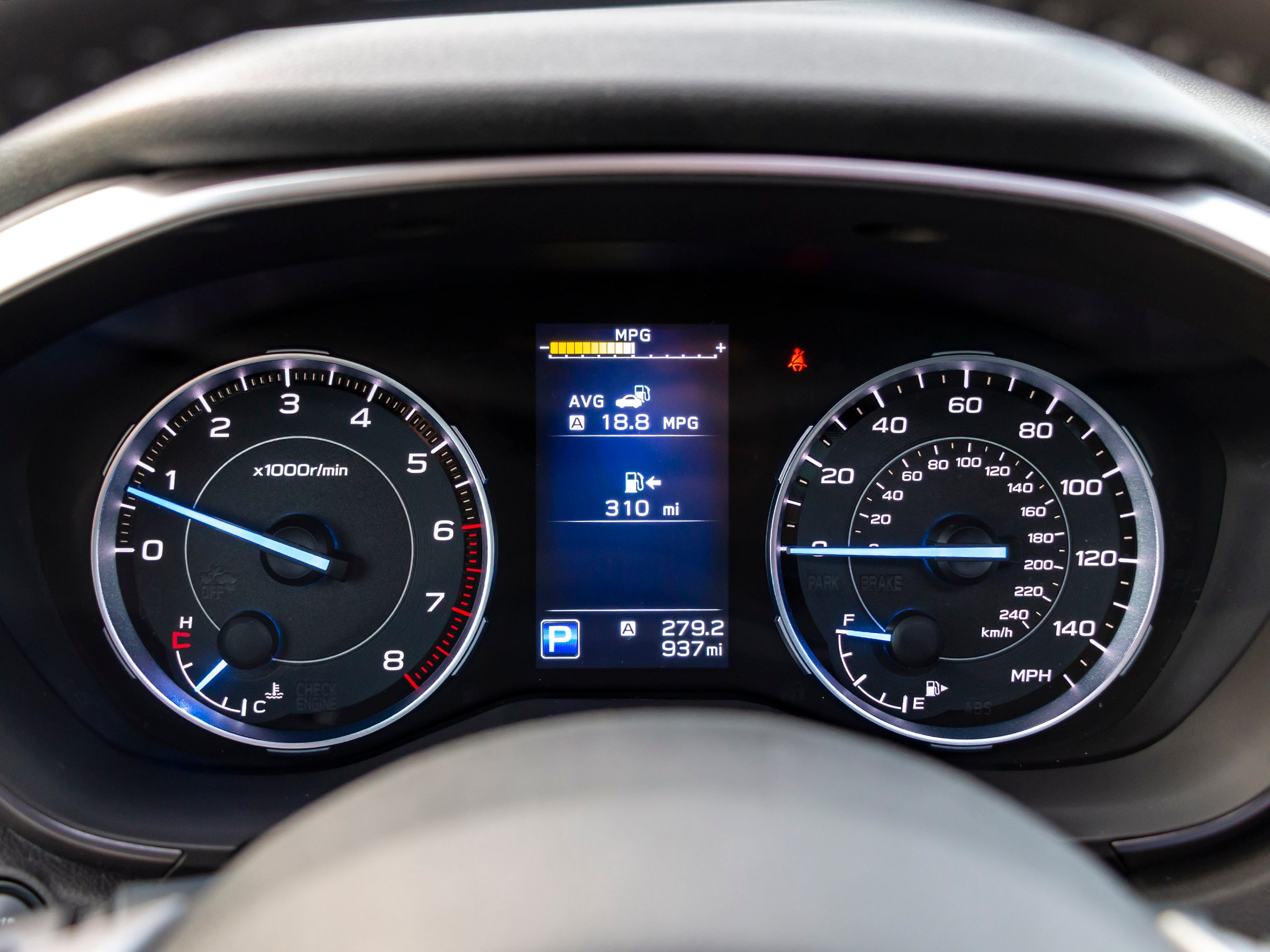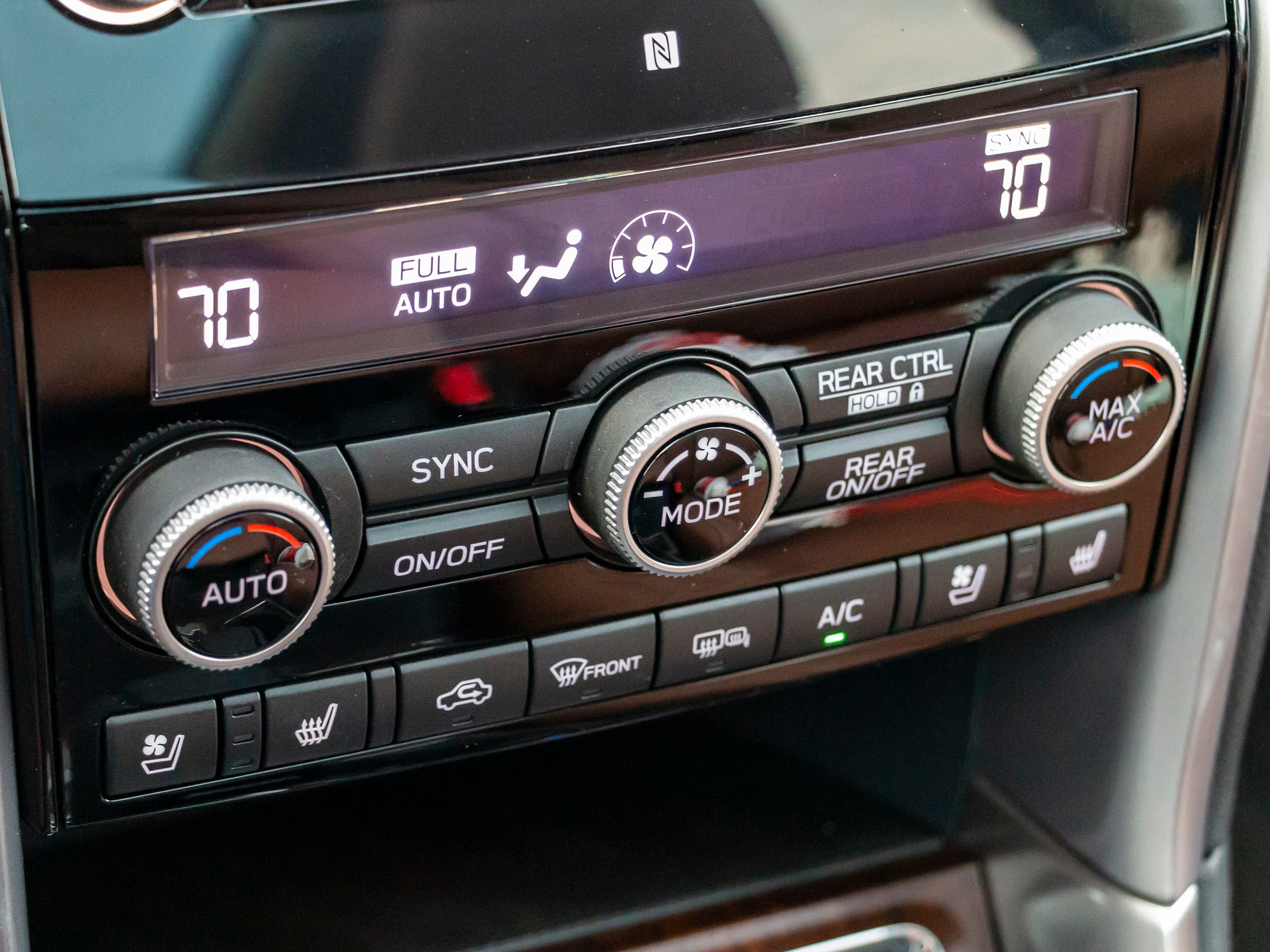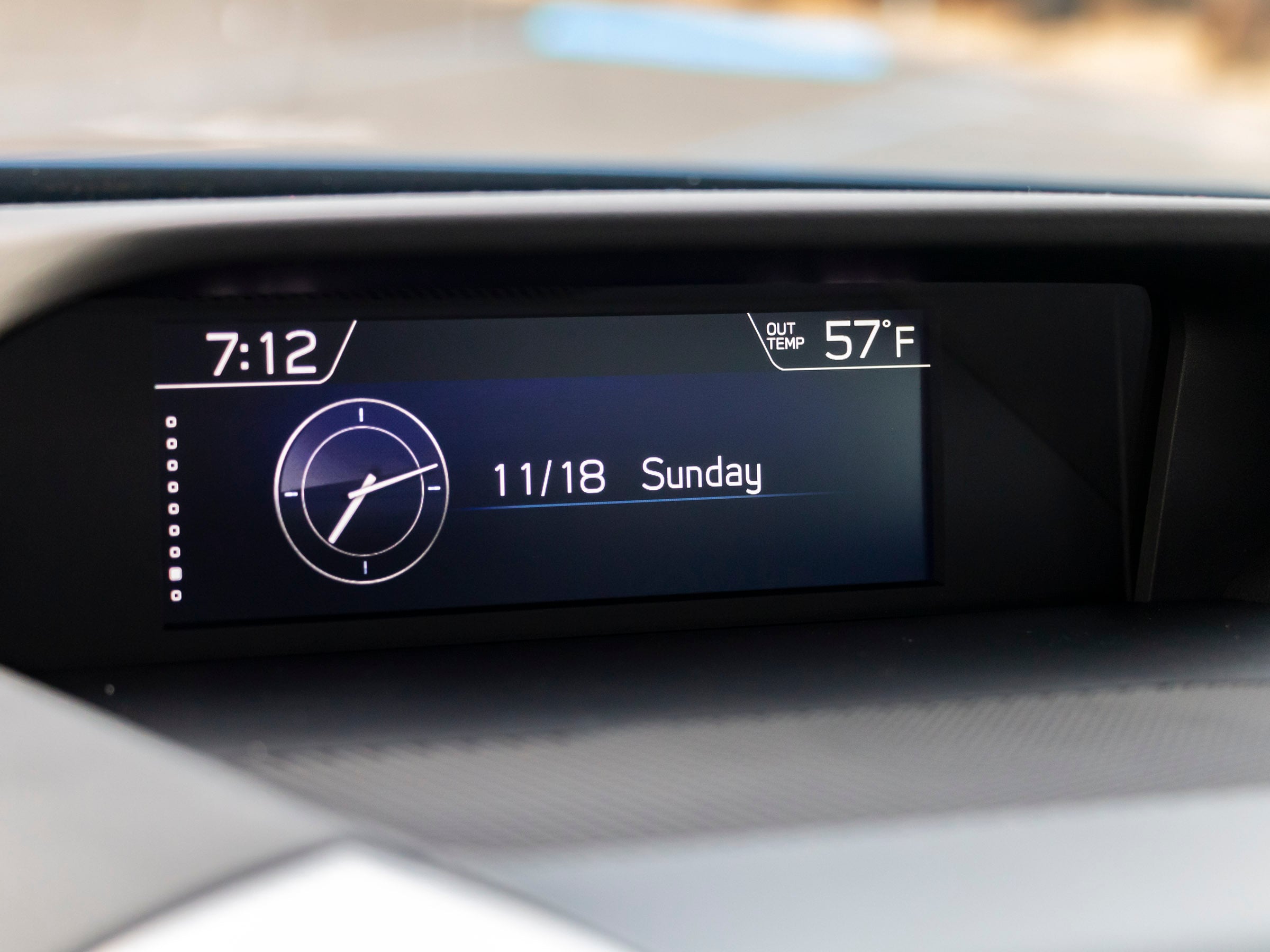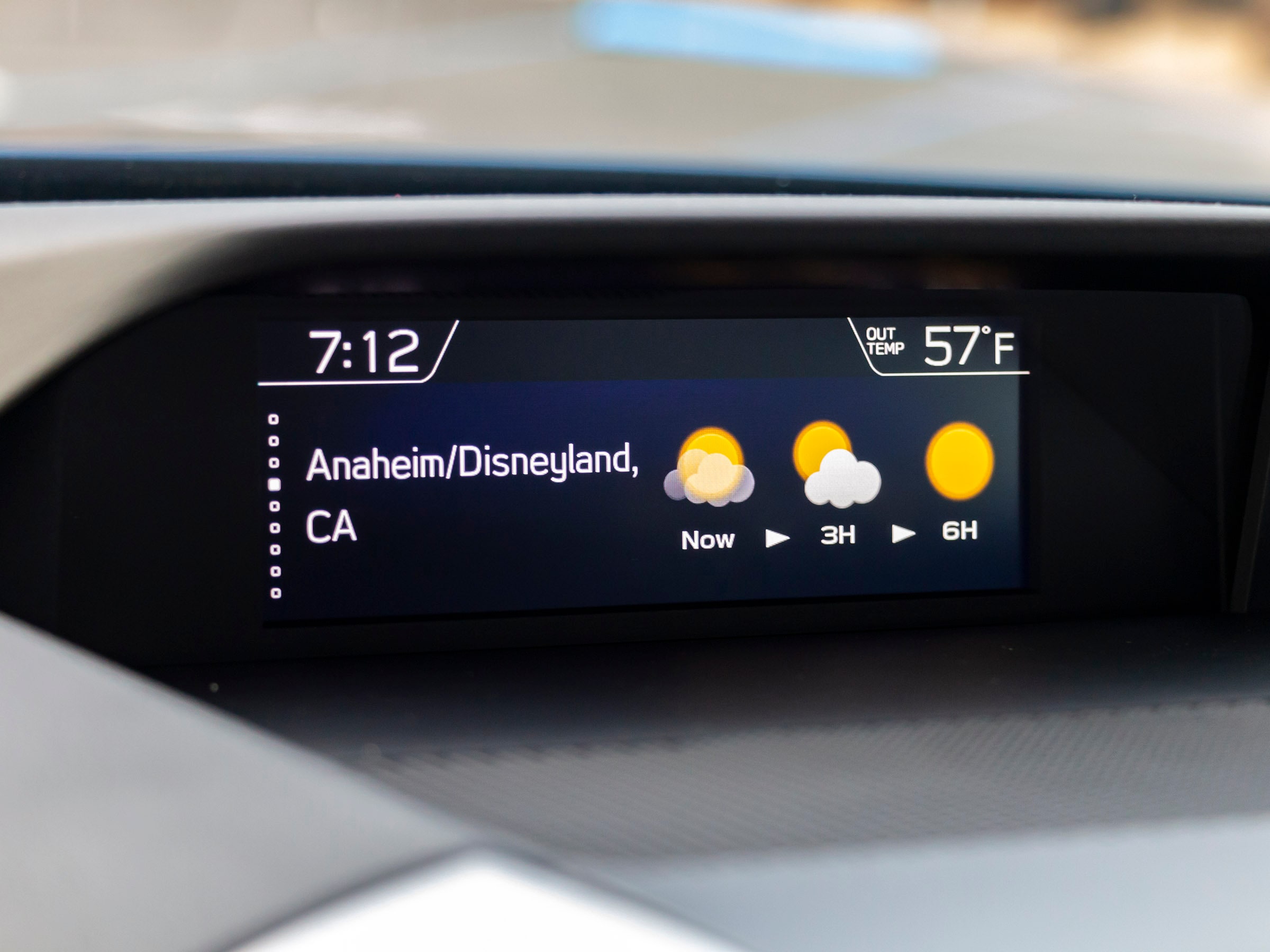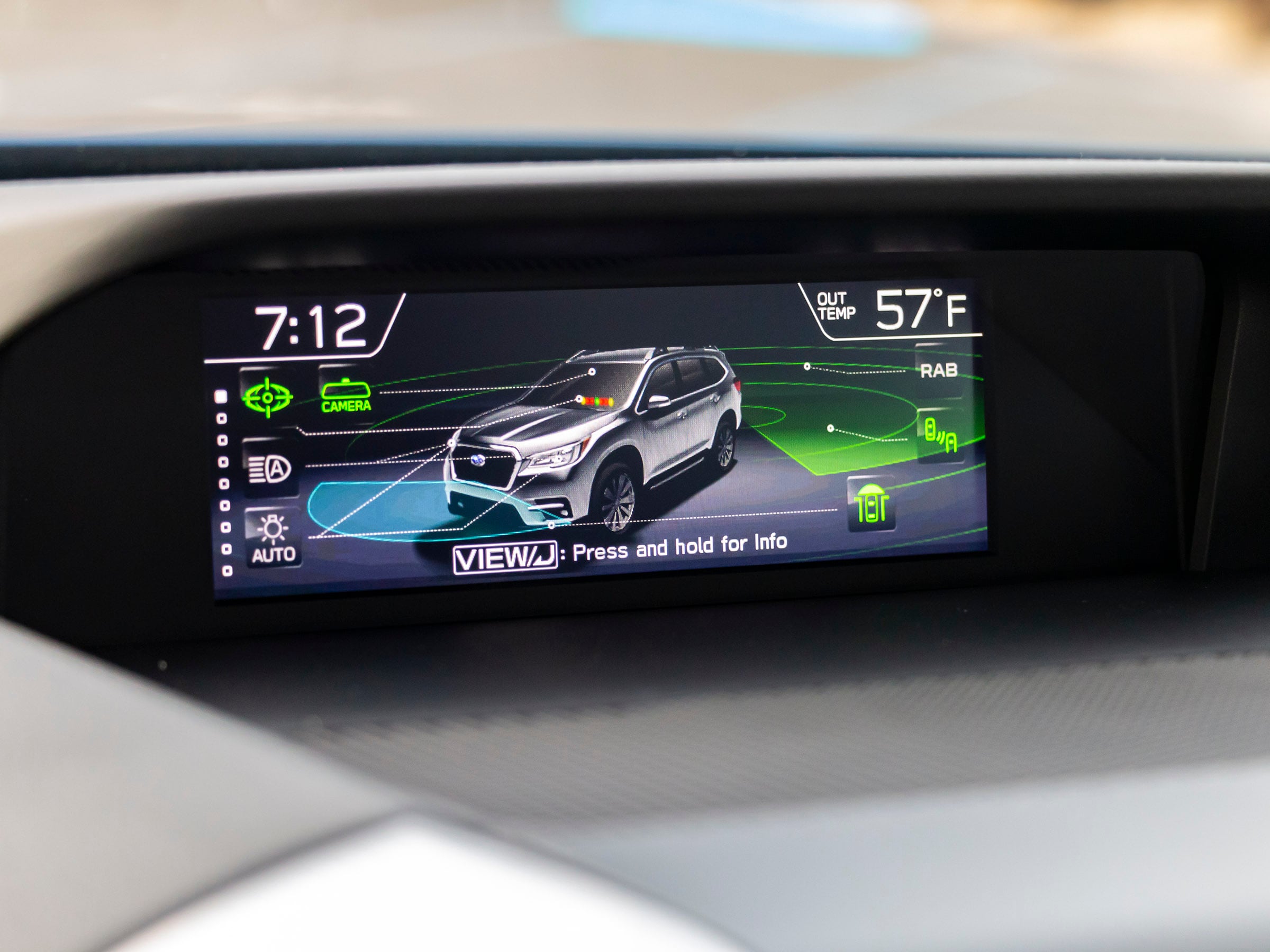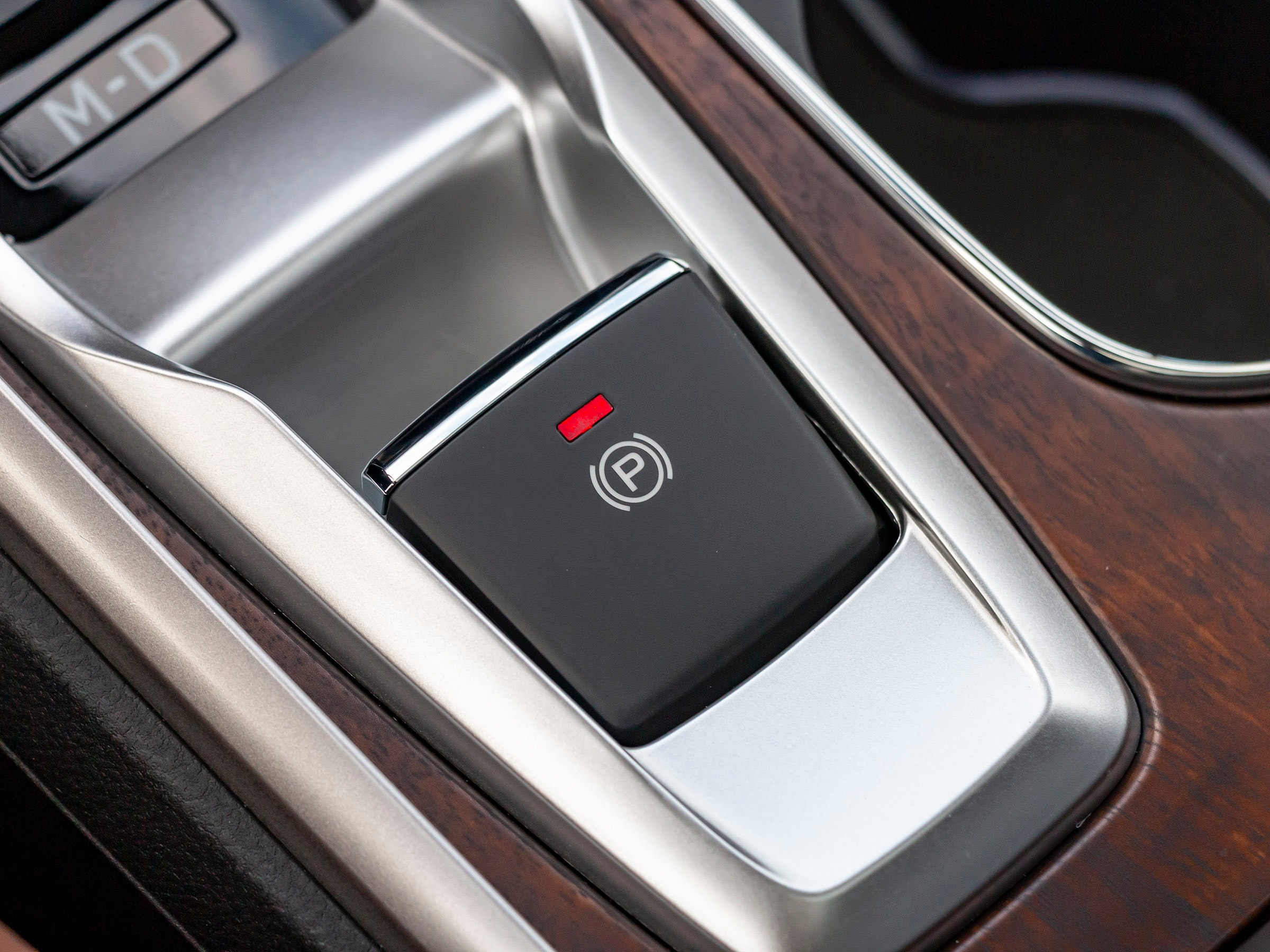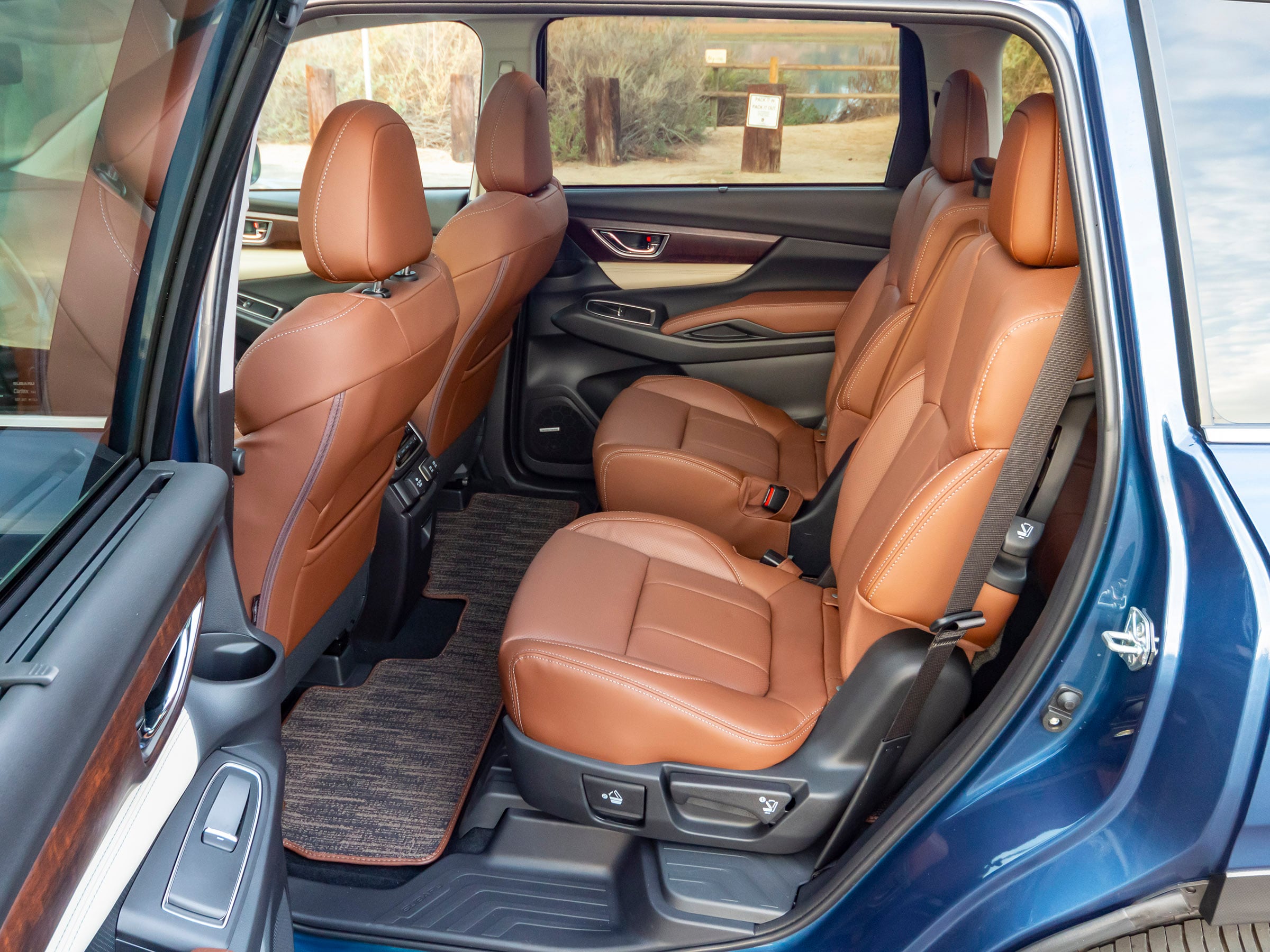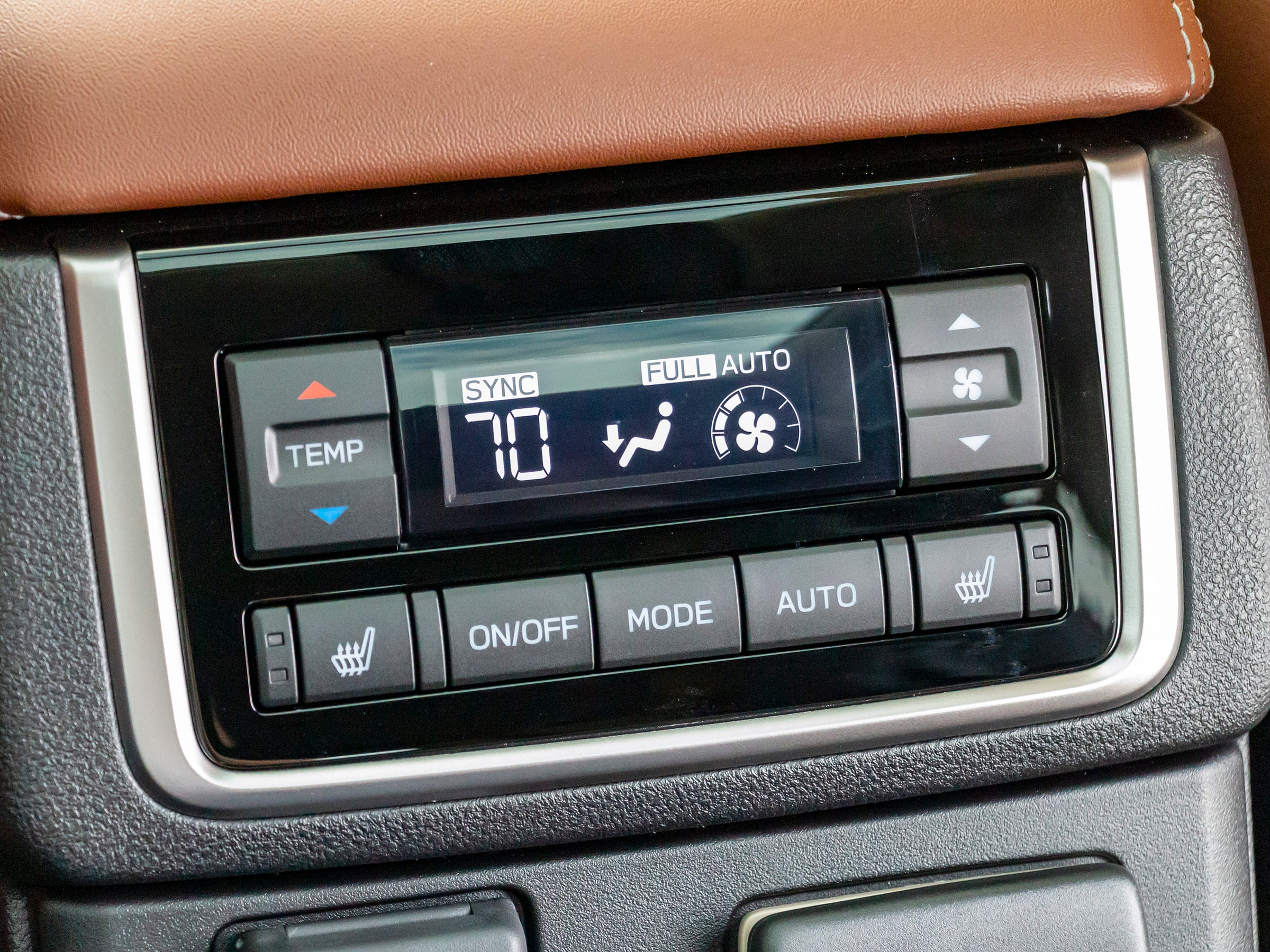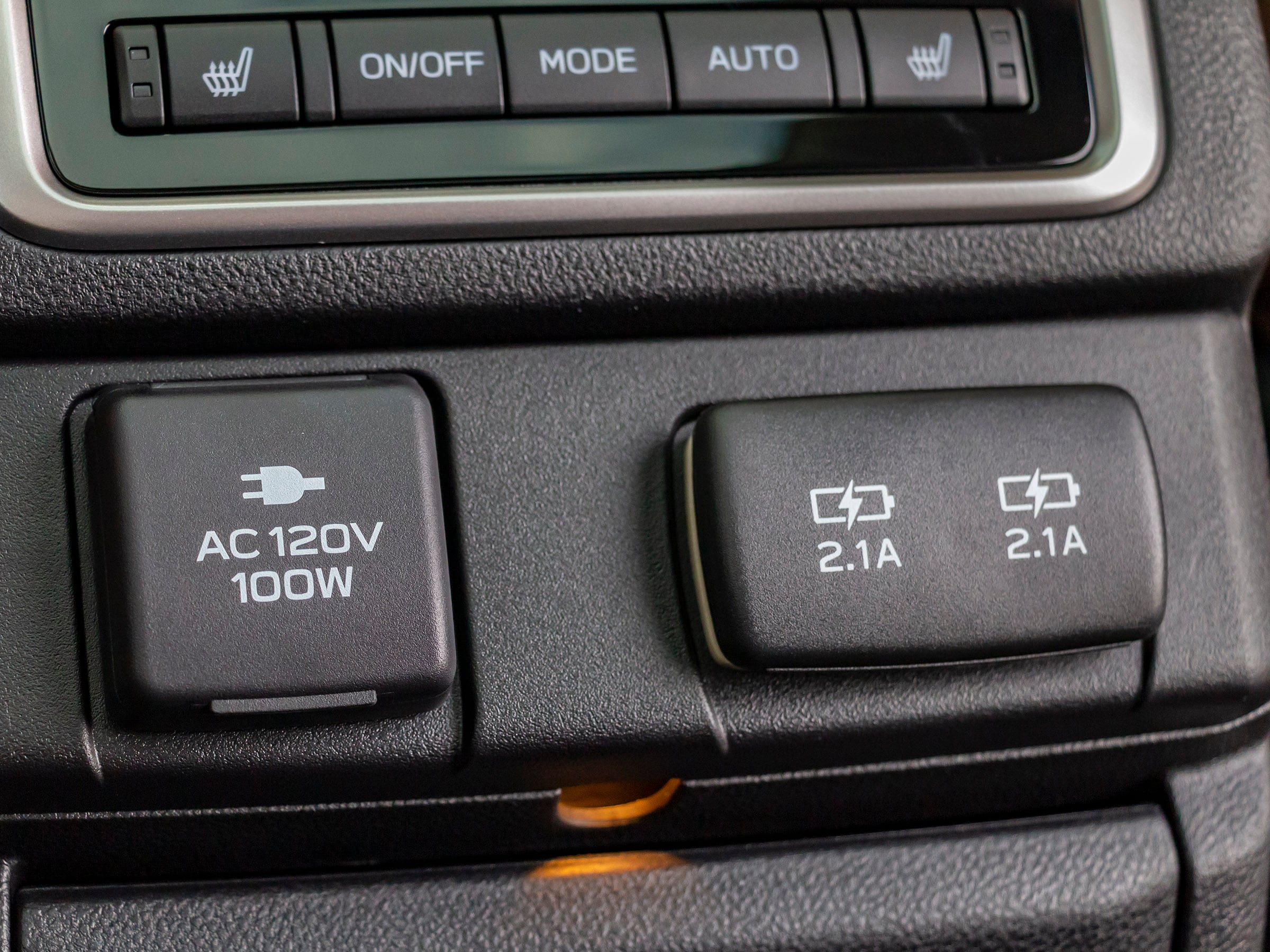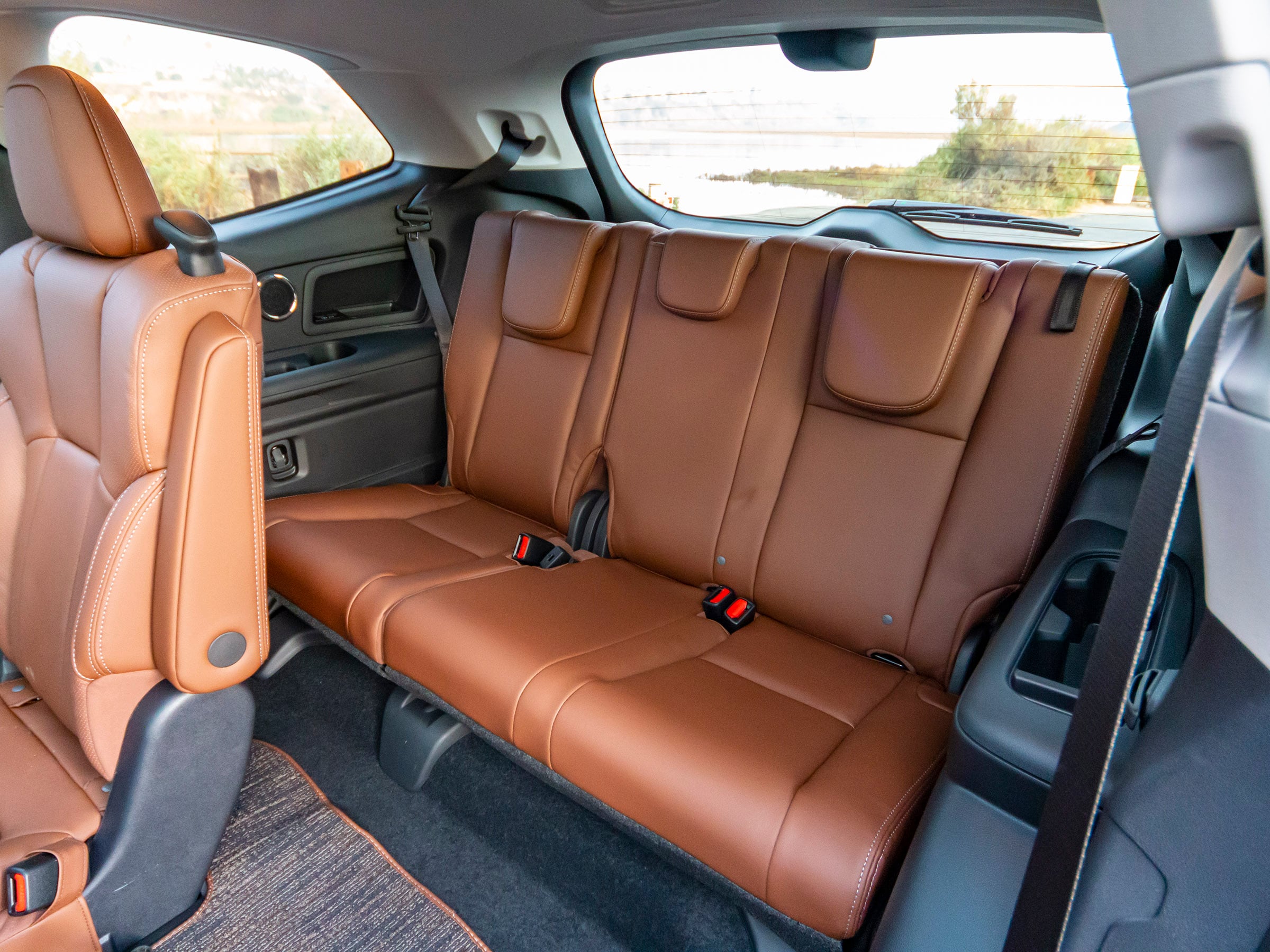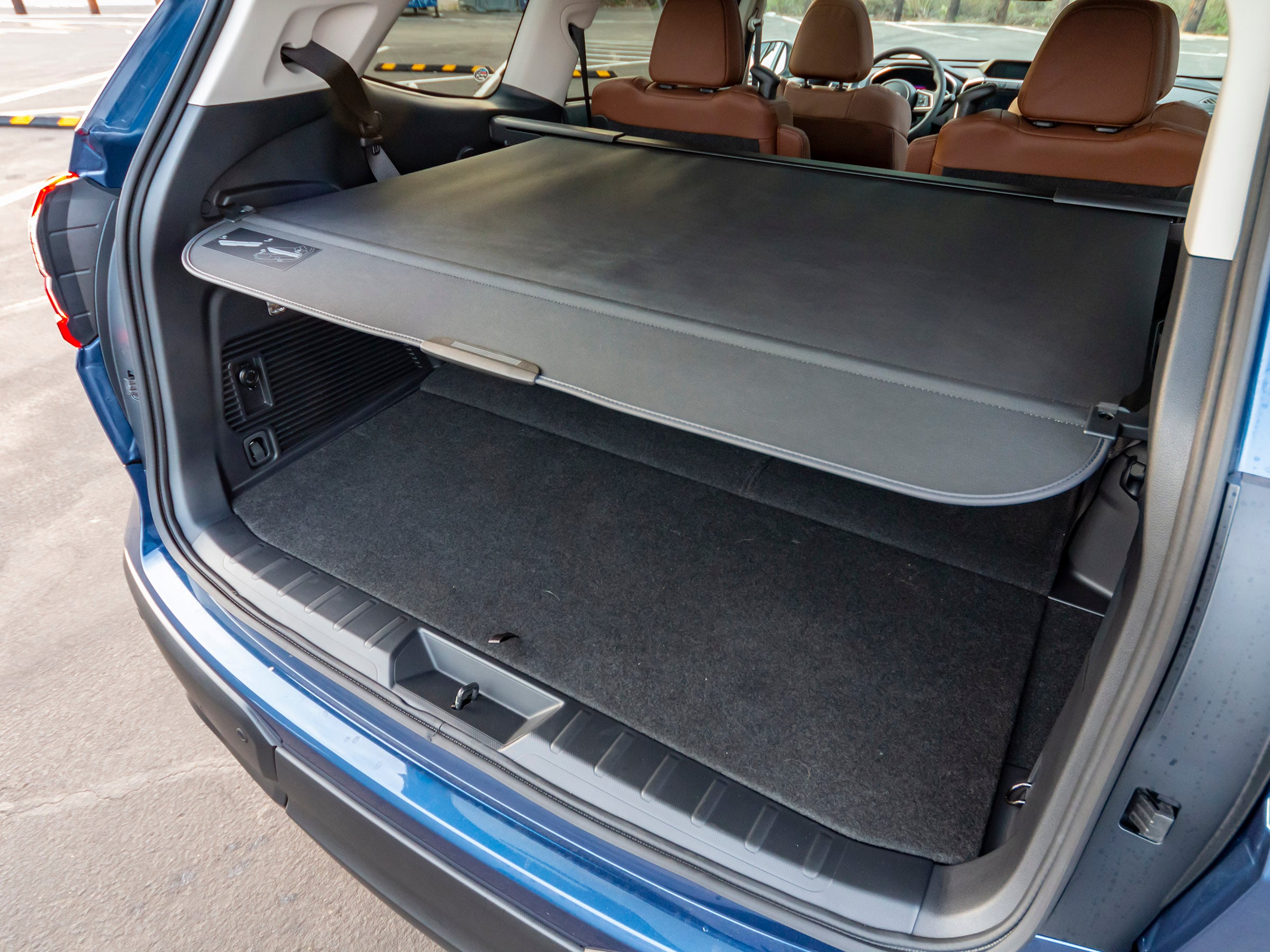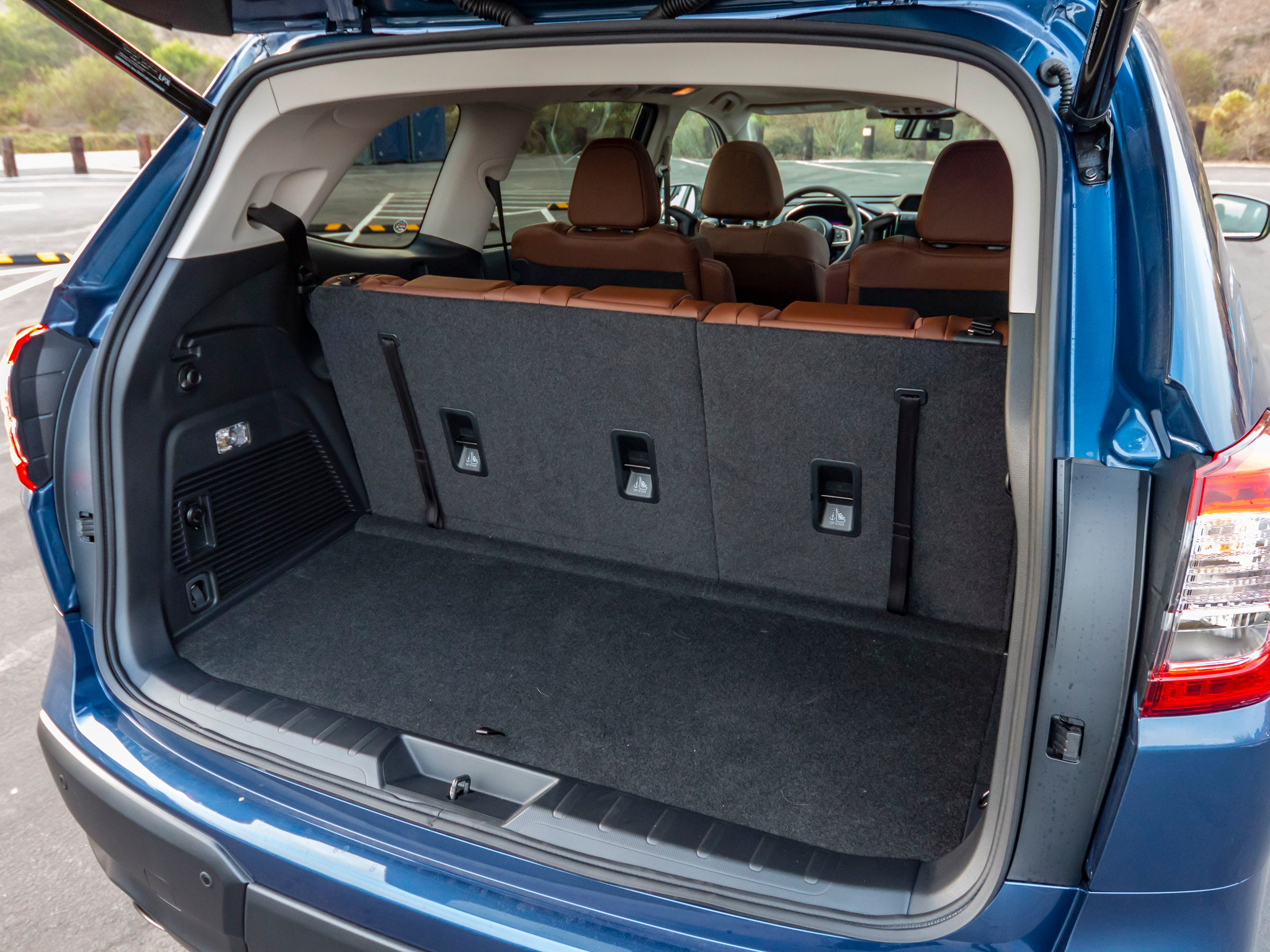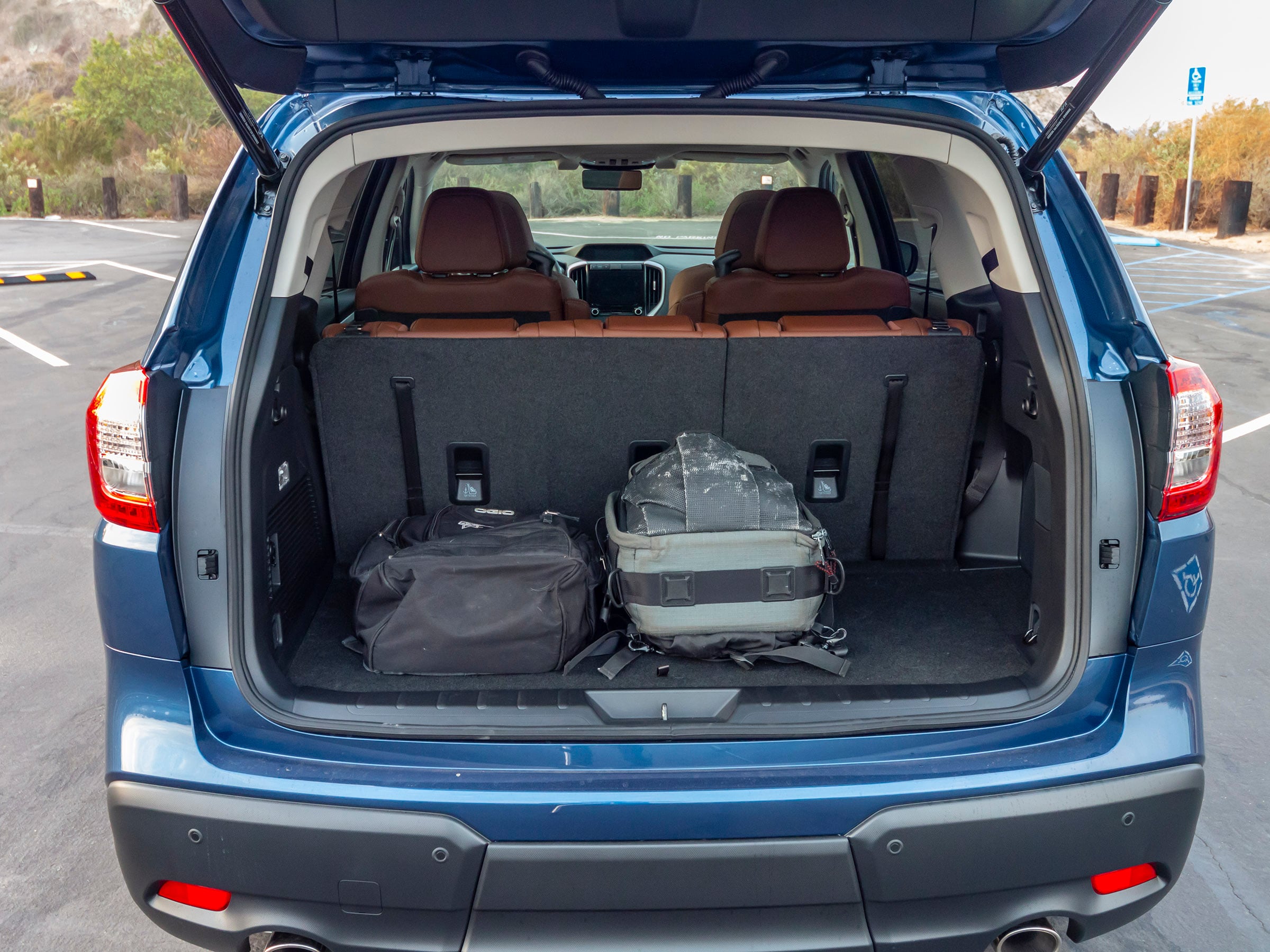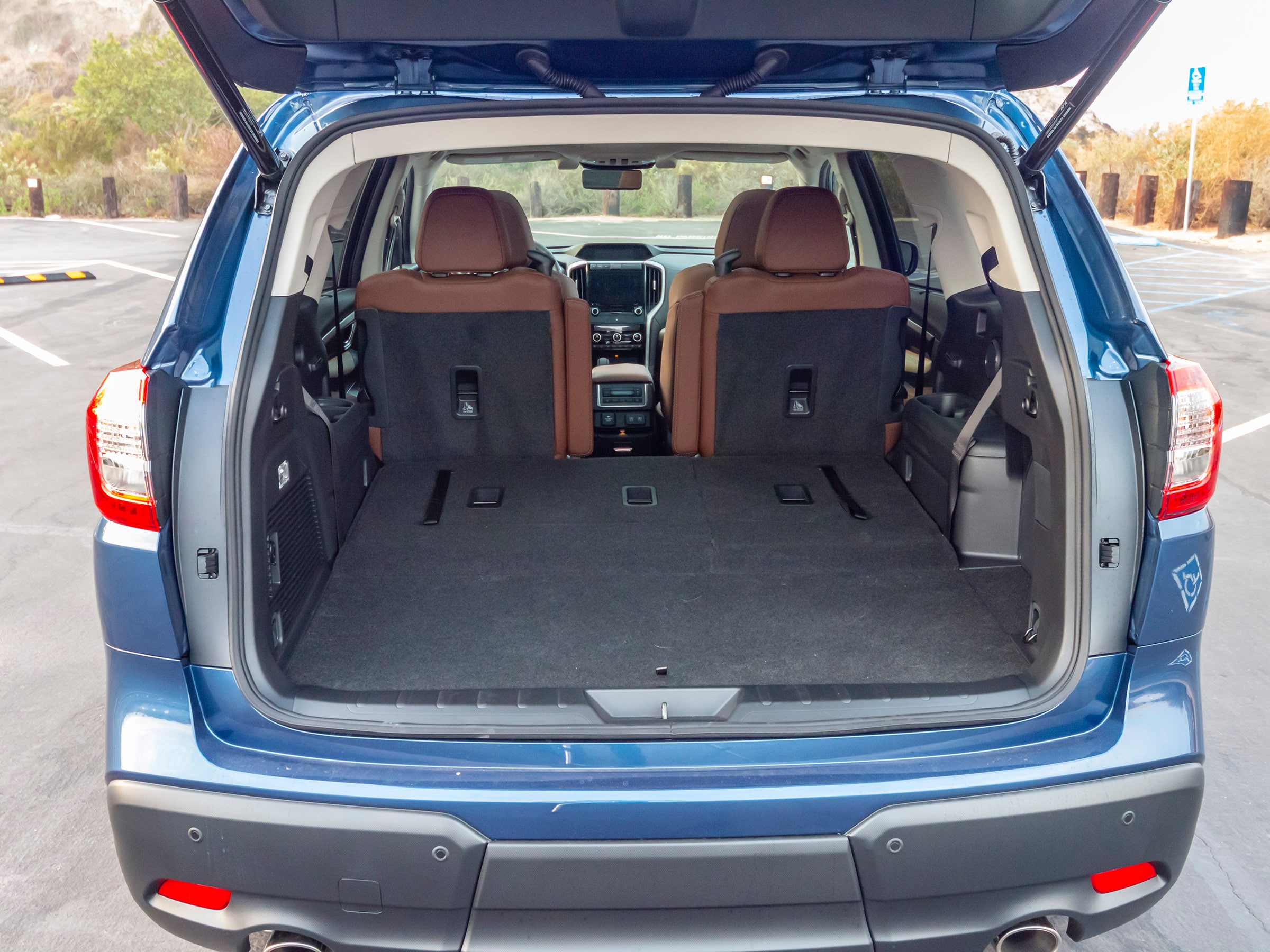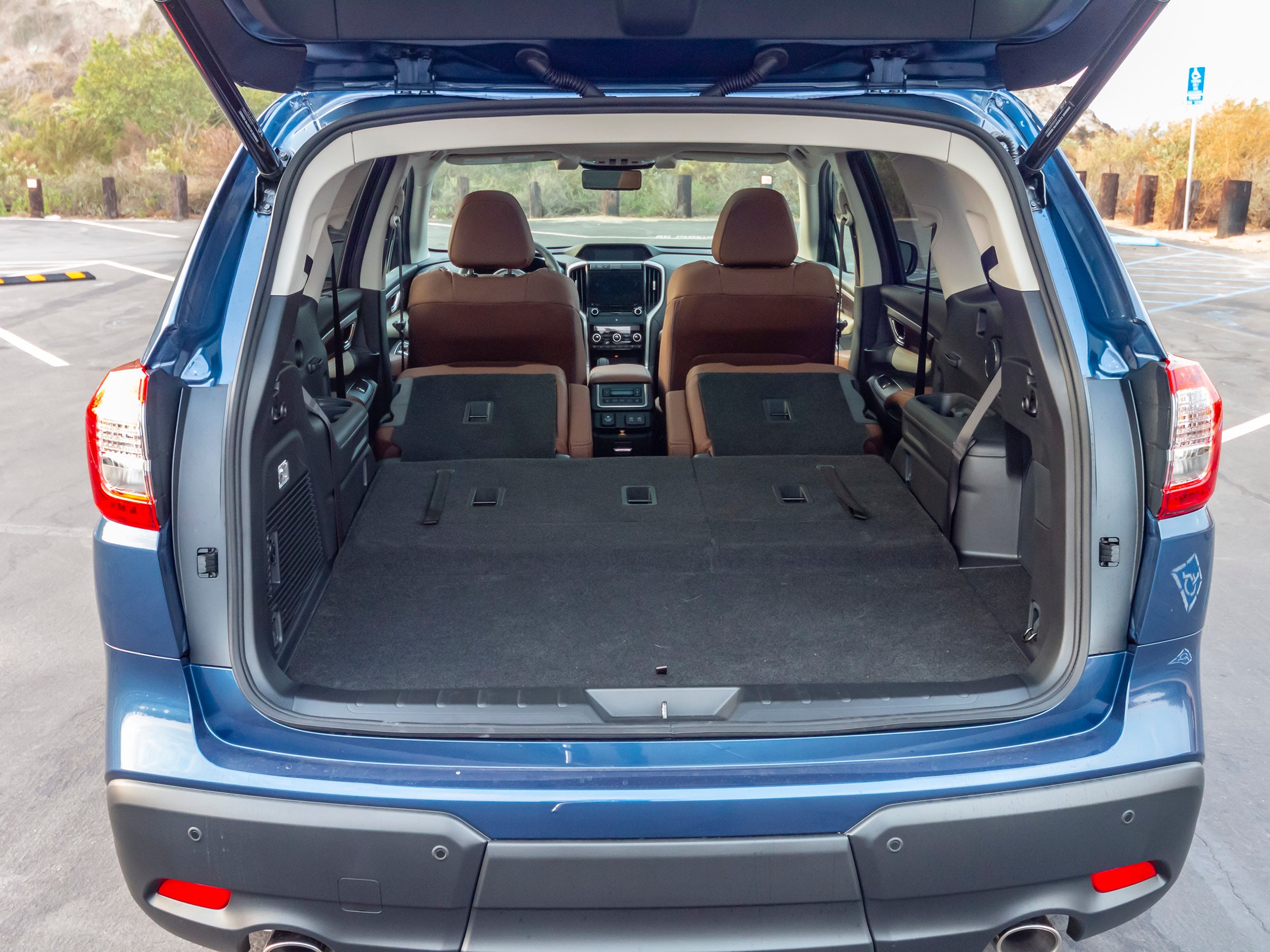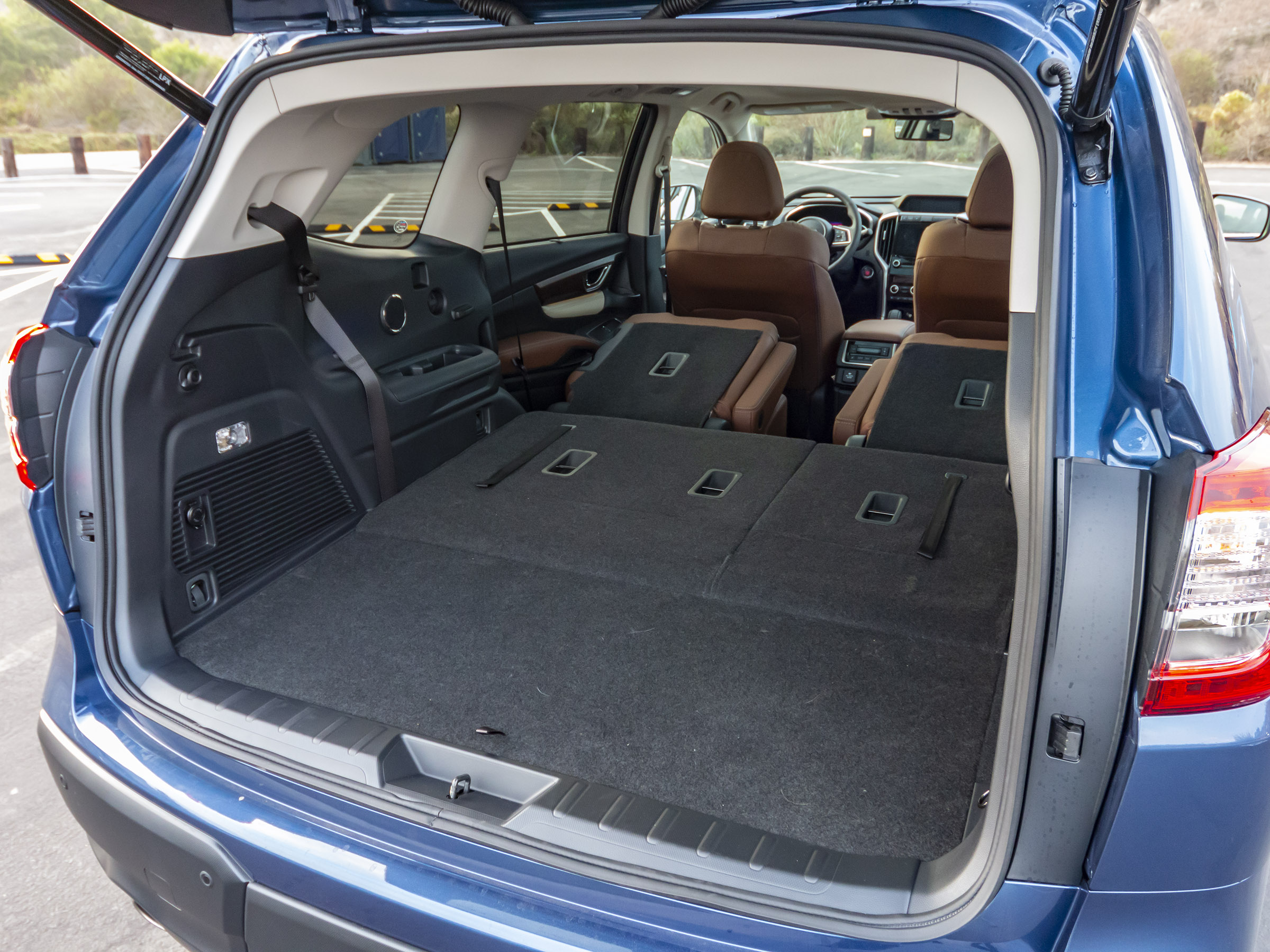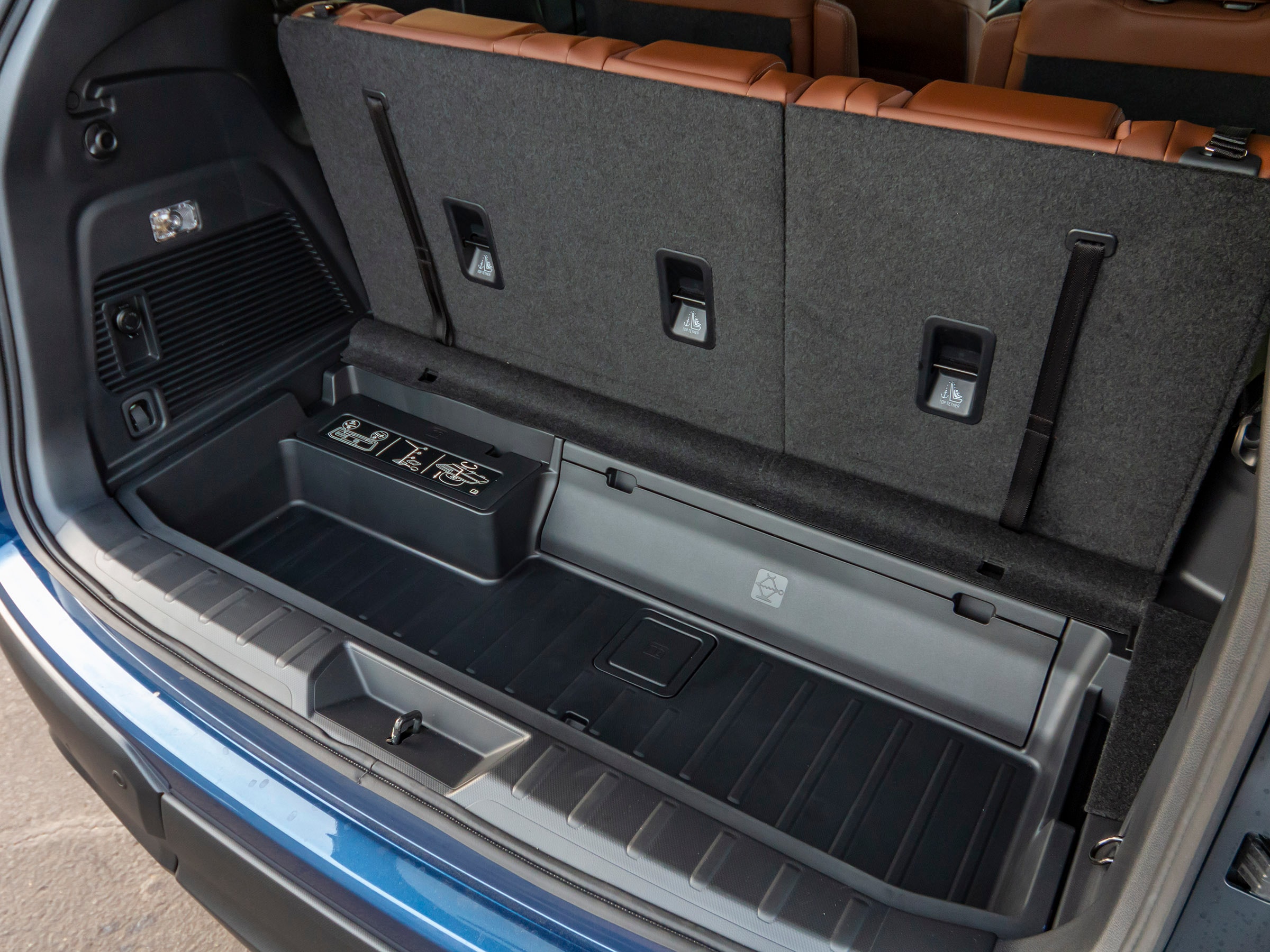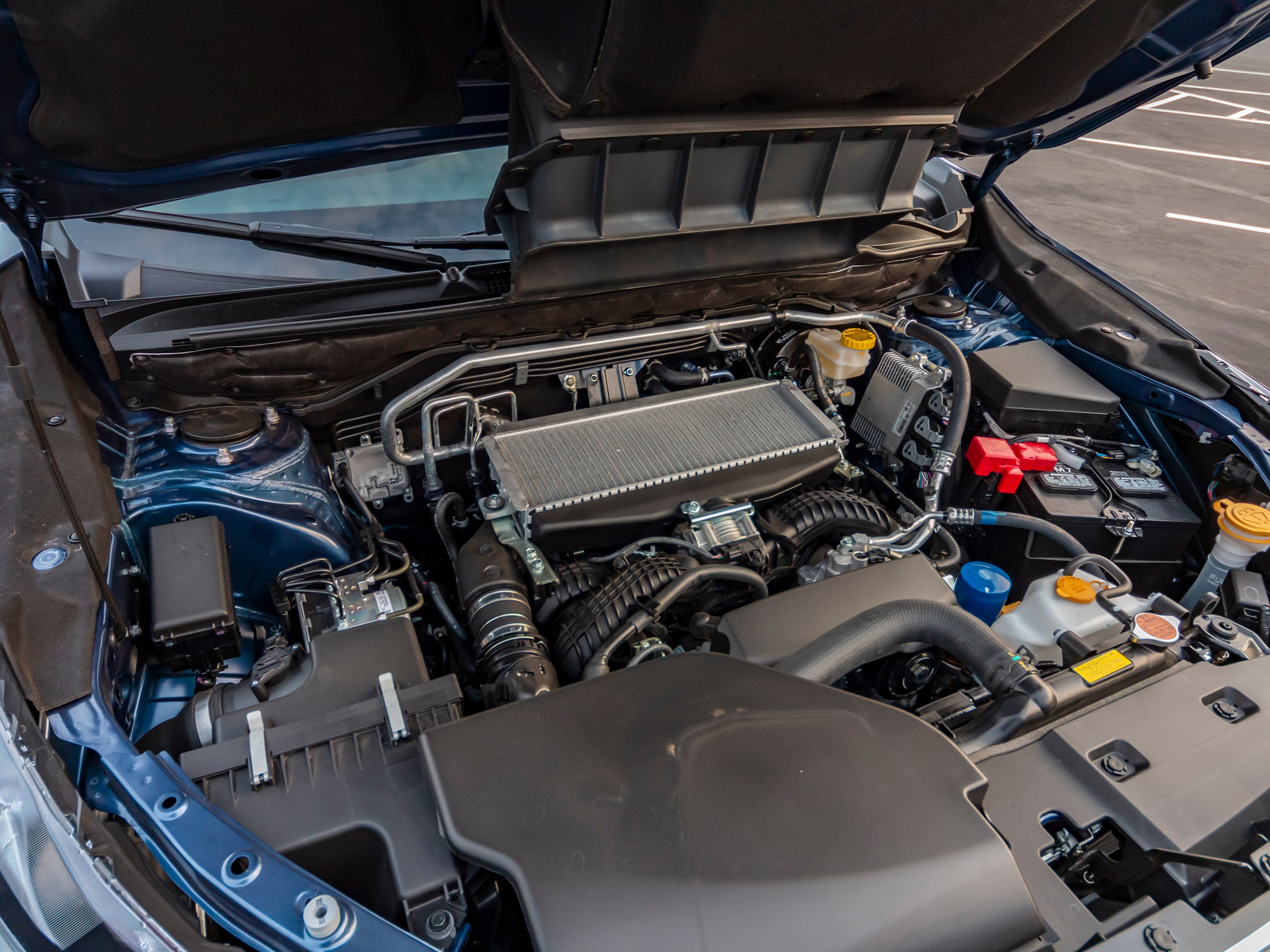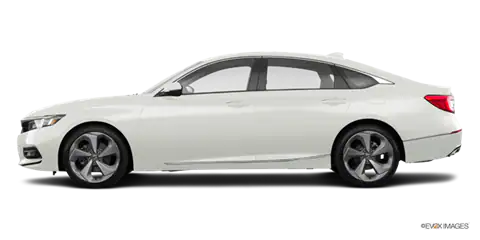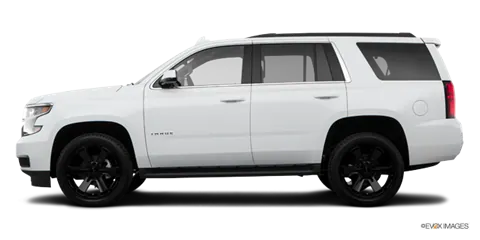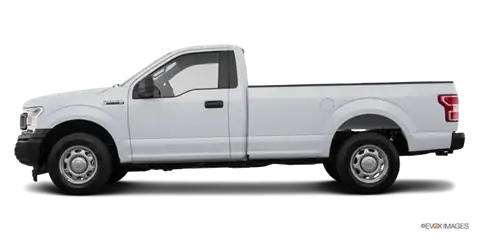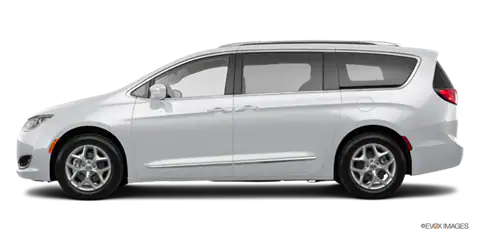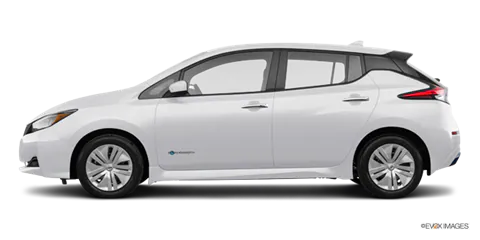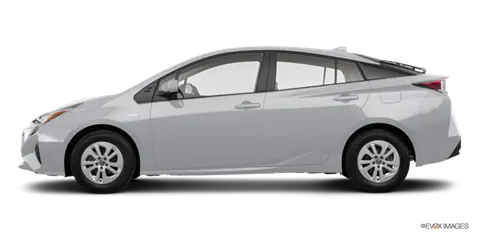We’re spending 12 months with this Subaru Ascent, reviewing the full ownership experience with ongoing updates. The Subaru Ascent is one of KBB’s 12 Best Family Cars for 2019, and is one of KBB’s favorite new models for 2019.
Wrap-Up
by Allyson Harwood on December 17, 2019
Price: $45,670 | Price yours
Final Odometer: 20,839 miles
Best MPG: 24.78
Worst MPG: 15.34
Lifetime MPG: 19.20
Total Maintenance/Service Costs: $39.95
Time out of Service: 0 days
If you’re sad to give back the keys after a year of driving a vehicle, that’s a strong sign that it was a car that meshed well with you and your needs. That was how I felt when I handed over the keyless remote fob to Subaru. It’s not quite as symbolic as tossing them a set of jingling keys, but the feeling was the same. Our time with the versatile, comfortable 2019 Subaru Ascent had come to a close. Putting nearly 21,000 miles on this long-term vehicle taught us a lot about what it was like to live with the Ascent every day, and while it delivered on most of its promises, we also discovered some quirks, as well as some pleasant surprises.
Power vs. Fuel Economy
Even though some other 3-row midsize SUVs offer a choice of engines and front- or all-wheel drive, the Subaru comes with one combo: a 260-horsepower, 2.4-liter turbocharged flat-4 engine with an 8-step continuously variable automatic transmission (CVT), and all-wheel drive. On the plus side, that means you don’t have to pay extra for the more powerful engine or for AWD, as you do in other vehicles. The downside is that you can’t choose a noticeably more fuel-efficient version of the Ascent. The best you can get is an EPA-rated 21 mpg city, 27 mpg highway, for 23 mpg combined and an overall range of 444 miles on a single tank. Pick the Limited or the Touring (as we did), and fuel economy goes down one mpg across the board with a 425-mile range.
When you accelerate, there’s a burst of power from the turbocharged engine, making it very easy to get to freeway speed. However, the KBB staff noted that power delivery was a little uneven after that. It’s certainly not a deal-breaker, but it does take some getting used to. We believe the uneven power delivery is likely due to the use of a CVT instead of a traditional automatic transmission, a move Subaru made to improve fuel economy. The truth is that if you take advantage of the power the turbocharger offers, fuel economy will suffer. Admittedly, I gave in to the allure of the turbo, and the worst fuel economy of 15.34 mpg is the result. However, when I took the Ascent on a road trip to Lake Tahoe, we took advantage of the long straight highway sections and netted an impressive 24.78 mpg. That’s almost up to the Ascent Touring’s highway rating of 26 mpg and far above the 22 mpg combined rating. It can be done; you just need more self-control than I have.
Interior Comfort and Amenities
The Ascent did an excellent job of carrying people and gear throughout the year. Family came into town, and the Ascent was assigned as tour bus, airport shuttle, and cargo hauler. It was so comfortable some family members fell asleep on the way home from tourist attractions in Southern California. The soft leather seats and seat heaters and coolers served us well, and we were glad to have both features. Believe it or not, it does get hot and cold in California, and the Ascent spent a bit of time in the snow, too.
The interior controls were logically placed, and easy to use while driving. We like that there’s a tuning knob in addition to a volume knob, and there are plenty of hard buttons. We have seen some systems that depend too much on touchscreen use, so we hope Subaru sticks with its current system. (It’s also one of the few vehicles that still has a CD player, which we happily used.) We had a few problems with the Apple CarPlay interface throughout the year: calls where one party couldn’t hear the other, podcasts would stop, the system would crash. A software update fixed many of the issues, but the system could still use some fine-tuning.
Rear cargo storage was intuitive, and we made frequent use of the storage bin that’s hidden under the cargo floor. There are also convenient Velcro straps that keep the cargo floor raised while you place smaller items in the bin. It was fairly easy to get into the third row of seats and raising and lowering both rows was a breeze. As is the case with most SUVs, the cargo area is carpeted, which cuts down on interior noise, but cargo easily slides around. We’d recommend getting a rubber cargo mat that’s designed for the Ascent cargo area. They’re available at Subaru dealerships, among other places.
Safety
Subaru offers an excellent variety of safety features, and we were happy to know the Ascent came equipped with such an impressive list of them. The centerpiece of the system is EyeSight, which includes adaptive cruise control, pre-collision braking, pre-collision throttle management, and lane departure and sway warning with lane-keep assist. At first, you might get annoyed when you hear the beeps and tones that you hear if you drift a little out of the lane, or if the lane-keep assist can’t “see” a painted line on both sides of the vehicle, but you get used to it, and this feature encourages you to be more aware of the Ascent’s place in the lane. (As I learned, if you stay in the lane, you hear fewer beeps.)
Lead Vehicle Start Alert is a cool feature that can keep daydreamers aware of their surroundings. If you’re stopped at a red light or in traffic, this lets you know if the car ahead of you is moving. It doesn’t chime until the car ahead has gone 10 feet and you still aren’t moving. It’s a feature we’d like to see in more vehicles.
With all of this tech, it should come as no surprise that the 2019 Subaru Ascent earned a 5 Star rating from the National Highway Traffic Safety Administration (NHTSA) and is an Insurance Institute for Highway Safety (IIHS) Top Safety Pick+.
Reliability
The short answer: we had zero problems with vehicle reliability over the year KBB had the Ascent. We took it in twice for service, and there were no mechanical issues and no recalls. Better yet, our Ascent was part of Subaru’s “Maintain the Love” program, where scheduled maintenance is complimentary for the first 2 years or 24,000 miles. The only money we paid was to have a windshield crack repaired.
That reliability translates into strong resale value. The 2019 Subaru Ascent was on the podium for KBB’s Best Resale Value Awards for the best three-row midsize SUV, boasting an impressive 59.2 percent resale value at 36 months and 44.3 percent at 60 months. Only the Toyota Highlander did better in that category.
Wish List
We thoroughly enjoyed our year with the Subaru Ascent, and would highly recommend it to people who are shopping for a 3-row midsize SUV. But no car is perfect, and we do have a little list of things that could make the Ascent even better. For starters, reprogramming the transmission could smooth out the power delivery. Also, with all of the safety features the Ascent came with, we’d love to see the addition of a 360-degree birds-eye view camera. In addition, there is a head-up display, but it only shows details about EyeSight. It would be nice to see Subaru take further advantage of this screen with more driver information. Finally, the seat heaters aren’t all that powerful. We’d like to have more heat, specifically in the seatbacks.
During our year with the Ascent, we enjoyed the warm, welcoming feeling of the cabin and found this Subaru to be a perfectly agreeable daily driver and road-trip vehicle. This is an easy vehicle to recommend, with its combination of comfort, power safety and versatility. It’s a great 3-row midsize SUV, and it hasn’t been gone long, but we are already missing it.
Should I get the 2019 or the 2020 Ascent?
by Allyson Harwood on November 25, 2019
Price: $45,670 | Price yours
Current Odometer: 20,272 miles
Latest MPG: 19.94
Lifetime MPG: 19.21
Maintenance/Service Costs: $39.95
Time out of Service: 0 days
It’s that time of year when dealerships are getting in new models and offering deals on the outgoing ones. For some models and in some years, those year-to-year changes can be pretty dramatic, and it can be a better value to get a new model with more features than to save a little money on the previous model.
In the case of the Subaru Ascent, there aren’t big changes for 2020, but there are a couple of things that might be worth considering.
For 2020, the Ascent adds a rear-seat reminder alert system. Here’s how it works: Let’s say you open one of the back doors to put your child in the car seat or to put your pet in the back row, then you close the door, get in, and drive somewhere. When you get to your destination, if you don’t open that rear door again the Ascent will alert you that you may have forgotten something in the back seat.
The other cool feature is an optional power rear gate lock. If you have already gotten everything else out of the Ascent and all you have left to do is empty out the gear in the cargo area (say, bags of groceries), when you’re done getting everything out of the Ascent, push the button on the liftgate and the vehicle will lock for you.
As far as incentives are concerned, we did a quick check of Subaru’s website and saw that deals on 2019 models are becoming scarce. You can find low financing and one lease deal, but these aren’t much better than the offers you can find for the 2020 model. And the difference in Fair Purchase Price between the 2019 and the 2020 is about $900-$1,100, depending on the trim level. So you can get into a 2019 for a little bit less money, but you won’t get the added features of the 2020. While we have been very happy with the 2019 Ascent, these features would make getting a 2020 worthwhile.
Off-Road Capability
by Allyson Harwood on November 14, 2019
Price: $45,670 | Price yours
Current Odometer: 19,628 miles
Latest MPG: 19.81
Lifetime MPG: 19.19
Maintenance/Service Costs: $39.95
Time out of Service: 0 days
While most people won’t do much off-roading in a 3-row midsize SUV, it’s comforting to know that your vehicle is capable of getting you and your family through rougher terrain. The Subaru Ascent is well equipped to do just that, with 8.7 inches of ground clearance and standard all-wheel drive. Earlier this year, we had the chance to test out the Ascent’s off-road chops on a trail in Oregon. (It wasn’t Kelley Blue Book’s long-term Ascent, but it had the identical equipment and was the same trim level.)
The Ascent offers excellent visibility, which is always helpful when you’re driving on a dirt road. And the ground clearance, which is among the best you can get in any midsize 3-row SUV, made us less concerned about whether the Ascent could clear smaller rocks and ruts along the way.
But one of the nicest elements of the Ascent’s off-road equipment is its X-Mode system, which comes standard on every trim level. This includes hill descent control as well as a system that uses electronics to make the all-wheel drive perform its best on the terrain you’re currently on. Hill descent mode lets you drive down a steep hill at a consistent low speed without having to ride the brakes. It does the braking for you. When you push the button for X-Mode, it makes the best use of the engine power, brakes, transmission and which wheels receive torque through the AWD system. When X-Mode is activated, you’ll get the most traction possible in the Ascent, and more power at lower gears.
We were impressed with the Ascent’s capability on a mild-to-moderate trail. We put the Subaru in situations where one tire was slipping in mud, and X-Mode shifted power to the wheels that were climbing over solid ground, getting us through that portion of the road with ease. The Ascent was sure and steady when climbing dirt roads, and the hill descent control worked flawlessly. We could even use the Ascent’s inclinometer to show angle the vehicle while on hills. You won’t need X-Mode in most driving situations, but if you ever find yourself in the mud, snow, sand or ice, it’s there to help you get through.
The Advantages of Proper EyeSight
by Allyson Harwood on October 28, 2019
Price: $45,670 | Price yours
Current Odometer: 19,298 miles
Latest MPG: 15.82
Lifetime MPG: 19.18
Maintenance/Service Costs: $39.95
Time out of Service: 0 days
Subaru has earned a strong reputation for safety, and we have spent almost a year having the comfort of knowing that the Ascent’s safety systems are there. EyeSight includes such features as adaptive cruise control, pre-collision braking, pre-collision throttle management, and lane departure and sway warning with lane-keep assist. The idea behind EyeSight, and similar systems from other manufacturers, is that there are two essential elements to safety: protecting everyone in the car in the event of an accident; and preventing an accident from happening in the first place.
There are some things about the EyeSight suite of features that take some getting used to. If you drift a little out of the lane, it will beep at you. If the lane-keep assist feature, which uses the side lines of a lane to keep the Ascent centered in the lane, can’t “see” a painted line on both sides of the vehicle, it’ll chime at you. But once you get used to that – and we did in a very short amount of time – you appreciate how well it works and it makes you a better driver in the process. (You stay in the lane, you hear fewer beeps.)
One of the features we appreciate daily is called Lead Vehicle Start Alert. If you’re stopped at a red light or in traffic, this lets you know if the car ahead of you is moving. It doesn’t chime until the car ahead has gone 10 feet and you still aren’t moving. The cynical way of looking at this is as a “Stop texting and drive!” alert. Whether you are texting, changing a radio station or daydreaming, this alert will help you refocus on the traffic in front of you.
But on a few different occasions we saw a graphic show up on the driver information screen that EyeSight had been disabled. The indicator came on when driving toward the setting sun, then turned off again within seconds. When you get used to having that safety net there all the time and you see that light come on, it’s a little alarming when you know that it’s temporarily gone. The good news is that this only happened three times, it was only disabled for 20-30 seconds each time, and the system reset on its own.
Looking Good as New
by Allyson Harwood on October 14, 2019
Price: $45,670 | Price yours
Current Odometer: 19,043 miles
Latest MPG: 19.31
Lifetime MPG: 19.23
Maintenance/Service Costs: $39.95
Time out of Service: 0 days
This past summer, Kelley Blue Book’s long-term Subaru Ascent was damaged in a hit-and-run collision. And if you have ever had someone else hit your car, every time you walk to your car in the parking lot, you see that scar, and it’s a reminder of the accident. But we knew that repairs were coming. We took the Ascent to Tustin Ranch Collision, where they inspected the SUV and determined the cost to remove the dents, scratches and creases from the rear driver-side door. Fortunately, it was a low-speed collision and there was no structural damage to the vehicle.
The Ascent spent a few days camping out at the collision center, as they repaired the damage and carefully matched the paint to the rest of the vehicle and blended it. While collision centers have access to the exact paint color that a vehicle came in from the factory, they also have to account for any fading or changes that may have happened to a car’s paint since it was brand new. For instance, if a car is parked outside for long stretches of time, the paint might not be the same exact color as it was in the showroom.
When we went back to pick up the Ascent, we were thrilled with the results. There were no signs of damage, and the paint looked identical to the rest of the vehicle. The only thing they recommended – which we gladly pass along to anyone who’s car is going to have repairs done – is that the paint will take a while to cure. You’ll want to avoid drive-through car washes for at least a month. You can take it to a hand-wash facility, or get out the bucket, soap and sponge and spend part of a Saturday afternoon washing it in the driveway.
Apple CarPlay Update
by Allyson Harwood on September 27, 2019
Price: $45,670 | Price yours
Current Odometer: 18,440 miles
Latest MPG: 18.72
Lifetime MPG: 19.25
Maintenance/Service Costs: $39.95
Time out of Service: 0 days
For the last few months, we had noticed some Apple CarPlay glitches in the long-term 2019 Subaru Ascent and had spent some time trying to diagnose the possible causes. Before I get to the attempts to solve the problem, here are some of the things that were happening:
- I’d make a phone call, see that the call had connected based on the time elapsing on the Subaru’s screen, and could not hear anything on the phone call.
- People would call me and we couldn’t hear each other.
- Podcasts would get interrupted at what seemed to be random times.
- There would be harsh audio coming out of a single speaker after switching from voice-activated text mode back to the radio.
And the things I tried:
- Replacing the cord with an Apple-specific, high-quality brand-new cord. That didn’t help.
- Updating my phone to see if there was an issue with an out-of-date OS. No luck there, either.
So, fearing there was a problem with either a microphone or a speaker somewhere within the Ascent’s interior, the next step was to go to the dealer and see what was going on. Since we were going there anyway – as you can see in the previous update (below), the Ascent was already due for scheduled maintenance – we asked the technicians at Irvine Subaru to see if they could get to the bottom of it.
After they inspected the various CarPlay components, they looked for any possible updates the Ascent needed for CarPlay. (These are different from a CarPlay update on your phone.) Sure enough, there was an update, which they completed at the same time as the scheduled car service. The CarPlay problems had been intermittent before I brought the SUV into the dealership, but it looks like so far, the CarPlay software update has solved all of the problems I was having.
Second Service and Tire Replacement
by Allyson Harwood on September 14, 2019
Price: $45,670 | Price yours
Current Odometer: 16,701 miles
Latest MPG: 17.03
Lifetime MPG: 19.26
Maintenance/Service Costs: $39.95
Time out of Service: 0 days
The tire pressure monitoring system in our long-term 2019 Subaru Ascent alerted us to a slow leak in the rear right tire. The pressure was one psi lower than the rear left, then eventually two, and the number continued to rise. When it first happened, there was that fleeting hope that the tire simply needed a little air. But that didn’t turn out to be the case. I was adding air every few days, just to keep things safe until I could get the tire replaced. Then, one morning I happened to see something sticking out of the tread of the front RIGHT tire. It was a nail. What are the odds?! Since the Ascent was also due for its second service, we decided to take it into Irvine Subaru and have everything taken care of at the same time. The Subaru’s second service consisted of the same as the first service – namely, oil and filter change, checking the belts and hoses, fluid top-off, brake inspection, and a multi-point inspection. They also replaced the cabin air filter and checked the brakes. And, as was the case with the first service, the charges were covered by Subaru’s “Maintain the Love” program, so we didn’t pay anything out of pocket.
However, tires are not covered, and having two tires mounted and balanced will likely cost more at a dealership than if you price shop and go elsewhere. The advantage of having it done at the dealer, and the reason why we had it done there, was the technicians could do the job at the same time as performing the routine maintenance. The cost of the tires was $363.10, and the dealer waived the $40-per-tire mounting and balancing fee, because both tires needed to be replaced with such low mileage on the SUV. The other advantage to having the tires replaced while the service was done was that the dealer made sure to mount the two new tires in front and the two older (but still flawless) tires in back. They set the pressures of all four tires to match the recommended pressures listed on the doorjamb, and the service was complete.
2019 Ascent vs. 2019 Outback
by Allyson Harwood on August 20, 2019
Price: $45,670 | Price yours
Current Odometer: 16,701 miles
Latest MPG: 18.63
Lifetime MPG: 19.39
Maintenance/Service Costs: $39.95
Time out of Service: 0 days
Over the past several months, we’ve chatted with people who have observed with some surprise that the Subaru Ascent is considerably larger than the Outback. It just so happens we know someone with a current-gen Outback, so we decided to see how they match up – and there’s more to it than just the extra row of seats. So, if you’re curious about the size differences between the 2019 Ascent and the 2019 Outback, read on. (Note: The all-new 2020 Outback has slightly different dimensions, but the size of the new model is similar to the current model.)
Outside
The Ascent is about seven inches longer than the Outback, on a longer wheelbase. This difference is what gives the Ascent more space inside for people and cargo. The Ascent is also almost four inches wider, which makes room for more space in the cabin, another plus for interior space. And even though you can’t necessarily tell from these photos (the vehicles were parked on a slight incline), the Ascent is taller by more than five inches.
Inside
Yes, the Ascent comes standard with three rows, but let’s look at the front two rows as an apples-to-apples comparison to the Outback. There’s a bit more headroom in the Ascent, and while there’s a little less legroom in the Ascent’s front row, there’s more in the second row. And thanks to that extra width the Ascent offers, there’s three inches more shoulder room in the first two rows of the Ascent.
Power and Economy
The Ascent is offered with one engine, a 260-horsepower, 2.4-liter turbocharged 4-cylinder. On the other hand, the 2019 Outback comes with either a 175-horsepower, 2.5-liter 4-cylinder or a 256-horsepower, 3.6-liter 6-cylinder engine. And while the 3.6-liter has almost as much horsepower as the Ascent’s engine, its fuel economy isn’t as good. Also, to get into the least-expensive Outback with the 3.6-cylinder – the 3.6R Limited — actually costs $3,000 more than getting a base-model Ascent. However, if you look at Limited versus Limited trim levels with the most powerful engine, the Outback costs $4,000 less. (The Ascent Limited is $38,995 and the Outback 3.6R Limited is $34,995.)
Best fuel economy goes to the 4-cylinder Outback at 22 combined mpg, while the Ascent’s best mpg is 23 mpg, the Outback with the 3.6-liter 6-cylinder nets 22 mpg combined. (But keep in mind the Outback with that optional engine is an absolute blast to drive.)
Capability
Not only can the Ascent accommodate up to eight people compared to the Outback’s five, but it can tow up to 5,000 pounds, while the Outback can only tackle 2,700. The Outback can handle a maximum of 73.3 cubic feet of cargo, compared to the Ascent’s 86.5. And the cargo space behind the second row is 47.5 cubic feet in the Ascent, to the Outback’s 35.5. Those numbers are in addition to the passenger space in each vehicle: the Ascent’s 154 vs. the Outback’s 108.
Pricing
More vehicle means higher price of entry, so opting for the Ascent will cost you more than getting into an Outback. The 2019 Outback starts at $26,345, while the 2019 Ascent starts at $31,995 (not including destination).
What should you get?
The Outback is Subaru’s best-selling model, and one of the 25-best-selling vehicles in America. It offers a right-sized, two-row alternative to SUVs and is still saturated with Subaru’s wagon goodness. Not everyone needs to lug around an extra row of seats, and they might not need that much cargo space. The Outback is lighter-weight, easier to park, and has an aura of off-road adventure to it. But it’s no 3-row midsize SUV, and for those who want to be able to tow, need to carry more than five people, or just need more space for gear, there’s the Ascent, a great SUV option that still offers that distinctive Subaru personality.
It really comes down to what you want and what you need, and Subaru offers two compelling choices for midsize SUV duty.
Hit and Run
by Allyson Harwood on August 4, 2019
Price: $45,670 | Price yours
Current Odometer: 15,832 miles
Latest MPG: 18.57
Lifetime MPG: 19.37
Maintenance/Service Costs: $39.95
Time out of Service: 0 days
If you read the previous update, you saw that the Ascent was hit by a random rock as I drove back from Lake Tahoe. A mere two weeks later, the Ascent was struck again by a random object, this time a car. The Ascent was parked right in front of my home, and someone in a white vehicle – there was paint transfer, as you can see in the photos – hit the driver-side passenger door, leaving a big crease and deep, white scratches. It happened sometime between dinner the night before, and that morning.
Did they leave a note? No. it’s a shame that people don’t do that these days, but short of waving your fist at the air, what can you do about it?
Did I yell out some frustrations when I saw what happened? You bet. Frankly, I hope the neighbors didn’t hear me.
Anyway, whether or not you know what happened to your car or who did it, we all have to make that decision whether or not to fix it, based on our budget and the necessity of the repair. The door still opens and closes without any squeaks, but we are going to get it fixed. So we will get started on the next steps: getting a repair estimate and talking with the insurance company. We’ll keep you updated, and are looking forward to showing off the Ascent’s nice, smooth undented door. Hopefully, that can happen soon, because every time I see that door, it’s a reminder of what happened.
Warm-Weather Testing
by Allyson Harwood on July 21, 2019
Price: $45,670 | Price yours
Current Odometer: 13,352 miles
Latest MPG: 24.78
Lifetime MPG: 19.36
Maintenance/Service Costs: $39.95
Time out of Service: 0 days
The last time we did a long drive in the long-term 2019 Subaru Ascent, it was in frosty cold weather, unusually cold for Southern California and Nevada. This time around, we went on another long trip to Nevada, but this one was very different. We drove a longer distance – about twice as far – with less down time between drives. It was one of those “there and back” quick trips to attend a family function, and at times the temperature was about 90 degrees warmer than on the Ascent’s first trip.
This trip was to Lake Tahoe, with about 550 miles stretching between home and our destination. As you can see from the photo, the Ascent took on more than its share of road schmutz and bug goo along the way, which was quite a feat considering this was such a short trip. It was a long enough trip, however, that we learned a lot about the Subaru Ascent while driving at altitude and in hot weather.
Some quick observations:
- When you accelerate from low speed, the CVT and turbocharged engine give the Ascent a surge of power that make it easy to pass slow-moving cars and the occasional big-rig.
- This powertrain performs admirably at 7,000-foot-plus elevation.
- We drove through the Mojave Desert and the High Sierras, where temperatures reached 106 degrees. The air conditioning was terrific, keeping the Ascent nice and cool even when a passenger opened a window.
- The lumbar support made the seats more comfortable on the drive, but the cumulative effect of driving 1,100 miles over three days started to make the seat uncomfortable.
- My tall front-seat passenger would’ve liked the ability to lower the height of the passenger seat.
- A small rock that ricochets off a big-rig at freeway speed can chip the badge that’s in the grille. (If you look closely at the image, you can see the Ascent’s new “beauty mark.”)
- This trip provided the best fuel economy yet in our long-termer: 24.78 mpg. Considering the Touring trim level of the Ascent is rated 20 mpg city/26 mpg highway, 22 mpg combined, that’s an impressive number.
Actual MPG vs. Average MPG
by Allyson Harwood on July 5, 2019
Price: $45,670 | Price yours
Current Odometer: 13,352 miles
Latest MPG: 18.44
Lifetime MPG: 19.12
Maintenance/Service Costs: $39.95
Time out of Service: 0 days
With every fill-up of our 2019 Subaru Ascent, we keep an eye on fuel economy for each tank, as well as the overall fuel economy for the duration of our time with this versatile 3-row SUV. And while we include the latest data in every update, there’s a place in the Subaru’s computer that also calculates fuel economy. It’s the “Average Fuel Economy” number, which is one of the key pieces of data that can be displayed on the screen at the top of the dashboard. We wondered how close it was to the actual fuel economy, so we are running an ongoing experiment about it. This is fairly easy to do, as the average fuel economy clears every time you clear the trip odometer. All we had to do was note that number before clearing the trip.
A quick glance at the numbers shows a big difference between fuel economy on road trips, where highway fuel economy is in the mix, and which tanks are when we’re stuck in city traffic.
So far, what we’ve discovered with our experiment is that the vehicle computer is close, but not quite as accurate as when you use the calculator on your smartphone to crunch the numbers. Some were spot on – for one tank, our calculations had the fuel economy at 19.61 and the computer had 19.6. Other fuel economy measurements were a little further off, but not by more than 1.5 mpg. (One example: we calculated 18.68 mpg, while the Ascent’s computer tallied an average mpg of 20.1.)
If you’re particular about keeping track of your Ascent’s fuel economy, the vehicle’s computer reading serves as a good general guideline, but it doesn’t top doing the math yourself.
Windshield Crack Repair
by Allyson Harwood on June 24, 2019
Price: $45,670 | Price yours
Current Odometer: 11,988 miles
Latest MPG: 19.61
Lifetime MPG: 19.13
Maintenance/Service Costs: $39.95
Time out of Service: 0 days
The rock came out of nowhere. Here I was, minding my own business driving home on the 405 freeway when I heard that high-pitched tell-tale “tink” sound when a small rock hits your car’s windshield. From that point on, you simply hope the rock didn’t do any damage and that little sound will soon be a distant memory. However, in this case, our long-term Subaru Ascent’s windshield was cracked by that pesky little rock.
There was some good news, though: the crack was fairly small, it hadn’t gotten much larger after the initial damage, and it was on the passenger side of the windshield, which meant that for the most part it was out of the driver’s line of sight. However, we didn’t want to risk the crack getting bigger and destroying the windshield, so I made a phone call to Safelite and scheduled an appointment.
The had a technician come to our office to inspect the damage and determine the next step. It was a small enough crack that the tech could fill it with resin and stop the crack from spreading. (Note that any time you have your windshield repaired by any company, there’s always a possibility the crack will spread, despite the fix.) He quickly got to work and said that the whole process wouldn’t take all that long. And it didn’t – after he finished sealing the crack, he recommended letting the resin cure in the shade for half an hour or so before driving anywhere.
You may have noticed that even though there’s a photo of the windshield crack, there isn’t one of the repaired windshield. The repair went perfectly, and all that was left was a little hint that there used to be a crack there. You can still see it (just barely), but it was too small to register when I tried to take a photo.
This repair cost less than $40, but prices for repairs or windshield replacement vary. If you need to have it done, check with your insurance company to see if they have a discount you can use. But it’s better to get this done sooner rather than later: it’s a lot less expensive to repair a windshield than having to replace it.
6,000-Mile Service
by Allyson Harwood on June 3, 2019
Price: $45,670 | Price yours
Current Odometer: 11,039 miles
Latest MPG: 22.05
Lifetime MPG: 19.08
Maintenance/Service Costs: None
Time out of Service: 0 days
In our last update, I acknowledged that our long-term Subaru Ascent was overdue for its 6,000-mile service. Once I realized my mistake, I made an appointment with Irvine Subaru, our local dealership. The team there was helpful, highly professional, and quickly took care of the initial paperwork before taking the Ascent in back. They estimated the job would take 1-1.5 hours, and that the service was free of charge. Why? Because our long-term Ascent is part of Subaru’s “Maintain the Love” program, where scheduled maintenance is complimentary for the first 2 years or 24,000 miles. (Want to see what other automakers offer a program like this? Check out KBB’s story on free maintenance.) I walked into the service department’s waiting area, connected to wi-fi, and did some work, as “Let’s Make a Deal” was on in the background on the dealer’s LCD screen TV.
The 6,000-mile service included an oil and filter change, tire rotation, brake inspection, checking the belts and hoses, fluid top-off, and a multi-point inspection. All went well, and even though it was a fairly busy day at the dealer, the Ascent was finished earlier than estimated.
P.S. If you read the previous update, you saw that the maintenance and engine oil reminders weren’t set. As you can see in the latest photo, that has been remedied, ensuring I won’t make the same mistake I made before.
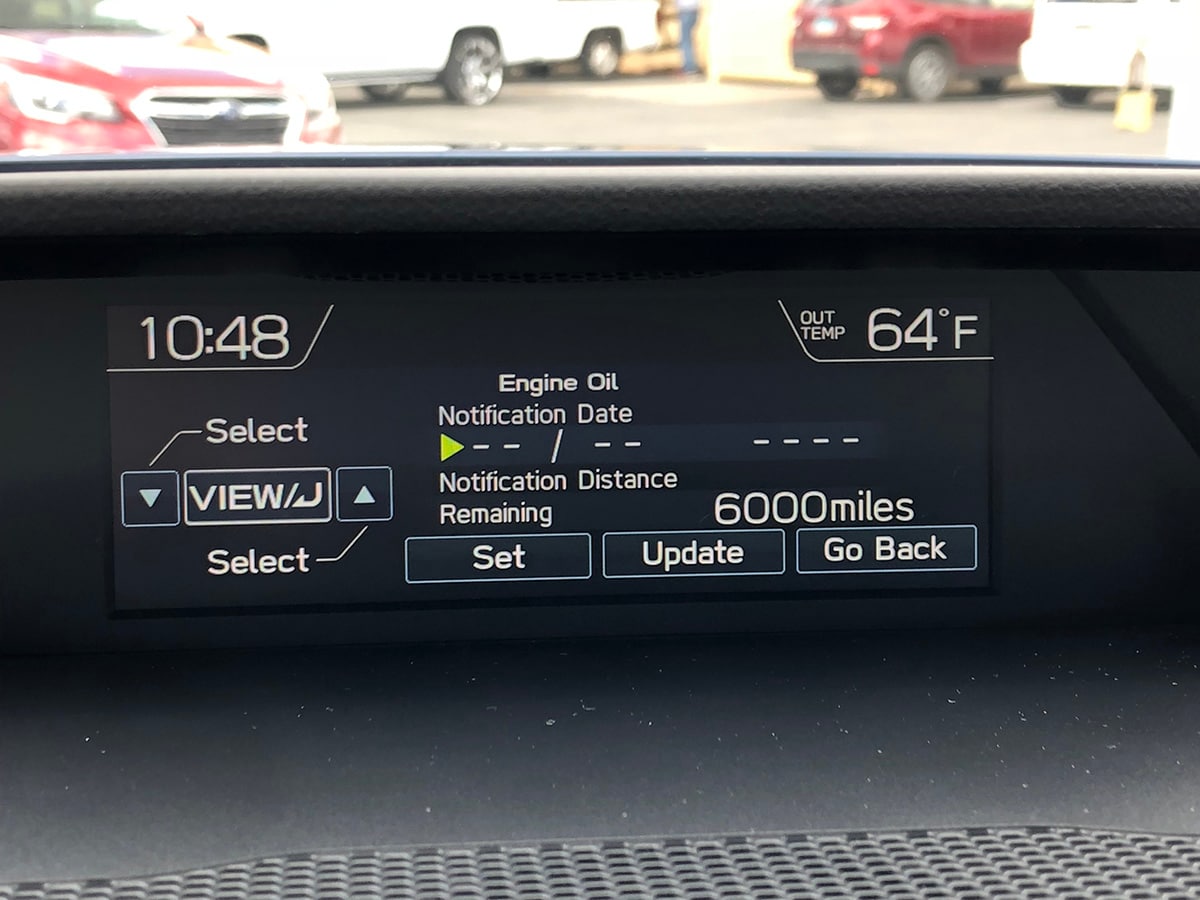
Checking Your Service Reminder
By Allyson Harwood on May 31, 2019
Price: $45,670 | Price yours
Current Odometer: 10,734 miles
Latest MPG: 19.75
Lifetime MPG: 19.01
Maintenance/Service Costs: None
Time out of Service: 0 days
I wish I could say “the dog ate it” or “I left it in my other suit,” but this one is totally on me. I have been in charge of long-term vehicles before, and have spent plenty of time in our current long-term fleet, and every time I was in one of those cars and a “Service Due” indicator would come up on the screen, I would tell the person in charge of the vehicle that the car was ready for a trip to the dealer. And if it was the vehicle I was in charge of, I’d set up the trip to the dealer ASAP.
Our long-term 2019 Subaru Ascent passed the 10,000-mile mark, and I hadn’t seen a service reminder come up on the driver information screen. When the miles were in the 9,000 range, I thought this was an SUV that didn’t require an oil change until 10,000 miles, so I didn’t worry about it. Then it passed 10K — and nothing. No notification. A vehicle this new has to have that as part of the system, doesn’t it?
After a quick Google search, the answer is yes. A phone call to the local dealership confirmed that the Ascent should’ve gone in at about 6,000 or 7,000 miles. And I should have known that.
RELATED: What to look for when taking your car in for maintenance
Here’s what happened. If we had taken delivery of our long-term Ascent through a dealership, it would’ve gone through the pre-delivery checklist, which includes the dealership setting the reminder. So, even though this is likely not going to happen to you, here’s how you can make sure your maintenance reminder has been set:
Look at the small screen at the top of the dashboard, above the larger screen in the center of the dash. Use the up or down arrow to scroll, until you see a screen that reads, “Press and hold [VIEW] button to access settings screen.” Once you do that, you’ll see a menu that you can toggle through. This is where you can check the engine oil change reminder, as well as the maintenance schedule. If your dealer is like the one I go to, they will set the engine oil change reminder screen, but you can also check the maintenance schedule if you like. As you can see, the engine oil change reminder wasn’t set. It’s not anyone’s fault; it’s just one of those things that happened because of how we got our long-termer.
However, now that I know, I’m going to take the Subaru Ascent in for its first service — with no more excuses.
The Family Truckster
By Allyson Harwood on May 2, 2019
Price: $45,670 | Price yours
Current Odometer: 9,912 miles
Latest MPG: 18.22
Lifetime MPG: 18.97
Maintenance/Service Costs: None
Time out of Service: 0 days
My husband and I had family come into town for a week, and during that time, Kelley Blue Book’s trusty long-term 2019 Subaru Ascent was put to work. The week started at Long Beach Airport, where we picked up his father, who had flown in from the East Coast and had spent much of the day on a car ride, a long bus ride, and a cross-country flight. Tired and hungry, he got in the back seat, ready for us to whisk him to our home. He immediately enjoyed the spacious second row and pulled up the sun shades for the side windows. He reclined his seat and settled in.
His trip to SoCal was part relaxing family visit, part tour of the area, and the Ascent was a crucial part of it all. Our first excursion was to the 86-acre South Coast Botanic Garden, and while walking the lush grounds of the Palos Verdes gardens, we happened upon a wedding taking place among the roses. The next day of the whirlwind tour meant a visit to the Aquarium of the Pacific, a terrific facility that rivals that of the famed Monterey Bay Aquarium.
We rested at home for a day, to get ready for the biggest tourist attraction in Southern California: Disneyland. One of our friends came along, so the first and second rows were filled, leaving plenty of room for souvenirs. Everyone on board adjusted their seats and temperatures as they saw fit, and we made our way to Anaheim, enjoying the carpool lane and saving a lot of stress and time.
If you have any concerns about the Subaru’s 4-cylinder engine and its power delivery with passengers on board, there’s nothing to worry about. Even with four of us in the Ascent, acceleration felt just as brisk as it does when I drive it by myself. After a long, entertaining day at Disneyland, we headed home — and I noticed that some of the passengers were comfortable enough in the Ascent to sleep almost all the way back.
And in the blink of an eye, the week was over. It had been a terrific visit, and the 2019 Subaru Ascent was a comfortable, roomy transport that received rave reviews from everyone who rode in it. A week after my father-in-law arrived, we made one more trip to Long Beach Airport, where he boarded a redeye flight home.
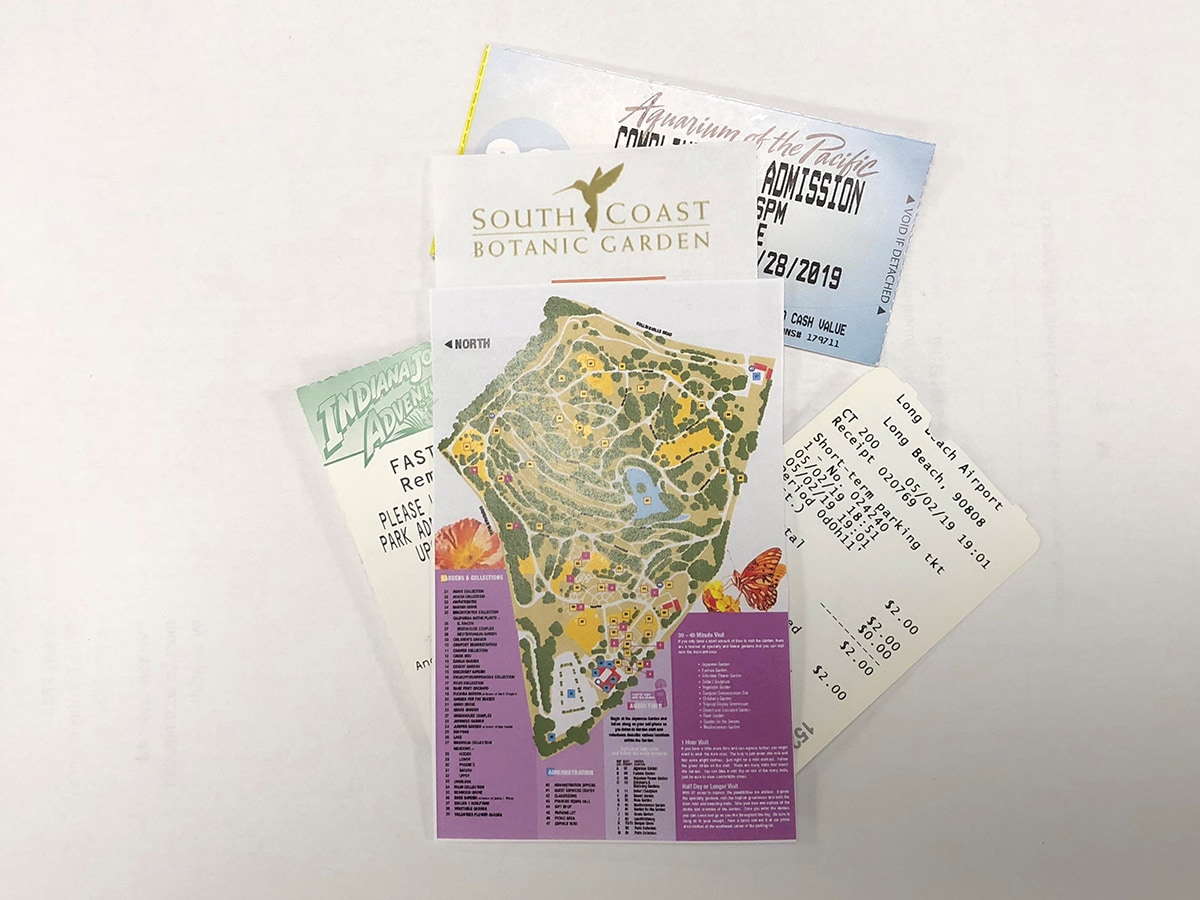
Hauling Breakable Cargo
By Allyson Harwood on April 26, 2019
Price: $45,670 | Price yours
Current Odometer: 9,661 miles
Latest MPG: 18.95
Lifetime MPG: 18.99
Maintenance/Service Costs: None
Time out of Service: 0 days
By looking at this update’s slideshow, you might come to the conclusion that I own a small business that sells a lot of Snapple. That isn’t the case. Actually, my husband drinks Snapple Lemon Tea almost exclusively, and has for as long as I’ve known him. So, it is often up to me, household errand runner and chaperone of a midsize SUV, to buy and deliver said beverage, and that has taught me some interesting things about the cargo area of the Subaru Ascent. (Snapple, if you’re reading this, despite what I am about to write about the risk of glass breaking, I am a long-time buyer of your product and hope you stick with glass bottles. Snapple just tastes better in glass.)
For example, I know that because the cargo area is covered with a thin carpet-like surface and doesn’t have a rubber mat, it’s easiest to keep the Snapple from sliding too far forward by keeping the third row upright. I also know that while there is a lip on the trailing edge of the cargo area where the carpet ends and the plastic edge begins, it isn’t quite tall enough to guarantee that items won’t slide out of the cargo area onto the ground. So, if you hear groceries slide as you drive, just be ready when you open the liftgate, and everything should be fine.
But after a quick stop of a 6-pack of Snapple as it almost slid out of the cargo area, it had finally become time to find another option. I was in the parking lot of the grocery store with a shopping cart full of Snapple and didn’t want to risk breaking any. I started to look around the Ascent to size up my options. I pulled up the cargo floor and saw the storage area where the cargo cover is stowed, as well as a wide inset storage area. There are two straps on the back of the third row of seats that hold the cargo floor up. This looked promising. I put the Snapple into the cubby, and as you can see in the last photo of the slideshow, all seven 6-packs easily fit. Voila! I no longer have to worry about Snapple sliding anywhere.
Lost Presets
by Allyson Harwood on April 2, 2019
Price: $45,670 | Price yours
Current Odometer: 8,313 miles
Latest MPG: 17.90
Lifetime MPG: 18.89
Maintenance/Service Costs: None
Time out of Service: 0 days
It had been a few days since I last drove our long-term 2019 Subaru Ascent, and I noticed something unusual when I decided to listen to Sirius XM satellite radio. My radio station memory presets were gone.
Whether we prefer AM, FM, or satellite radio, we all have our favorite stations, and once we settle into a new car – or one that’s new to us – we set the radio’s memory presets. It has been tradition since this feature became available in the 1930s. Sure, they aren’t hard toggle-type push buttons like they were back then and in some cases, like the Subaru Ascent, they aren’t physical buttons at all. When KBB first took possession of the Ascent, the bottom portion of the stereo’s touch screen was a blank slate: six blank presets on the first page, each numbered, with the word “Hold.” There were three screens set up like this, for a total of 18 presets. (That isn’t 18 presets for XM stations, by the way: it’s 18 total, for AM, FM, and XM.) I set my first six, and that was that for about five months.
But back to today, and my blank screen. I turned the system off and on, switched bands, double-checked that I was on the first preset page, and…nothing changed. I had to reset them.
In the big scheme of things, it’s not that big a deal. It’s more of a nuisance than anything else. But a quick spin around Subaru owner forums, specifically those for the Outback, Forester and Ascent, all of which use similar systems, and many owners have had the same issue. While I know the few stations I preset the first time around and it only took a minute to reenter them, this is something we’re going to keep an eye on.
The Curiosity Factor
by Allyson Harwood on March 18, 2019
Price: $45,670 | Price yours
Current Odometer: 7,478 miles
Latest MPG: 19.79
Lifetime MPG: 18.86
Maintenance/Service Costs: None
Time out of Service: 0 days
Over the first few months of living with the Subaru Ascent, I’ve had several people come up to me in parking lots and at the gas station, asking my opinion of Subaru’s new SUV. People don’t normally approach me while I’m at the gas station, so that took some getting used to, but it has been interesting to see how many people are interested in the Ascent.
One of the recent conversations I had was early on a Monday morning. I was gassing up the Subi before going to work, when a woman pulled up to the pump just behind the Ascent in a BMW 3 Series. While we each waited for the tanks to fill, she walked up and asked what I thought of the Ascent. She mentioned that in person, the Ascent was bigger than she thought, and asked how much space was inside.
There’s nothing like a quick question at a gas station to help crystallize your thoughts on a vehicle, so I summed up how I felt about driving it: I told her I think it’s a comfortable SUV, with plenty of power and a lot of cargo space. The first two rows offer plenty of room, and if there are taller passengers sitting in the third row, you can move the second row forward to create more space in the third row. I said that I like the styling and the interior feels cozy and welcoming. I also like the audio options and Apple CarPlay. Since we were at the gas station, the subject of fuel economy came up. Fuel economy is okay [we’ll go into more detail on this in a future update], but it’s not the best. She seemed happy with what I had to say about the Ascent, finished filling up her sedan, and was on her way.
I feel like the conversations I’ve had over the last few months have been along those same lines: people that are curious about the Ascent, but aren’t quite ready to go to the dealership yet. Without fail, everyone said this Subaru is a larger vehicle than they expected it to be. The most interesting part of this informal study over the past several months is that none of the people who asked me about the Ascent were current Subaru owners. One of Subaru’s goals was to attract new buyers to the brand, and it looks like that strategy may be paying off.
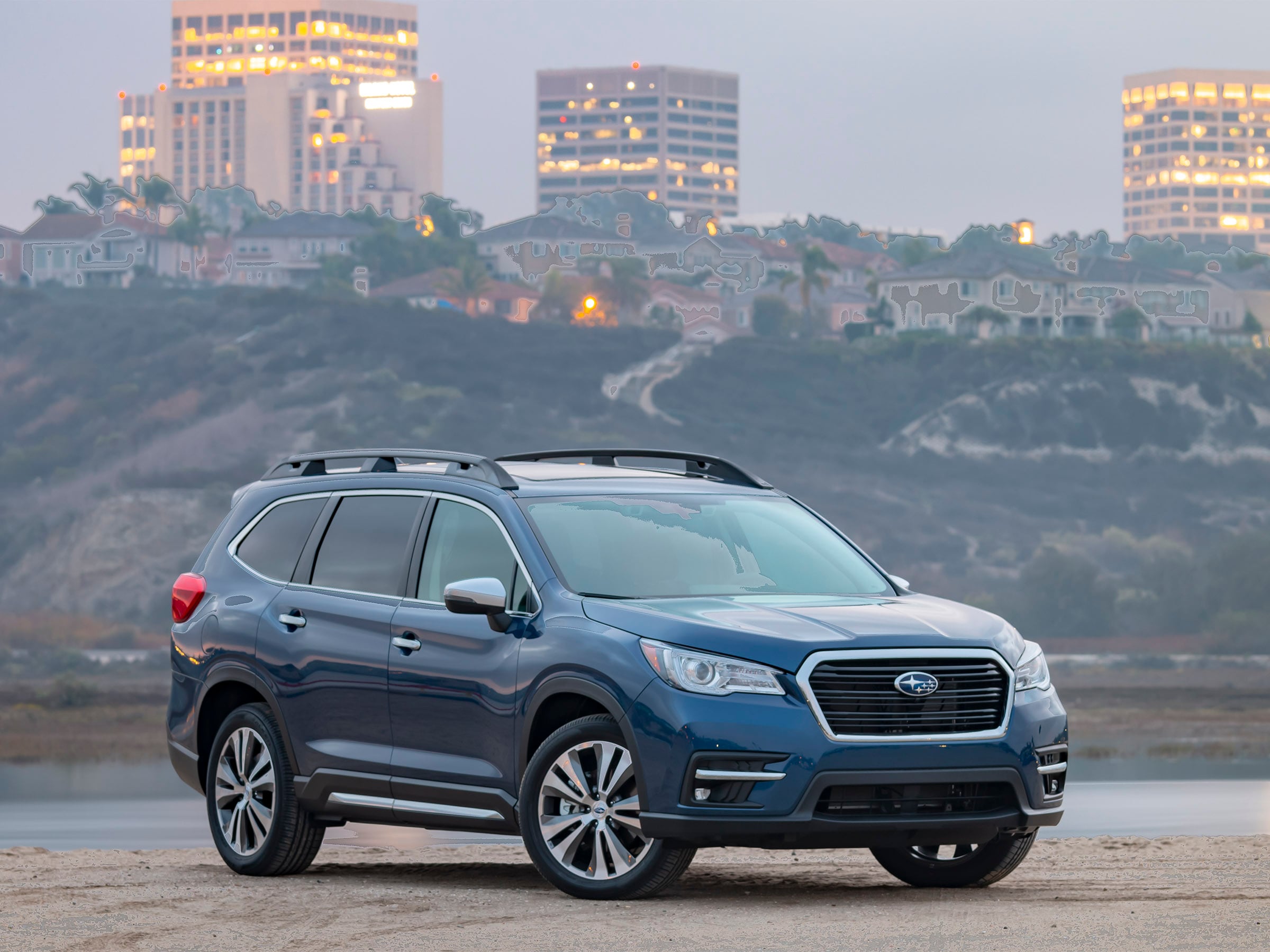
A Visit to New England West
by Allyson Harwood on March 4, 2019
Price: $45,670 | Price yours Current Odometer: 6,541 miles
Latest MPG: 19.21
Lifetime MPG: 18.76
Maintenance/Service Costs: None
Time out of Service: 0 days
For Christmas last year, I bought my husband tickets to see the Boston Bruins, his favorite hockey team, play the Vegas Golden Knights at T-Mobile Arena. For months, we had planned to drive up and spend a few days enjoying the pleasant weather, tasty buffets, and inevitable quality people-watching that Las Vegas provides. It’s about a 4-hour drive from Los Angeles, and I was looking forward to getting our long-term Subaru Ascent on the highway to stretch its legs.
But things began to change. When I stopped in Victorville to fill the Ascent’s gas tank, it was cold outside. And windy. But denial set in, and I figured this part of California was dealing with some chilly weather and Vegas would offer 60- to 70-degree temperatures, as it always does this time of year. As we continued north on Interstate 15, the sky became dark and ominous, and it was early afternoon. Uh oh.
The exterior temperature reading continued to drop. I was even happier that we took the Ascent, as the seat heaters and heated steering wheel kept everything nice and toasty on the drive.
We got to the hotel and had enough time for my husband to put on his Bruins jersey before we Lyfted to T-Mobile. At the arena, the front entrance was dominated by Bruins fans. Between that and the unusually cold weather, it seemed that when the Bruins came to Las Vegas, they brought New England with them.
The New England theme continued inside, where we were surrounded by more Bruins fans, and some who were fans of Massachusetts sports in general. Then after the game (which the Bruins won in the shootout), we walked outside into snow – that’s right, it snowed in Las Vegas and it was almost spring — and from what we heard from locals, that snow was sticking in other parts of town.
The next day, it was too cold to walk along the Strip, so we went over to a nearby shopping area for lunch, and what did we have? A couple of lobster rolls, the unofficial sandwich of New England. Seriously? Will I also end up watching “Good Will Hunting” on this trip? Is Larry Bird going to stop by and say hello?
The temperature never climbed out of the 40s while we were there, staying mostly in the 30s. We never got to enjoy warm weather in Vegas, and it was time to head home. The Ascent’s adaptive cruise control worked flawlessly, and I used it the entire time we were on the highway going there and back. It was very easy to adjust the distance I wanted the Ascent to be from the vehicle ahead, and I took advantage of the SUV’s power and the features of the ACC system to easily pass big trucks and slower vehicles. Between the use of the ACC and the time out on the wide-open highway, the Ascent netted its best fuel economy to date: 22.31 mpg on one of the tanks of gas, and 30.7 instant mpg.
It turned out the Subaru Ascent was the perfect vehicle for this trip, as Subaru is one of the most popular brands in New England. How popular? If you’ve ever been to the area, there are times when it seems like every other car on the road is a Subaru. Michael Carr, Vice President of Sales for Subaru of New England, backs that up, explaining that while Subaru is the seventh best-selling brand in the U.S., it is the third best-selling brand in New England and has been a household name there for decades. And the introduction of the Ascent is already increasing Subaru’s sales, especially in New England.
What Ascent says about Subaru
by Matt DeLorenzo on Feb. 27, 2019
Price: $45,670 | Price yours
Current Odometer: 5,289 miles
Latest MPG: 18.4
Lifetime MPG: 17.7
Maintenance/Service Costs: None
Time out of Service: 0 days
Spending time with a long-term test vehicle not only reveals a lot about the product, but also speaks volumes to where its manufacturer is headed with future product. Our 2019 Subaru Ascent is a perfect case in point.
There’s no arguing with Subaru’s success. However, when evaluating its vehicles, we would usually offer a few caveats. By and large, the lineup boasts outstanding features, like the ubiquity of all-wheel drive, great dependability, solid resale value and low operating costs. But we also were cognizant of shortcomings vis a vis their larger Japanese competitors—things like a tinny sound when you’d the slam door or the ever-present hard plastic surfaces on the interior.
Not so with the Ascent. This is one solid vehicle that is well-appointed, has great styling and having seen the interior of the next generation Legacy, points toward the direction Subaru is headed when it comes to paying attention to the little details that can make a difference in a highly competitive market.
Feels like home
Getting behind the wheel of our Ascent feels like slipping into a comfortable chair at home. The supportive, yet plush, leather seats are welcoming and reassuring, as is the solid thunk when you close the door. I really like the patterned floor mats that look more like homey throw rugs, a detail that reminds you that this is no ordinary crossover.
There are also plenty of soft-touch materials and very little in the way of hard plastics. As someone who appreciates redundant controls instead of solely relying on a touch screen to access various systems ranging from HVAC to infotainment, I found the Ascent’s interface intuitive, which makes it that much easier to drive.
Advances in Subaru’s continuously variable transmission also make it less noticeable and is further reassurance that the company is committed to ongoing refinement of all its products. The Ascent is not only proof that that Subaru is headed in the right direction, but also that it has arrived in offering buyers a complete package with little, if any, compromises.
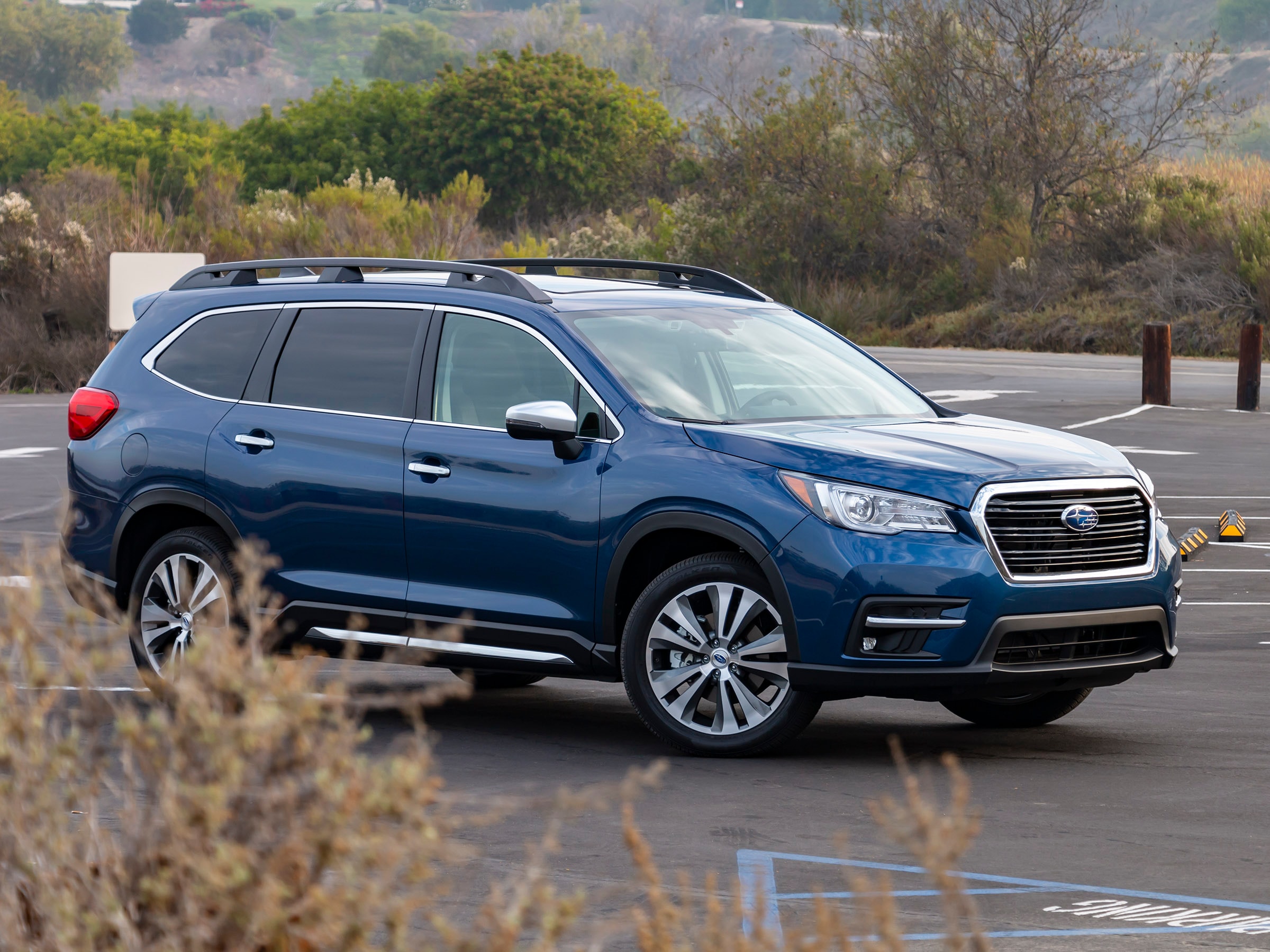
Parking Lot Pros and Cons
by Allyson Harwood on February 13, 2019
Price: $45,670 | Price yours Current Odometer: 3,688 miles Latest MPG: 19.99 Lifetime MPG: 18.81 Maintenance/Service Costs: None Time out of Service: 0 days
Maneuvering through a parking lot, parallel parking on a city street, and parking in a small garage are more challenging in a larger vehicle, such as a midsize SUV. Our long-term 2019 Subaru Ascent has a lot going for it, however, making these daily tasks easier.
Excellent Visibility
One of the Ascent’s many strong suits is its excellent visibility. A large windshield, as well as large side windows with slender small A-, B-, and C-pillars, make is easy to take a quick inventory of your surroundings. Even the body-color D-pillar is relatively narrow. The Ascent’s side mirrors cover a generous amount of area on either side, and the blind-spot monitors with rear cross-traffic alert, standard on all but the base model, do an excellent job of letting you know when nearby vehicles aren’t in plain view. In addition, our tester has the optional digital rearview mirror, which Subaru calls the Smart Rear-View Mirror. Even when the Subaru’s interior is filled with extremely tall people, or that bouquet of balloons you have to get to your nephew’s birthday party before he has a total meltdown, you can pull the toggle at the bottom of the mirror and activate the camera that’s mounted to the back of the Ascent, giving you a balloon-free view of what’s behind the vehicle.
One member of the KBB editorial team was especially impressed with the front 180-degree camera, which uses the upper display on the dash. (The standard rear-view camera uses the lower display.) He said the “front camera proved super useful having to pull very close to protective poles to fit in a tight garage.” That camera comes in very handy when approaching a tall curb that doesn’t have a concrete parking stop to keep you from hitting the curb. While you pull into a space, it can also show you small obstacles in front of the Ascent, which can be especially helpful if there’s a sharp object there that could puncture a tire.
Wish List
As good as the visibility is in the Ascent, there are still a couple of features we’d like to see added to the Subaru’s roster that would be especially useful when parking at a shopping center. First is tilting side mirrors. This may seem like a minor feature, but when you’re trying to get a midsize vehicle into a less-than-generous-size parking space, it’s nice to be able to see the painted lines on either side. Another feature, one that’s starting to become more prevalent in SUVs, is the overhead or birds-eye 360-degree surround-view camera. This system is a more complicated upgrade, because it uses multiple vehicle cameras to create an image of what’s around the vehicle. It’s a simulated top-down view that is surprisingly accurate.
Power Delivery
by Allyson Harwood on January 31, 2019
Price: $45,670 | Price yours
Current Odometer: 2,814 miles
Latest MPG: 17.02
Lifetime MPG: 18.84
Maintenance/Service Costs: None
Time out of Service: 0 days
The Subaru Ascent only comes with one powertrain combination: a 260-horsepower, 2.4-liter turbocharged flat-4 engine, which is mated to an 8-step continuously variable automatic transmission that features a manual sequential mode with paddle shifters (standard on every trim level). All Ascents also have all-wheel drive. While other competitors, notably the VW Atlas and Honda Pilot, offer V6 engines, there’s no need for concern about power coming from this 4-cylinder engine: it has plenty of juice to easily get the Ascent up to speed. Acceleration from a stop is very quick, and the paddle shifters make it fun to drive the Ascent more aggressively. It’s not a high-performance SUV, but it sure is sporty. And, even though it’s a turbocharged engine, no one on the Kelley Blue Book editorial staff has noted any complaints about turbo lag, and from our evaluation so far, it isn’t an issue.
More refinement, please
There is, however, room for refinement. After that initial acceleration, power delivery becomes somewhat uneven, which could likely be smoothed out with revised transmission programming. And there have been occasions when the Ascent’s CVT would “shift” earlier or later than you would expect. (This type of transmission doesn’t have individual gears like a traditional automatic or manual transmission, so it never actually shifts. Instead, it uses a chain and pulleys, and has a program that recreates a more natural shift feel.)
You may be asking yourself why an automaker would choose a CVT over a traditional automatic transmission. The biggest advantage is improved fuel economy. Because there aren’t specific gears, a CVT can use the ideal ratio for your specific driving conditions to keep engine revs more constant whether you’re driving up a steep grade, accelerating onto the highway, or cruising at freeway speed. This steady state operation of the powertrain which continuously adapts to driving and road conditions improves efficiency. As we continue to drive the Ascent, we’ll get a sense of its fuel economy, and how it compares to that of other midsize SUVs.
Controls, Buttons and Dials
by Allyson Harwood on January 11, 2019
Price: $45,670 | Price yours
Current Odometer: 657 miles
Latest MPG: 19.09
Lifetime MPG: 20.35
Maintenance/Service Costs: None
Time out of Service: 0 days
You’ve done all the research ahead of time. You’ve decided on the make, model and trim level that you’re interested in. It’s time to go to the dealer and sign on the dotted line. But after hours poring over math and options and finishing the negotiations and paperwork, you get in your brand-new car and go home. That’s when the next stage begins: you settle into daily life with your car, which starts by figuring out where all the controls are. That was the first thing we did with the long-term 2019 Subaru Ascent.
I use the trip to gauge fuel economy, so finding that was important. It’s not a button hidden at the end of a turn-signal stalk or the old-school (yet intuitive) small post in the instrument panel: in this case, it’s a push button on the dash, to the left of the steering wheel. Memory seat buttons are on the driver-side door, and the power windows, door locks and side mirror adjustment knob are clustered together near the top of the armrest. So far, so good. Easy to reach, easy to use. To the left of the steering wheel is a bank of controls where you can open the power liftgate, adjust how high it opens, and turn off the Ascent’s traction control if you want.
Sometimes in the new-car frenzy, you forget which goodies your vehicle came with. I remembered that the Ascent had nav and Apple CarPlay…but does it have a CD player for old-school audio listening? Yes! Also handy for old-school audio: the aux jack that’s next to the dual USB ports in the bottom of the center console. And the steering-wheel mounted volume control is an easy-to-use toggle switch. You can tell by feel which one it is, so you don’t have to look down, which reduces driver distraction.
I like to drive with cool air on my face and the seat heater on, and fortunately controls for both are just as easy to get to as reaching over to the center stack. The seats can also be cooled, and the steering wheel heater is on the wheel on the right side.
The only tricky control to find was the one that temporarily deactivates the lane-departure warning system. This is only really an issue when you’re going through a construction area where the lanes aren’t well defined, causing the system to beep. That button is above the rearview mirror, by the sunroof controls. (And a note about the rearview mirror: our long-term Ascent has the digital rearview mirror, which you turn on by pushing the traditional lever at the base of the mirror.)
So far, the controls are easy to reach and learn, and are arranged logically, making the Ascent an easygoing companion on the daily commute.
Introduction
by Allyson Harwood on December 10, 2018
I will freely admit that I was especially excited when the all-new Subaru Ascent arrived at the KBB offices. Not only is it Subaru’s newest foray into the highly competitive 3-row midsize SUV segment (more on that in a moment), but there’s a special spot in my heart for Subaru in general. My earliest memories of car rides are from the passenger seat of my dad’s little orange 360. That was the first of three Subies we would have during my formative childhood years, and oddly, none of them were wagons. Since then, watching Subaru blossom from a niche company into a mainstream player has been a lot of fun.
With the Ascent, Subaru has its share of challenges to overcome. For starters, the midsize SUV segment is already jam-packed with plenty of appealing choices. Second, the Ascent could either be seen as a vehicle that doesn’t fall in line with what Subaru is about, or for those who remember the not-so-beloved Tribeca (aka B9 Tribeca), the Ascent could be looked at as more of the same. But for Subaru, the Ascent makes a lot of sense. After decades of developing a strong following because of its practical wagons, Subaru had to watch its loyalists go to another brand when they needed 3-row SUVs. Considering nearly 650,000 people bought Subarus in America last year (a number that could be exceeded in 2018), this is a large block of buyers that is not to be taken lightly. If they can keep Subaru buyers in the fold while getting non-Subaru buyers to come over in the process, all the better.
What the Ascent Offers
Subaru’s SUV was designed to have the spirit and some of the driving flair of the company’s smaller models, while offering the features that buyers of 3-row SUVs want. From our initial drive of the Ascent, we felt the company did a good job of bringing together these elements. The Ascent only comes with one engine, but it’s plenty powerful: a 260-horsepower, 2.4-liter turbocharged flat-4 engine, controlled through a continuously variable transmission with a regular PRND shifter plus paddles on the steering wheel. As is the case with all Subaru models except the BRZ, all-wheel drive comes standard. Active Torque Vectoring is also standard. If you want to explore the backcountry, the Ascent offers 8.7 inches of ground clearance, plus X-Mode with hill descent control.
With the 2019 Subaru Ascent, 3-row SUV fans can check several items off the must-have list: 7- or 8-passenger seating, standard 3-zone climate control, wide-opening rear doors, about 48 cubic feet of cargo space behind the second row, and up to a 5,000-lb towing capacity. Bluetooth, Apple CarPlay and Android Auto compatibility are standard, and there is a long list of available options. There are also 19 cupholders on board, plenty for that long road trip.
Subaru is known for safety, and the Ascent comes standard with the EyeSight suite of advanced safety features, including pre-collision braking and throttle management, lane departure warning, and adaptive cruise control. The Ascent was named a 2018 IIHS Top Safety Pick+ (when equipped with the optional steering responsive headlights) and received the “Superior” rating for front crash prevention.
Our Ascent
The Subaru Ascent is available in four trim levels: base, Premium, Limited and Touring. Our Touring model will serve as a test bed for the standard and available features that Subaru offers on this vehicle. None of the extra features had an additional cost above and beyond the price of the Touring model; we didn’t need to order extra packages.
The Ascent Touring has second-row captain’s chairs. Six USB ports plus a 120-volt AC outlet. Power tailgate, panoramic moonroof, and a 14-speaker Harman Kardon surround sound audio system. Interior amenities also include two rows of heated leather seats (ventilated in the front row) – 10-way power adjustable for the driver – heated leather-wrapped steering wheel, heated side mirrors and windshield wipers, and a 180-degree front-view camera. Subaru calls the rearview mirror a Smart Mirror; when you push the bottom tab the entire mirror serves as a video monitor that shows you what is behind you, even if you have large objects (or tall people) in the Ascent blocking your view out back.
Our vehicle also came with reverse automatic braking, which can automatically use the brakes when it detects an object while you’re backing up, as well as blind spot detection and a rear cross-traffic alert. The Touring comes with automatic high beams and steering responsive headlights. We hope that during our year-long evaluation we don’t have to test out the safety features, but it’s comforting to know they’re there.
If you are shopping for a 2019 Subaru Ascent, you’ll discover that pricing starts at $32,970, which includes the $975 destination charge. The prices go up somewhat gradually from there, but when you get to the Touring level, the price is $45,670, the as-tested price of our Abyss Blue Pearl model with a Java Brown interior. But don’t let the price of our tester scare you: that is a typical price for a fully loaded midsize SUV, and you certainly don’t have to get the Touring to get the benefits of an Ascent.
What’s Ahead
We have plenty of questions about what it’s like to live with the Ascent. Does it still have that Subaru feel to it? Is it sporty and practical? Can a Subaru this large still have that rugged, welcoming feel of smaller models? And, most important, can the Ascent cut it when put up against excellent competitors like the Honda Pilot and Toyota Highlander? The Kelley Blue Book editorial team looks forward to answering those questions as we live with the Ascent for the next year.
While I do have a personal history with Subaru mixed with a dash of nostalgia, I don’t think this makes me biased toward the Ascent. Instead, it would be more accurate to say that I look at the Ascent with a critical eye. I’m like the coach of a team that his/her child plays on. I’ll be tough but fair. Be warned, kid. Just because we’re family doesn’t mean you get special treatment when you’re on the field.
More 2019 Subaru Ascent
See full review and pricing information for the 2019 Subaru Ascent or build and price your own to unlock its Fair Purchase Price, 5-Year Cost to Own, and more.
